Europe, Part 1: Autobahn into Paris
— Europe — 17 min read
March 16 - April 3, 2011
Riding in the Old World. I wasn't planning to pass through Europe on my trip and I thought I could go from South America to North Africa directly. However, plans changed with Grimaldi, the shipping company, and now I was in one of the most developed parts of the world. Having ridden through the 'New World' of the Americas, it would be good to see the land of the old colonial powers, especially since I would be heading into Africa, where their legacy is still strong.
Once I got rolling on the ground, I thought this would be a short transit through Europe after collecting my Moroccan visa in Paris and then heading for West Africa. However, the visa rules were very strict and I was refused, unless I applied from my home country. This changed all the plans for Africa and I rerouted the trip, heading to Egypt and the east side of Africa. Due to the waiting game with the Moroccan embassy, applying for a new passport (since I was out of pages) and then updating my carnet de passage for Egypt, I ended up spending more than a month in Paris, catching up on my website and other tasks.
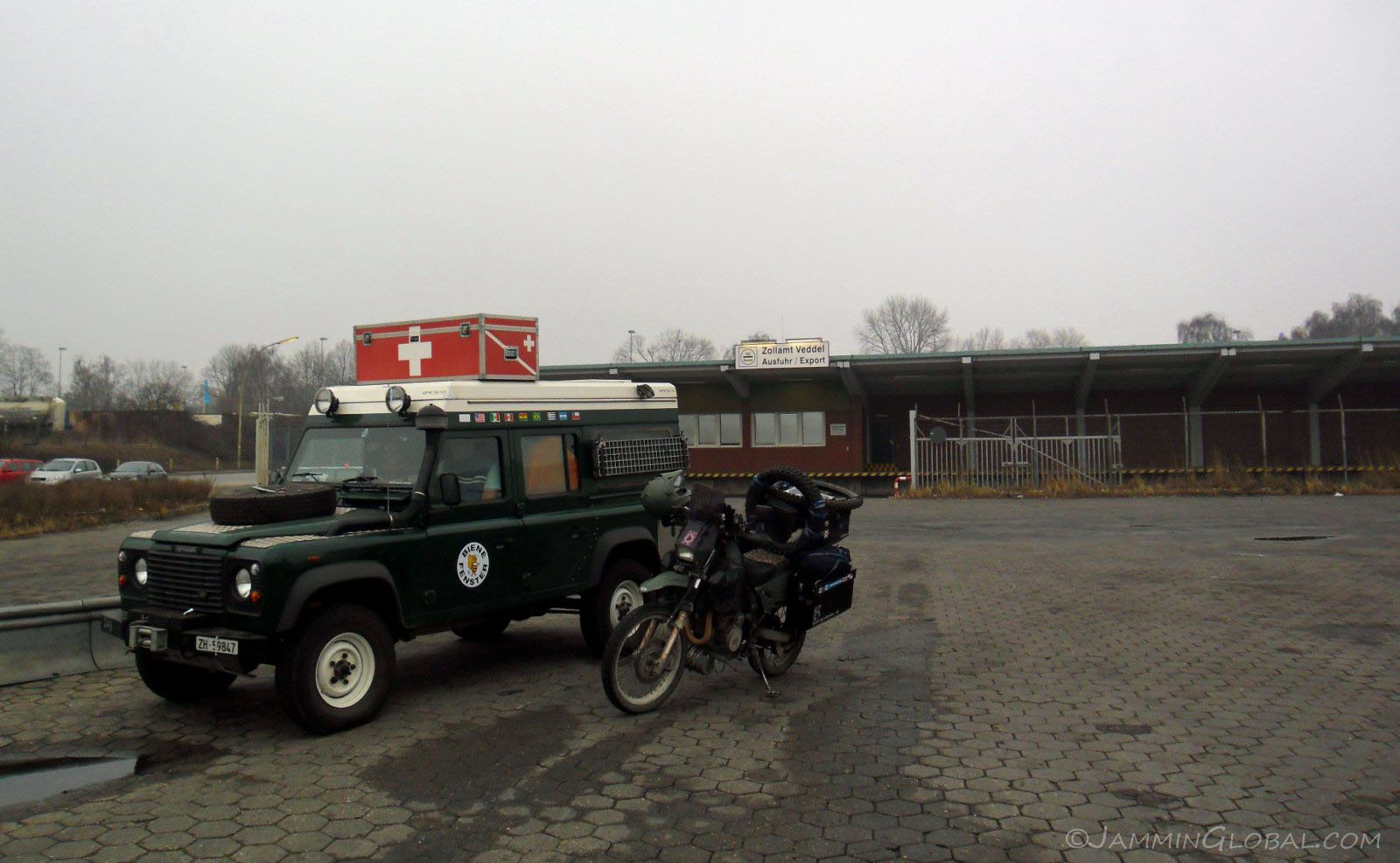
Rolling on the ground on the third continent of this trip. Käthi and Michael in their LandRover Defender traveled with me on the ship from Buenos Aires, after finishing a two year trip through the Americas. They were heading back home to Switzerland and offered to help me get my bearings of riding in Europe, after we got out of the customs area in Hamburg. Surprisingly, we didn't have to do any paperwork for the vehicles. We asked in two different offices in the port and they didn't know what to do with us and just sent us out. I didn't even get a stamp in my passport. What a contrast from traveling through developing countries. They said the big red box on top with the Swiss flag got them waived through a lot of checkpoints, since they were mistaken for a medical vehicle, like the Red Cross, but that's a white cross.
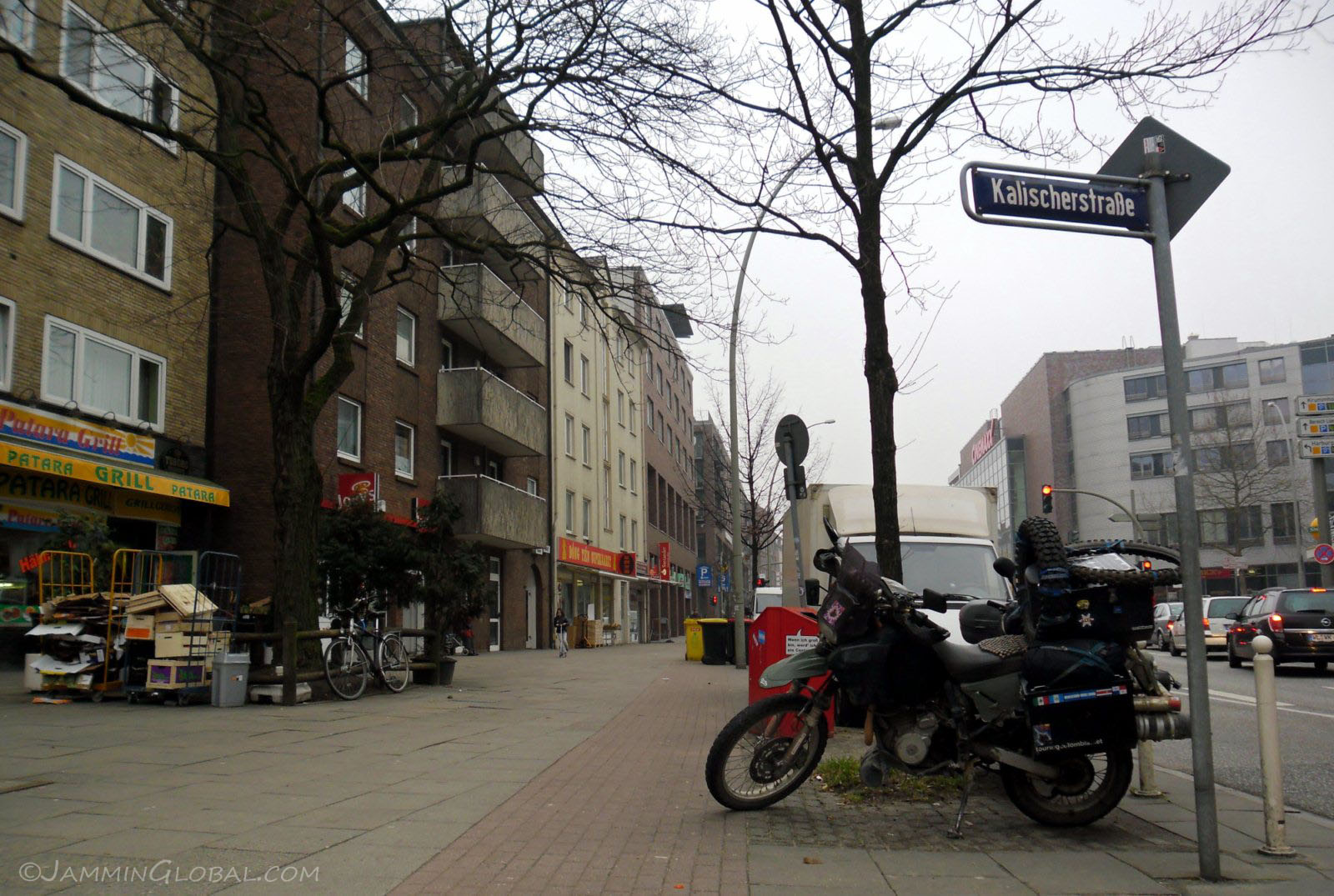
Parking on the sidewalk; I was going to have to get used to the more relaxed approach to two-wheelers in Europe compared to the US.
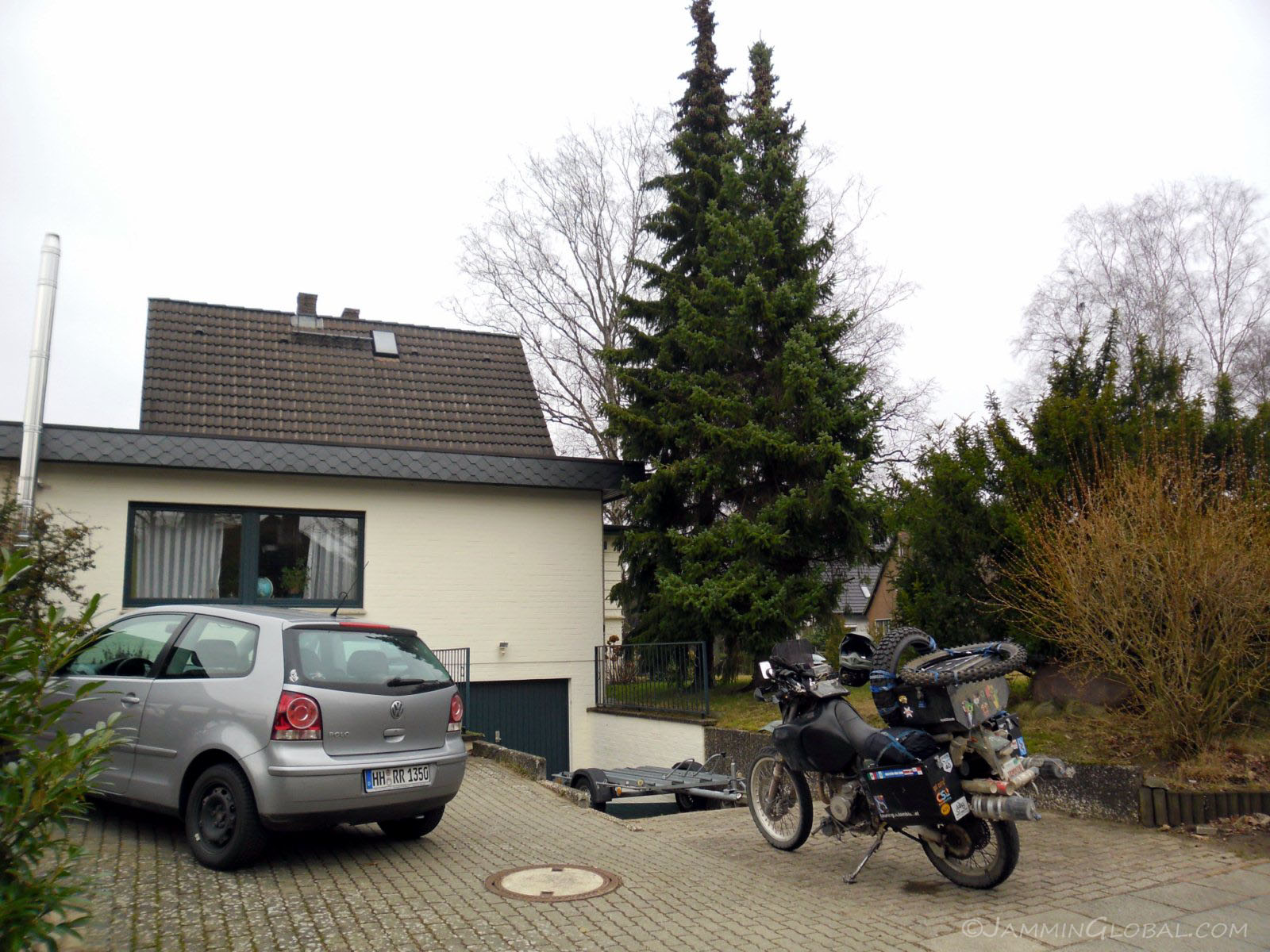
Before I boarded the ship in Buenos Aires, Thomas, a bike traveler from Switzerland who was following my ride report on ADVrider, put me in touch with Michael Happe, who runs the website for a regional motorcycle forum (NordTwin.de), dedicated to enduro riding in northern Germany, and I asked him to help me out in getting some new tires for sanDRina.
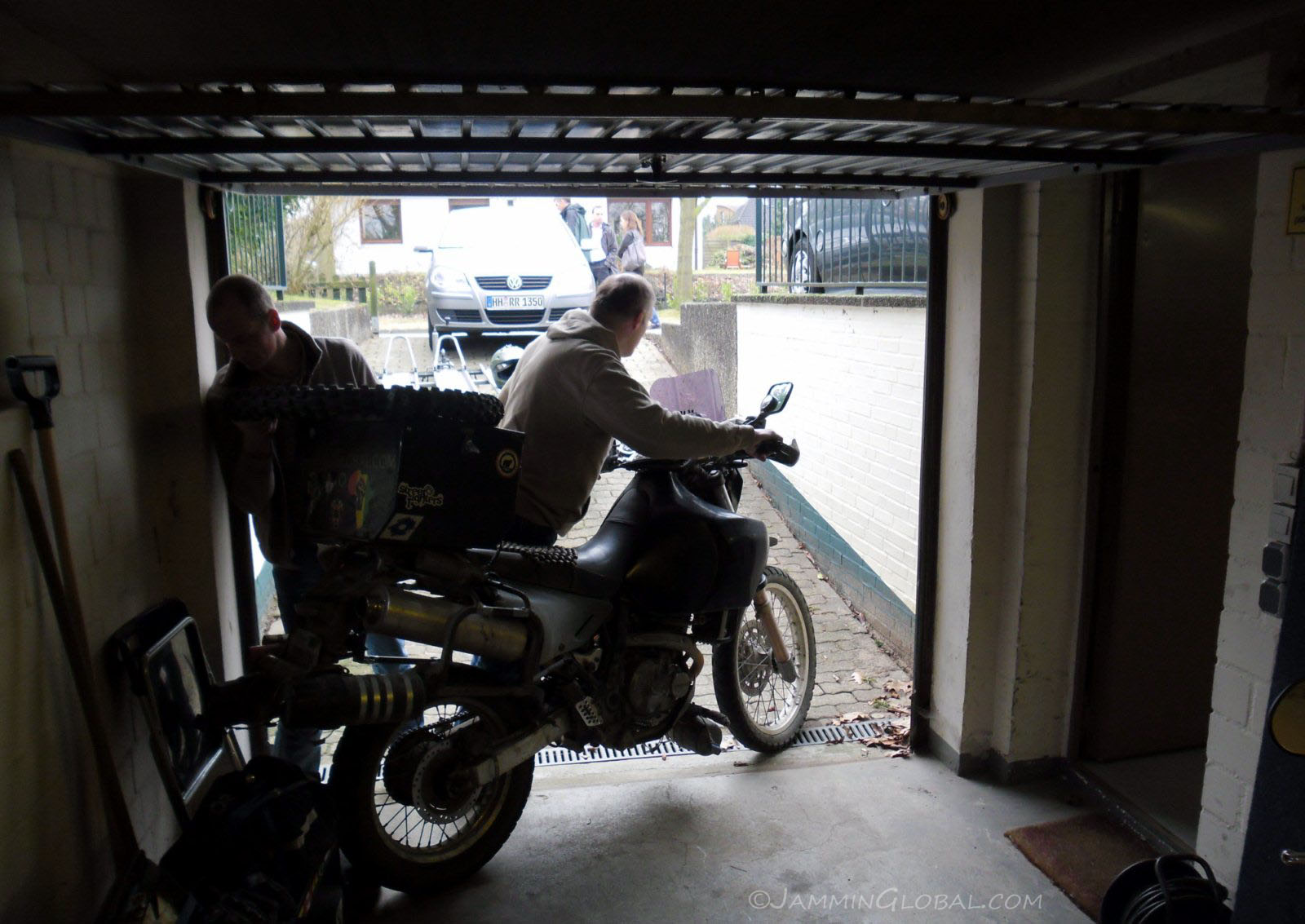
Within a few hours of getting down from the ship, sanDRina was being pushed into Jens' garage. He's a friend of Michael's, who recently opened an online off-road store (Offroad-Kontor.de) and got the tires for me and had all the tools needed.
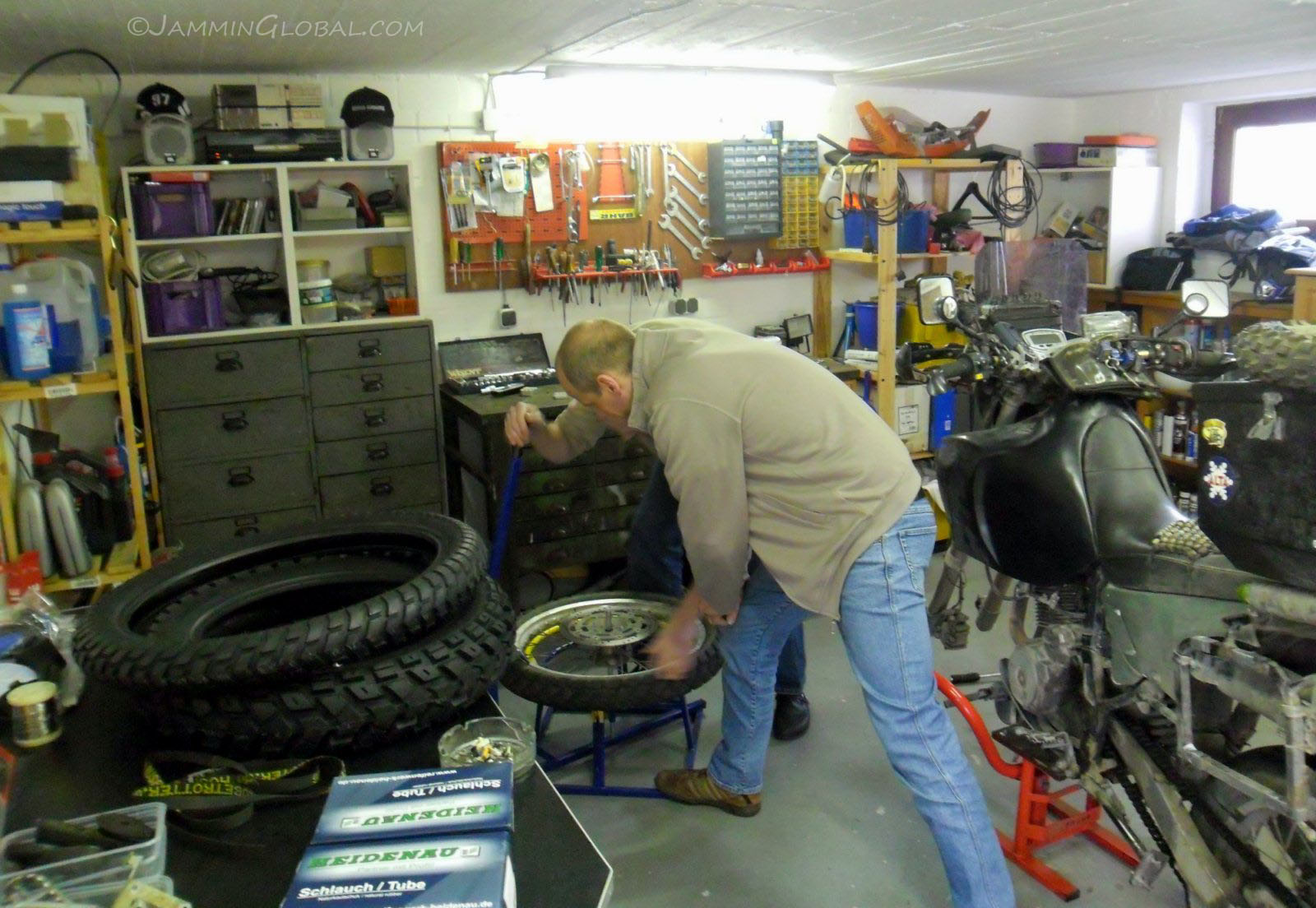
Jens and Michael working the new bead breaker. Jens was happy to put his new equipment through the paces. I ordered the Heidenau Scout K60 tires after reading lots of glowing reviews. Besides the deep 50/50 tread, it's been said to be really long wearing, which would be highly important, considering that getting tires for my kind of bike will be difficult in Africa. I was saving the Kenda K270 that I was carrying from Bolivia for the rough roads expected further into Africa. I mounted the Heidenau here since I knew there would be a lot of tarmac riding coming up and that too at high speeds, to keep up with traffic around Europe, and the Kenda needs to be treated nicely (slow speeds) at the beginning to ensure a long life.
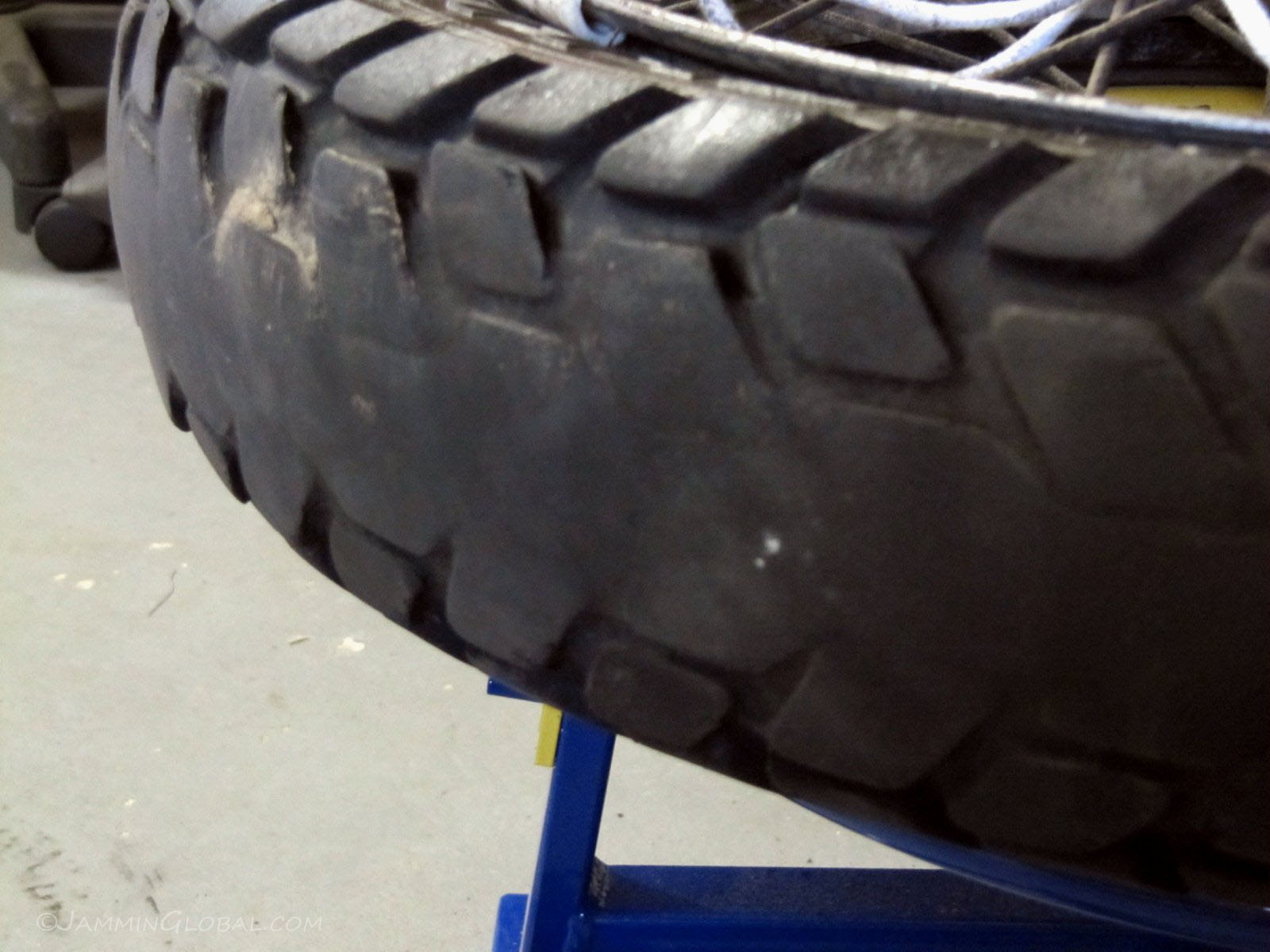
The bald Pirelli MT 60 that was being replaced after 13,000 kms (8,075 mi) of rough riding from Santa Cruz, Bolivia down Ruta 40 to Ushuaia. The tire performed well and is available throughout South America, but it is a bit soft and didn't last as long as I would've liked. However, lots of riding at low pressure over gravel, sand and rocky roads definitely ate into the tire's life.
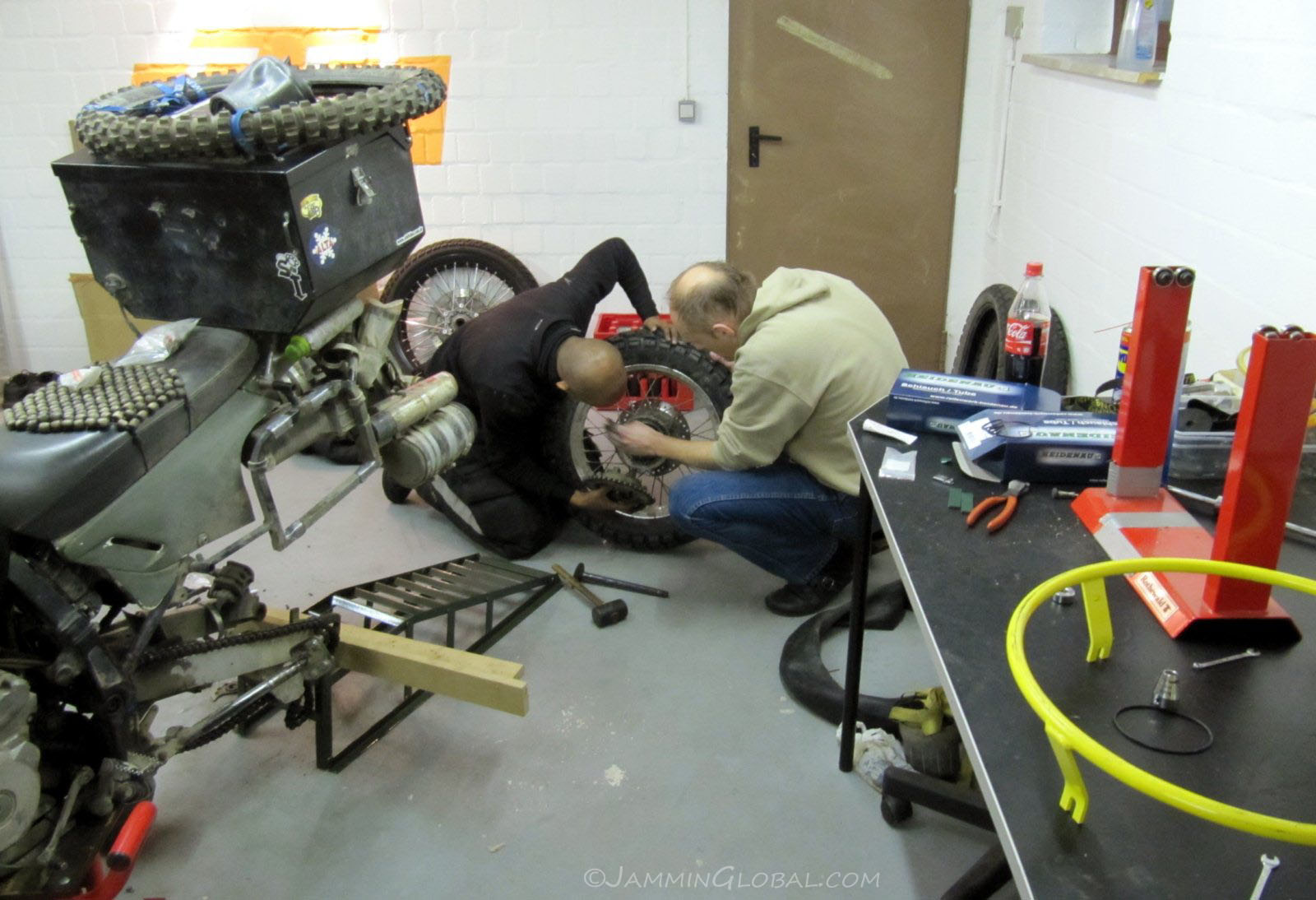
I also replaced the cush drive rubber inserts, which dampen the vibration between the rear sprocket and the wheel. They were rock hard and I think they contributed to my rear wheel bearing failure near Ushuaia.
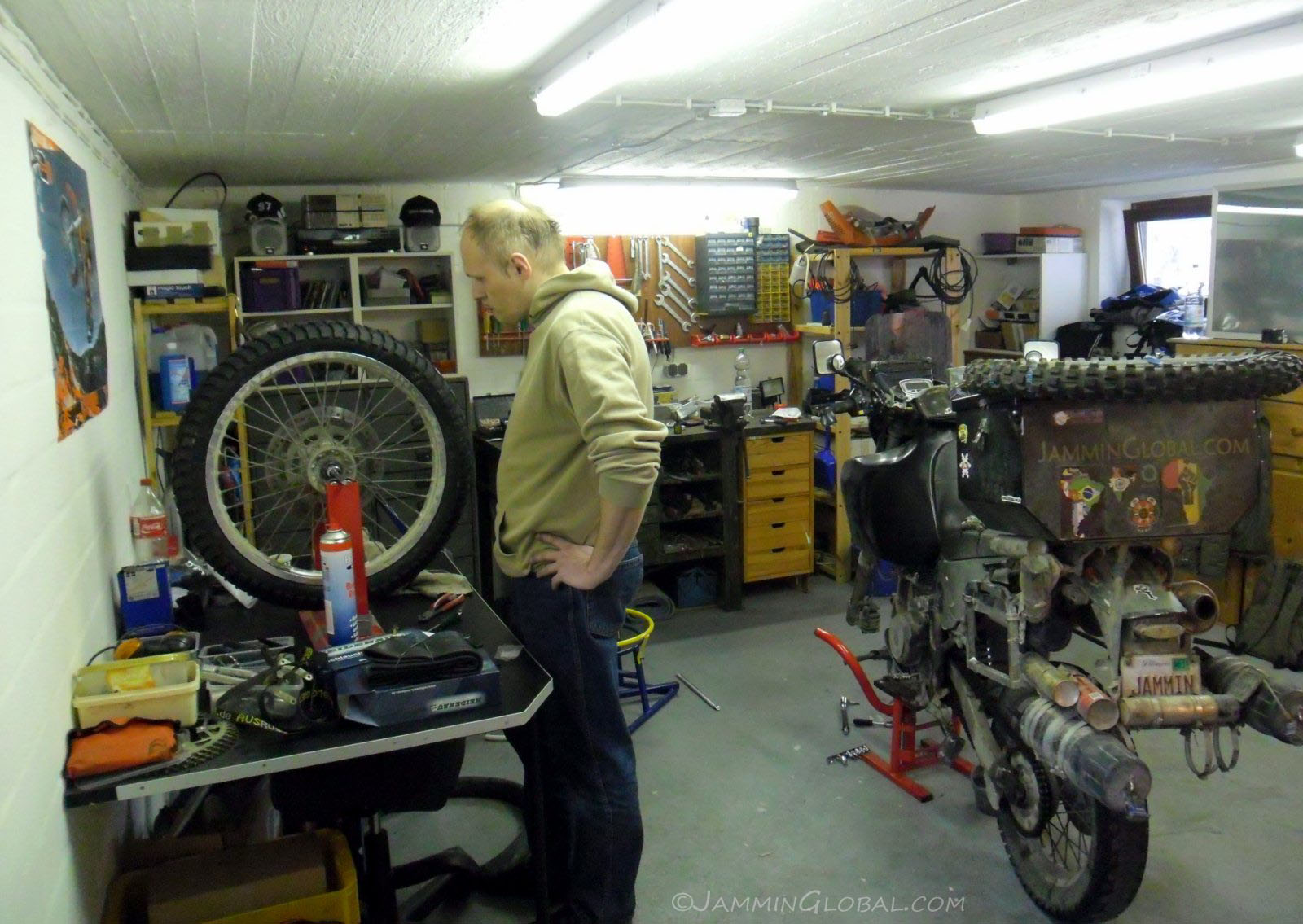
Jens balancing the front wheel, which was a treat for sanDRina, since the wheels have not been balanced since I got the bike. I always made sure to balance the wheels on my previous street bike (GSX-R600), but didn't think it was as important on a dual sport.

Replacing this spacer and dust seal, which got damaged while repairing the first rear wheel bearing failure in Peru. I got all these parts shipped to me in a care package to Buenos Aires (thanks to my sister!).
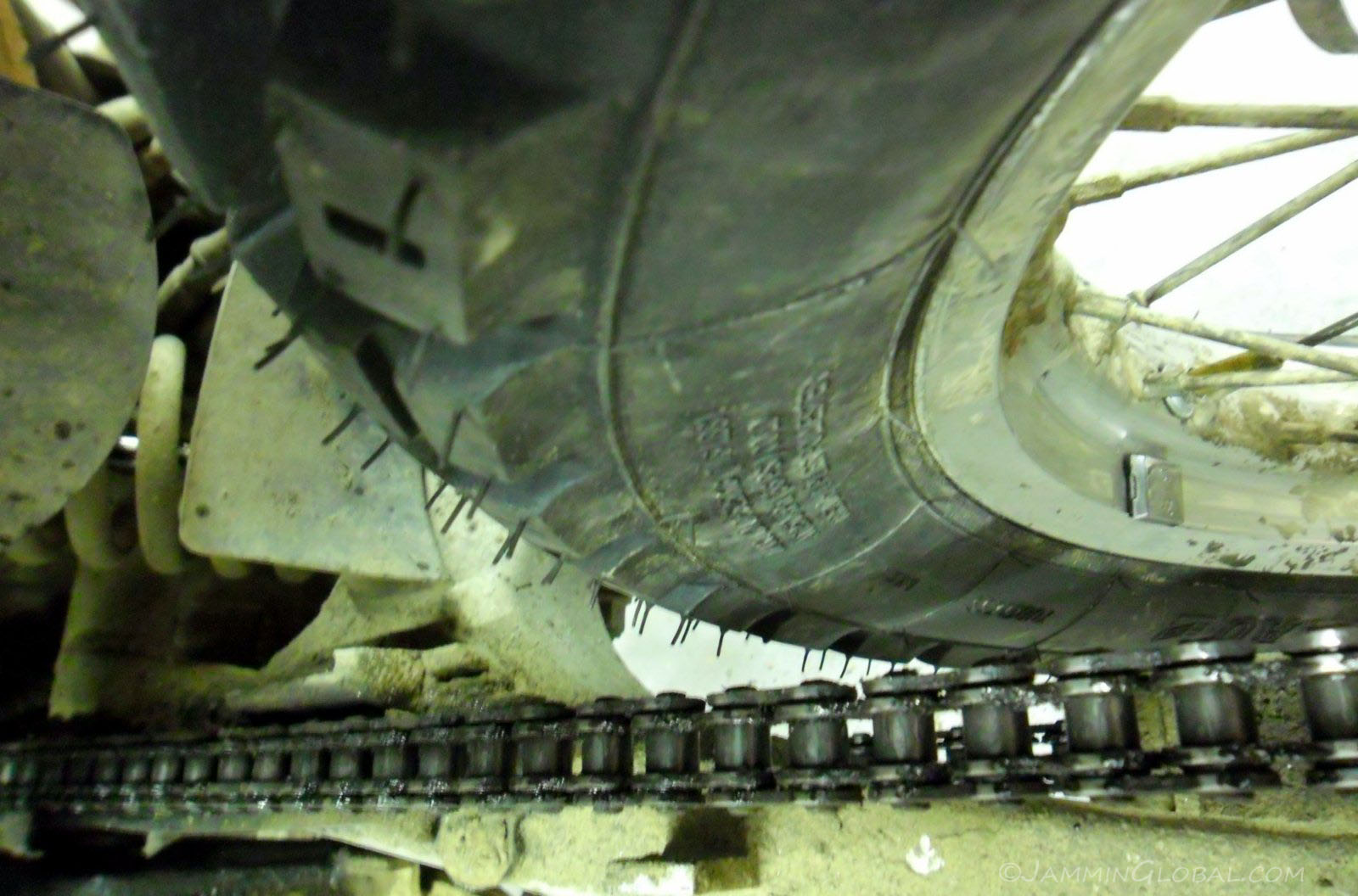
Checking the clearance between the new Heidenau and the swingarm. The stock rear tire on the DR650 is 120 mm wide, but most people run 130 tires. The Heidenau comes in a 130 version, but the tread and compound of this 140 model is far superior and I was glad to see it fit nicely. Let's see if I can get more than 15,000 kms (9,300 mi) from this tire.
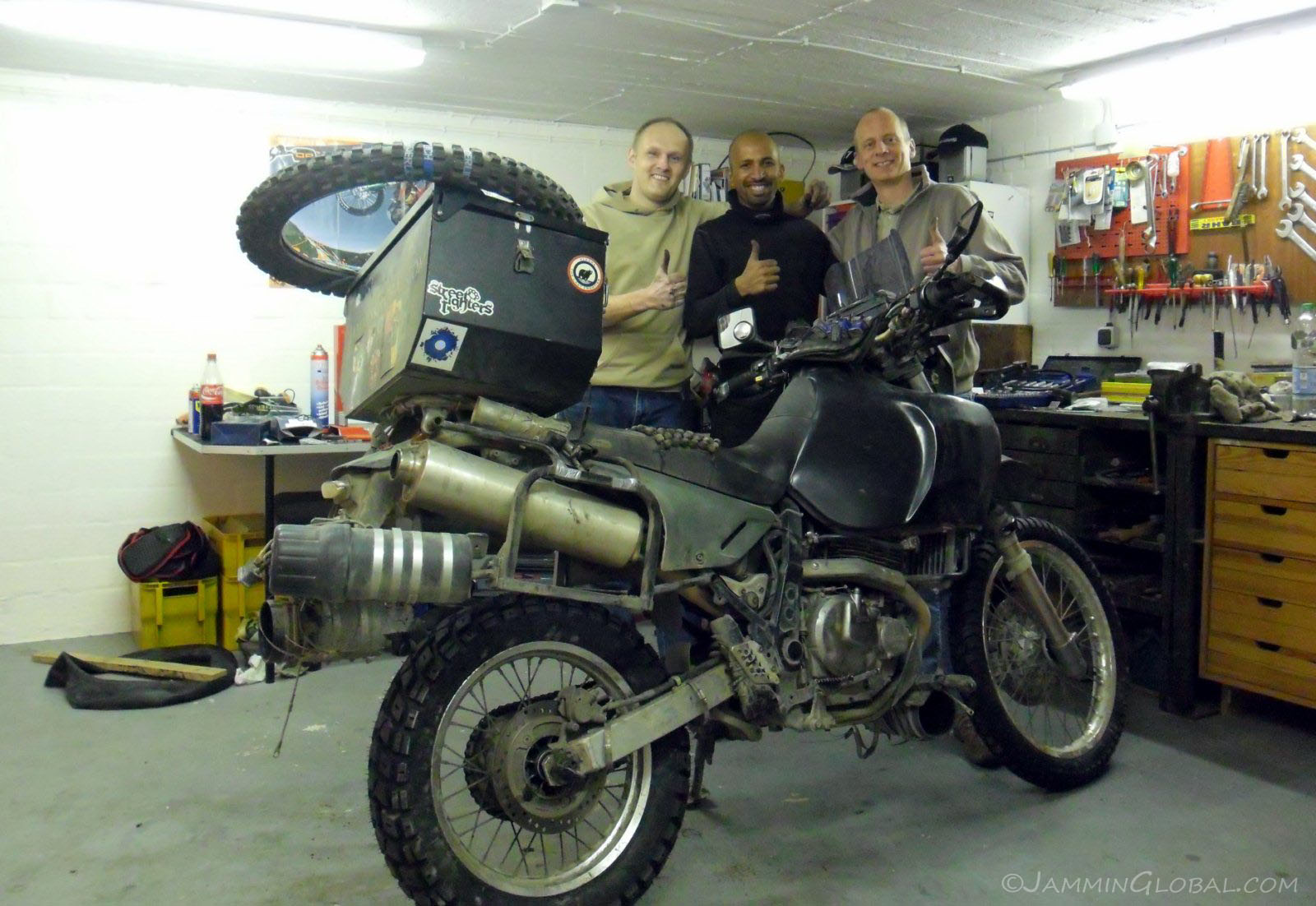
Thanking Jens and Michael for their super help in giving sanDRina some new shoes. It always a pleasure to experience the camaraderie that exists amongst bikers the world over.
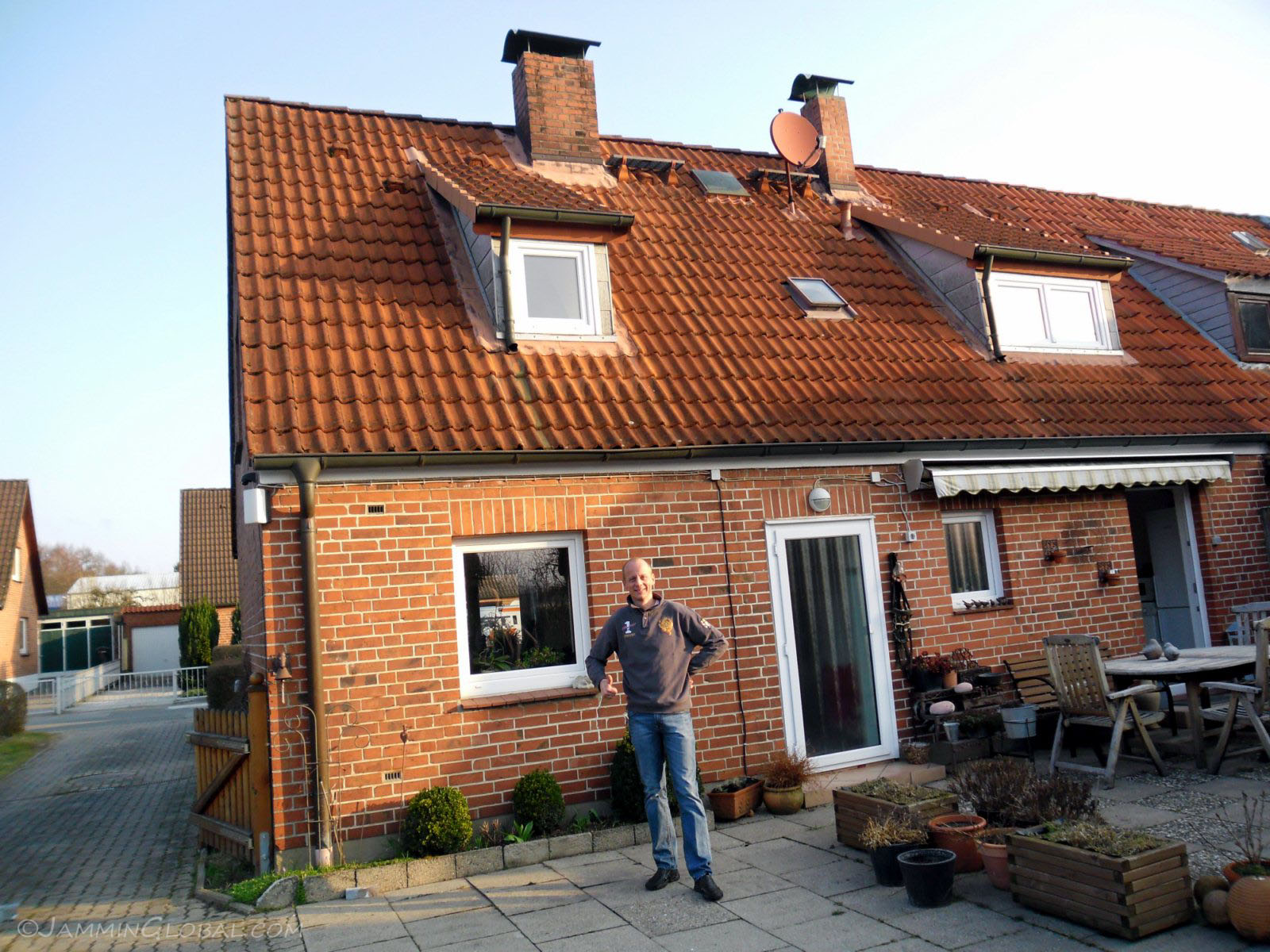
I stayed the night with Michael, who was prepping his Honda Africa Twin in the garage for some enduro riding coming up in Sweden.
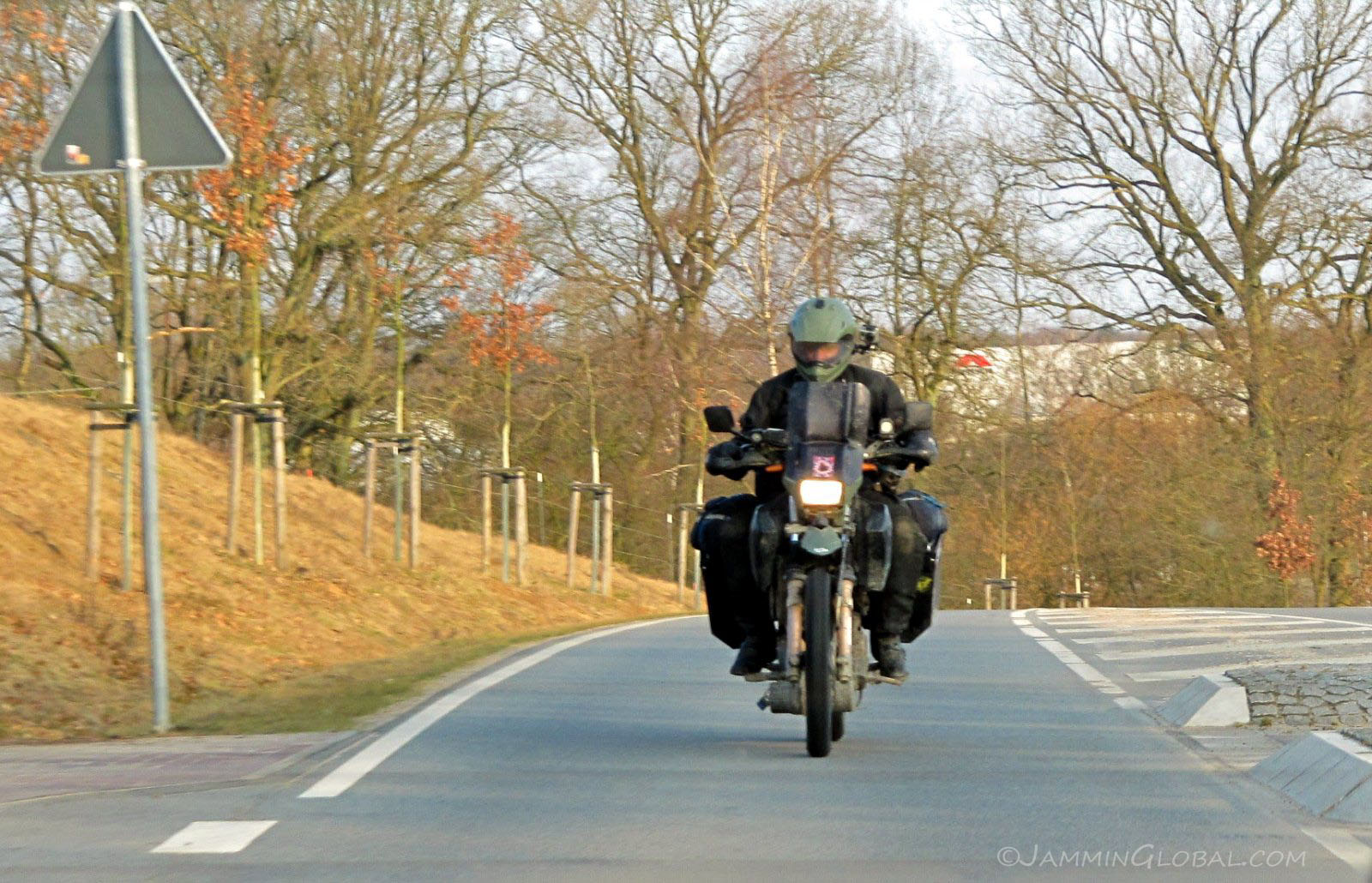
It was very cold in the morning, around 1 C (34 F) as I got rolling towards Paris, 940 kms (584 mi) away. I wanted to get there as soon as possible to figure out my visa for Morocco.
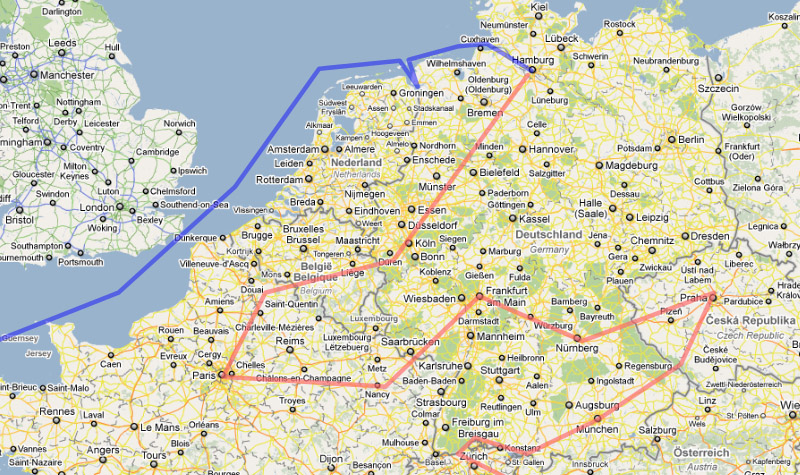
I did the Hamburg to Paris leg in one day, after being on a ship for a month. It was reassuring to see how easily sanDRina and I could switch on and do a high mileage day. Click on it to go to the interactive version in Google Maps.
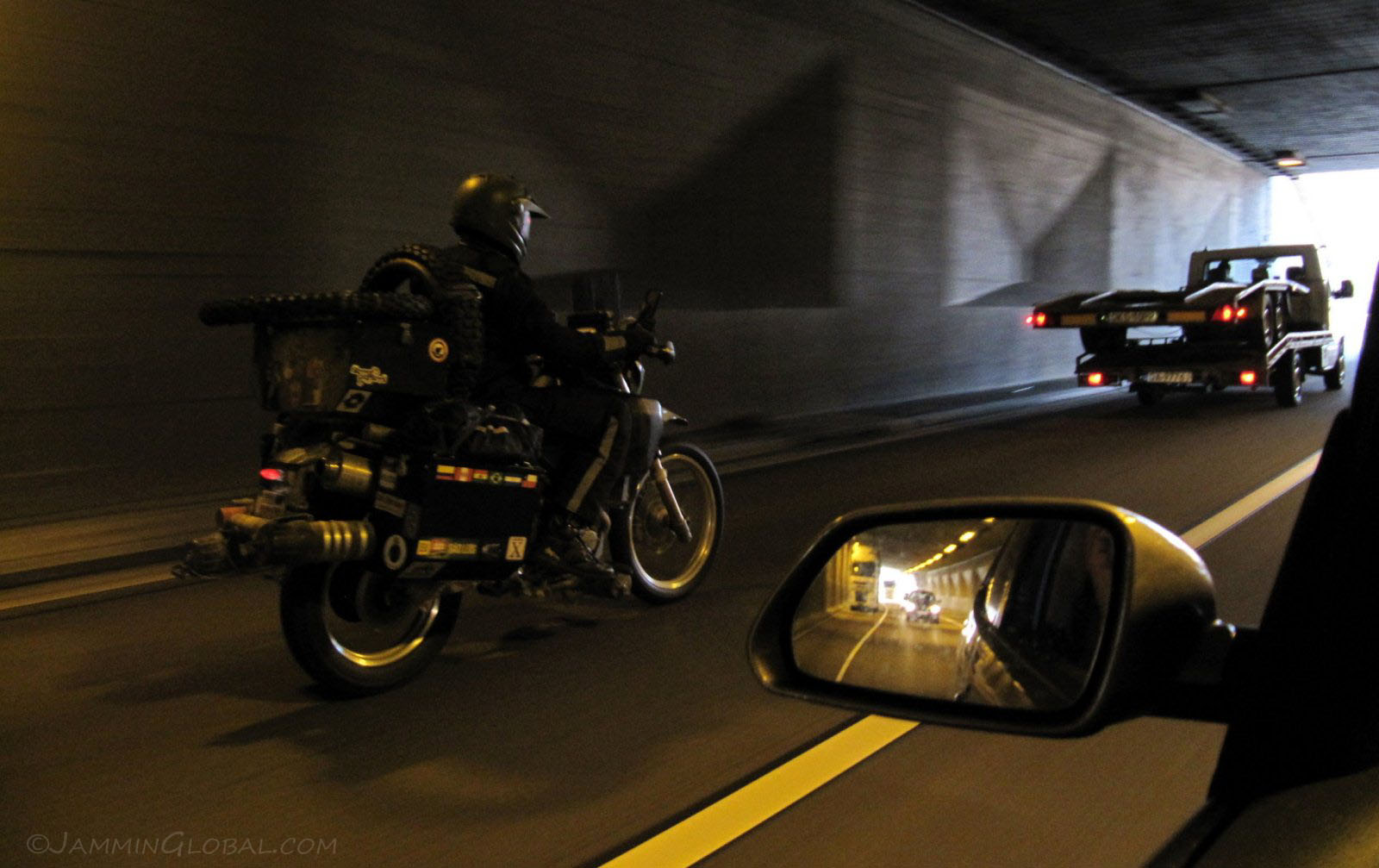
Thanks to Michael who took these nice shots on his way to work after pointing me in the right direction.
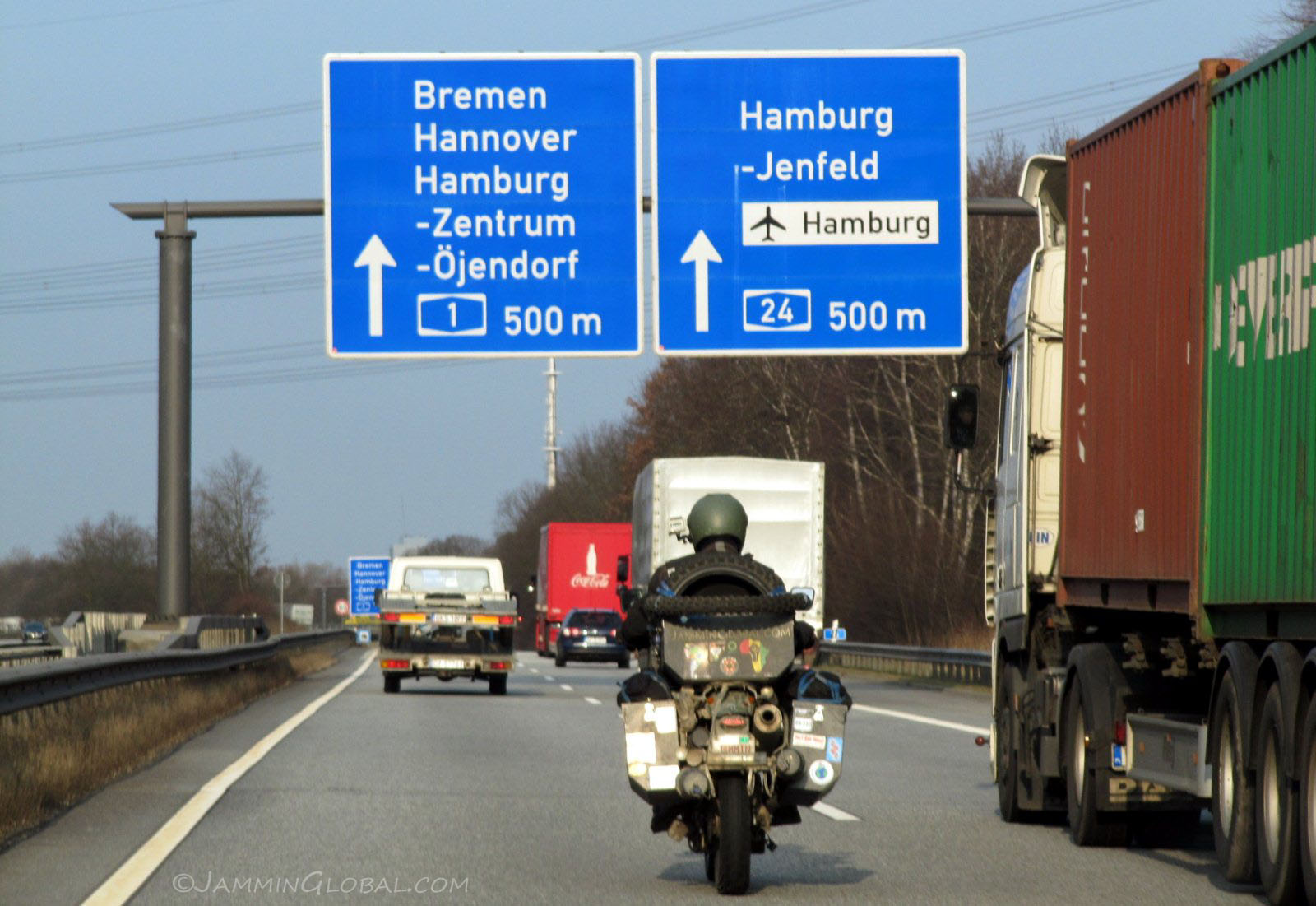
Michael also helped out tremendously by giving me the GPS maps for Europe, which made navigation a breeze in my travels around the continent.
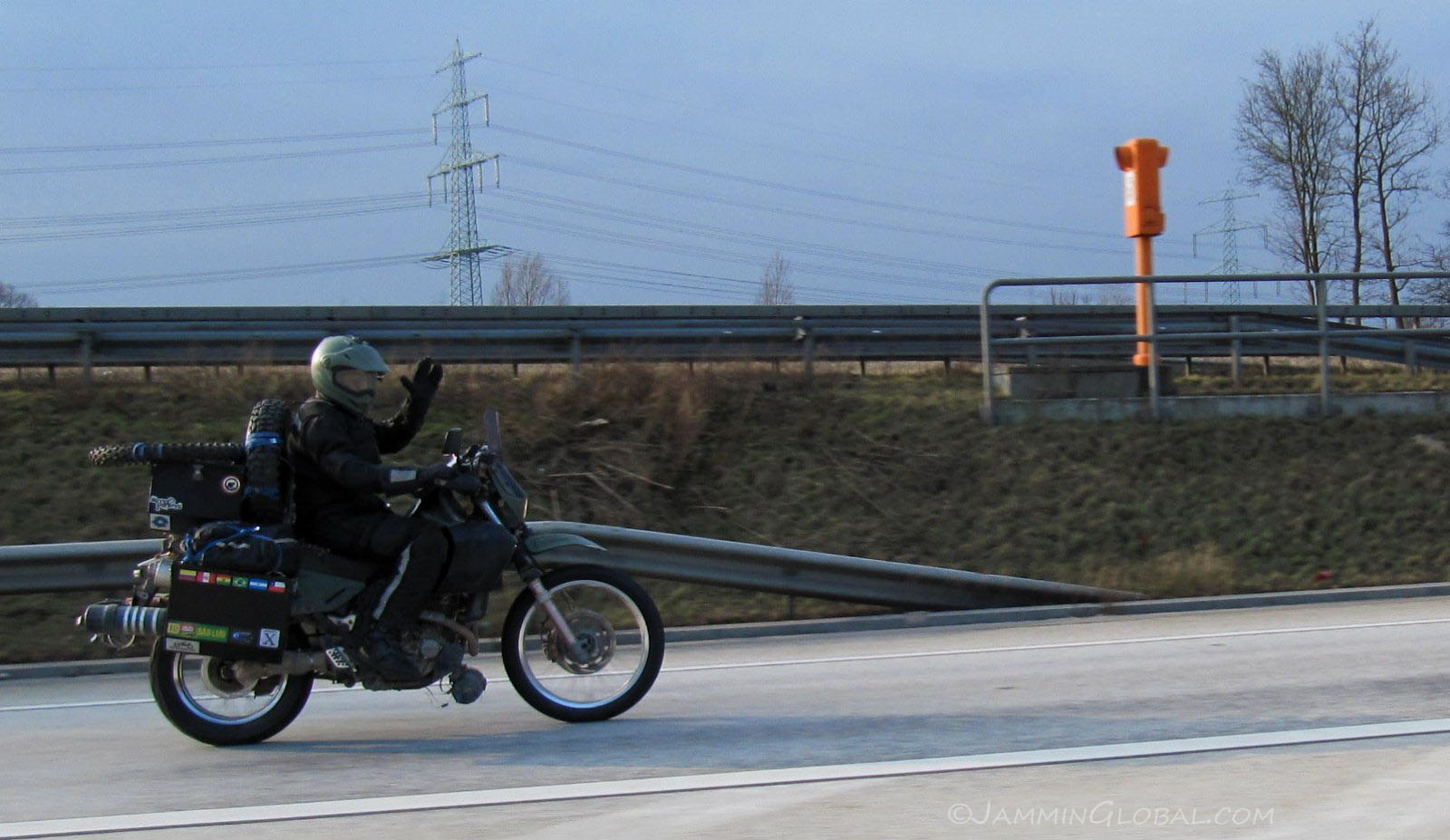
Thanks for the good help, Michael. Onwards to Paris.
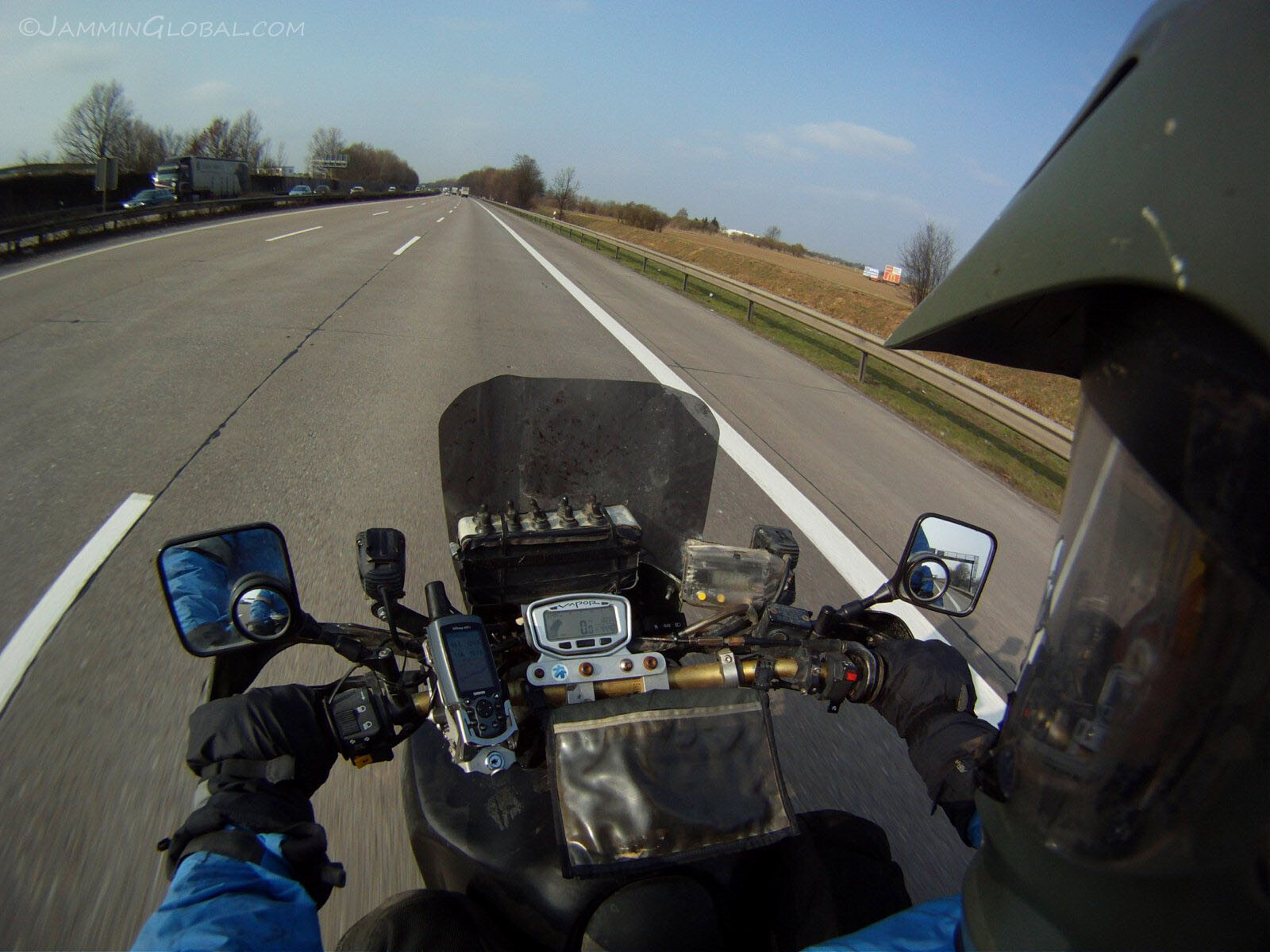
I was super excited to finally be riding the German Autobahn, the standard against which all the motorways of the world are compared to. Of course, I wish I had my sport bike to truly appreciate it. It's famous for not having a blanket speed limit, all though about a third of it now has permanent limits around urban areas. The fact that road accidents are comparable or even less that motorways in other western countries (4.5 fatalities per billion vehicle kilometers in the US compared to 2.2 on the Autobahn) is a feather in the cap of speed lovers as we can site the Autobahn as a reference where good driving skills and strict enforcement of safety laws is much better than conservative speed limits, like in the United States.
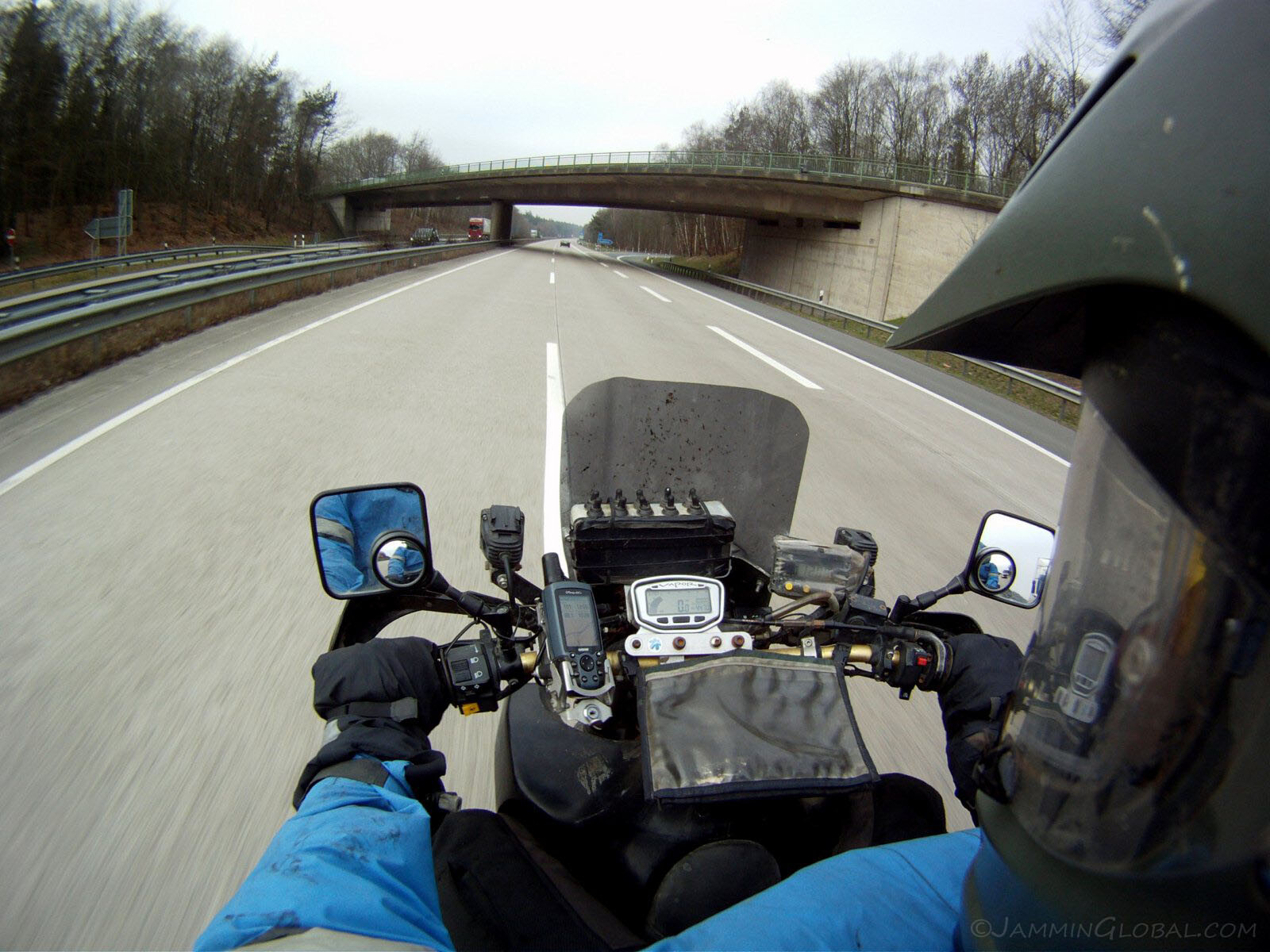
The overpass; the brilliant idea of grade separation, where one axis of transportation flies over the path of another axis at a junction to ensure unhindered mobility. Before the Autobahn, all junctions were intersections, which are considered at-grade (meaning at the same level) and this simple idea transformed the concept of roads. It is also now universally recognized as the symbol for limited-access motorways the world over. The overpass meant that traffic joining a motorway had to 'ramp' up to speed before entering and ramp down while exiting. We take these facets for granted living in a modern world, but it was only a few decades ago when these ideas were major breakthroughs in traffic management.
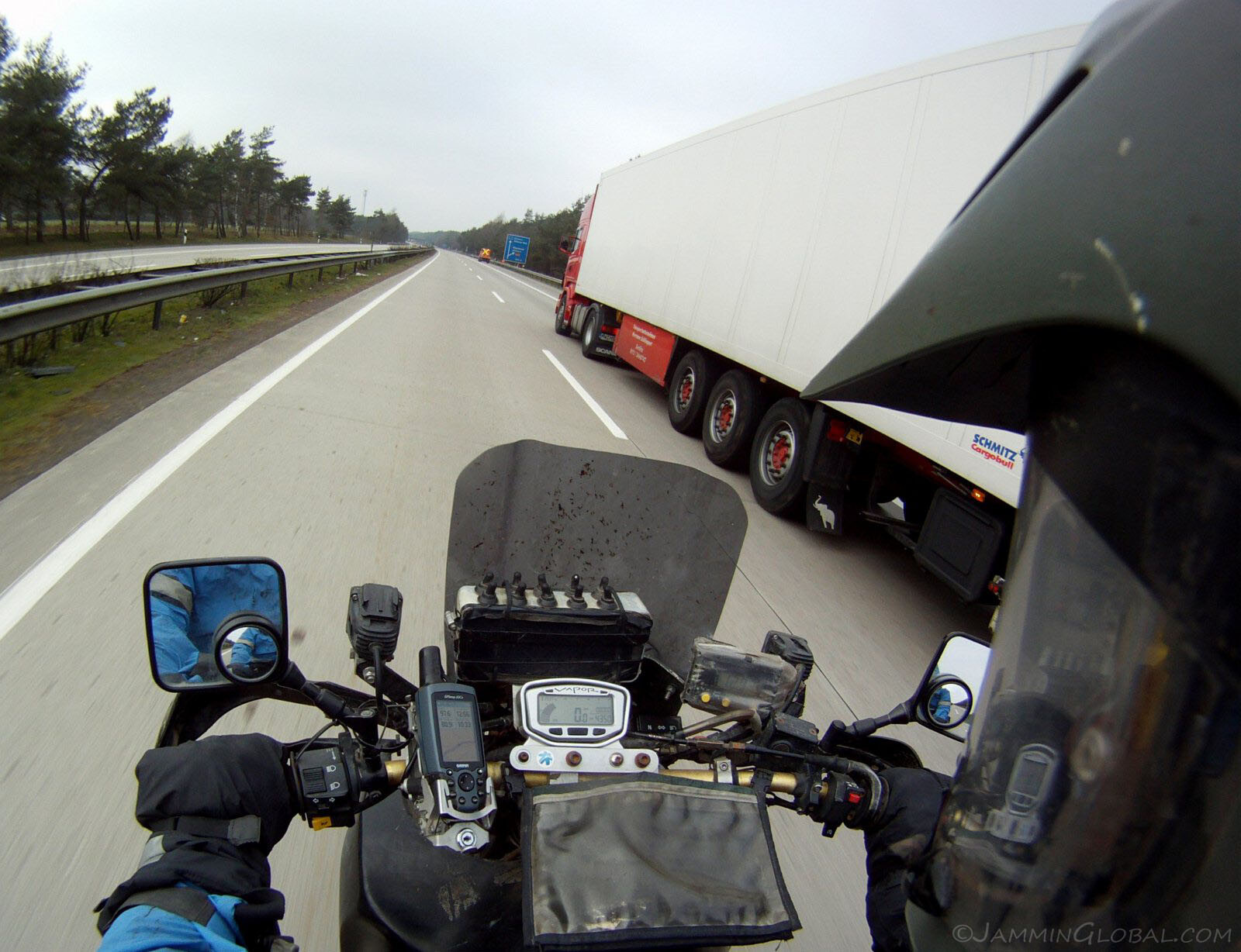
I was so pleased to be amongst drivers with a very high level of discipline for road manners, owing to the strict and arduous process of getting a German driving license. Everyone was cruising in the right lane and only using the left for overtaking. They strictly followed the rule of no overtaking on the right (referred to as 'undertaking'), which is considered dangerous. This rule also exists on the US Interstate system, but is hardly enforced, leading to a culture of zig-zagging around traffic, which I admit was great fun on my sport bike. There are unmarked police cars and motorbikes on the Autobahn equipped with video cameras to aid in enforcement of these rules. Tailgating is also strictly enforced, along with faster drivers being too aggressive with slower ones. I was cruising around 110 kph (68 mph) and had to twist the throttle a bit more when overtaking the numerous trucks on the Autobahn, to ensure that I wasn't going to be run over by some speeding BMW in the left lane.
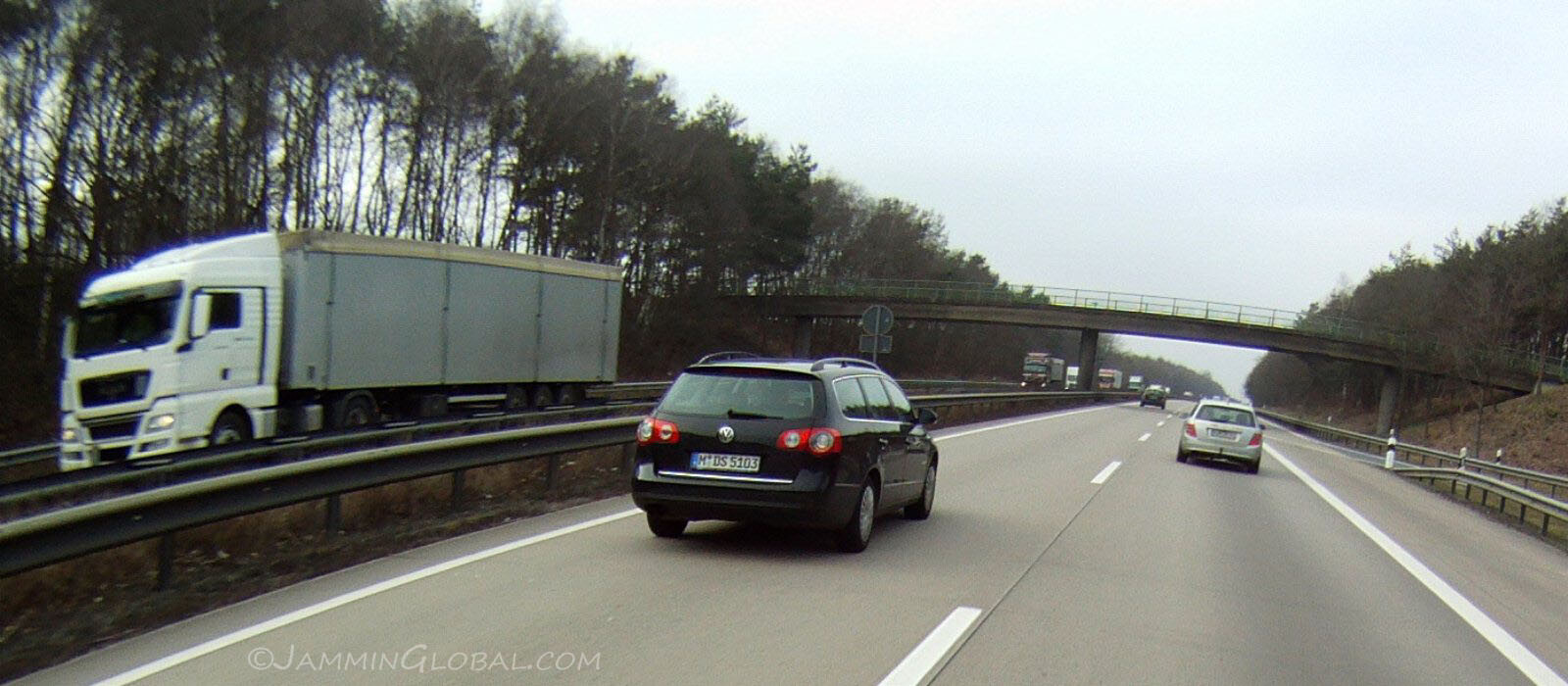
Cruising in the right lane, freezing with the low temperatures, my spirits (of being an automotive enthusiast) were uplifted seeing the multitude of high speed German automobiles bahn-storming by in the left lane. This is after all the homeland of BMW, Audi, Mercedes and Porsche, which were more than 60% of the cars that I saw on the Autobahn. Too bad the auto-capture mode on the GoPro only caught this Volkswagen Passat Wagon whizzing by. However, it illustrates the majority of the car types that I saw: station wagons. This shape is not popular in the US, even being looked down on and to fill their need for space, the cumbersome SUV is the accepted shape. In Europe, they're generally more practical and fuel conscious and this shows through with their love of the station wagon. I can see now why BMW makes an M5 Touring, a station wagon with 500 horsepower.
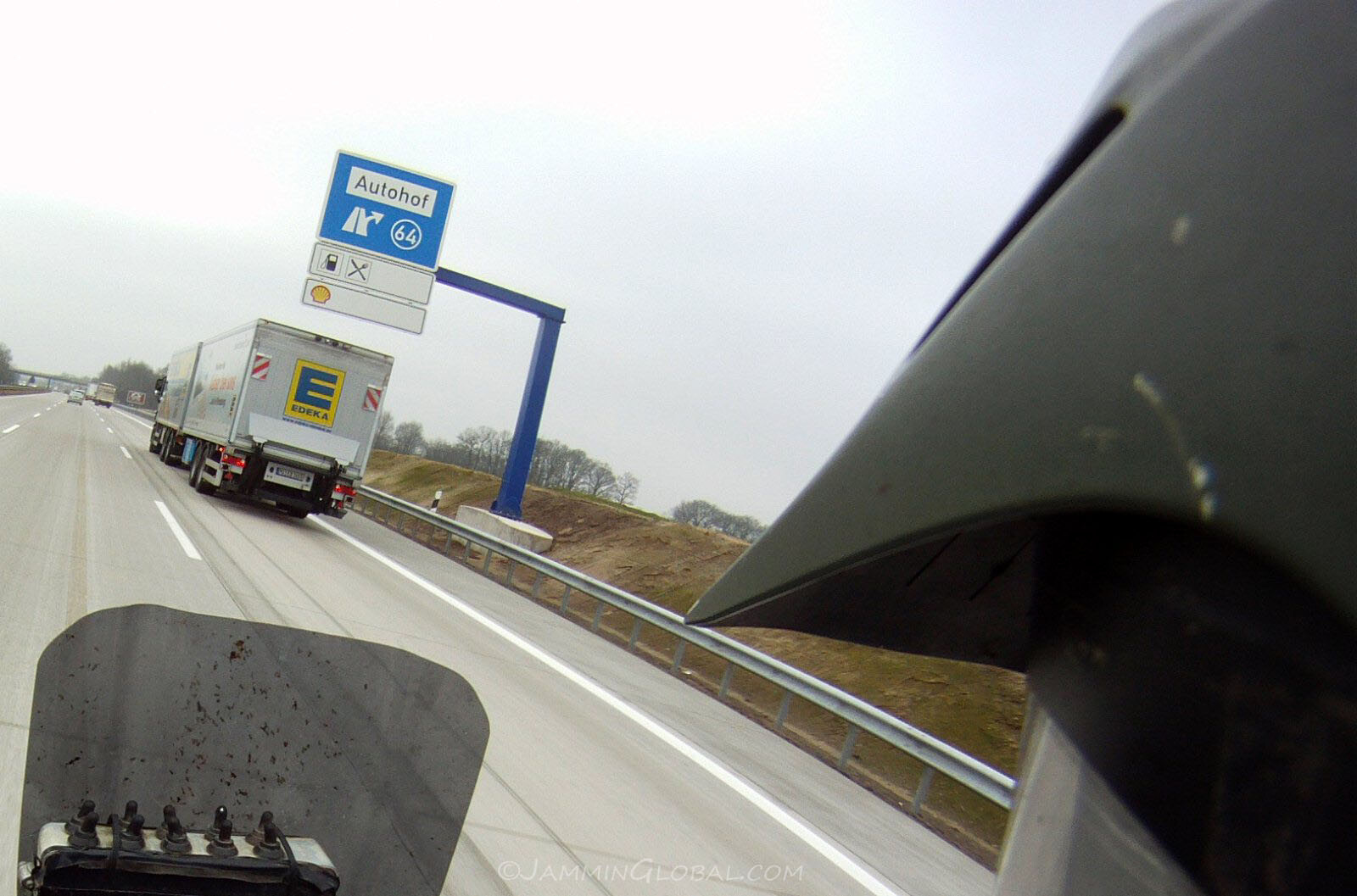
I was wearing my maximum protection against the cold and managed to do at least 200 kms (124 mi) between breaks, since this was a high-mileage day. Criss crossing the US, I learned to pay attention to overall average speed and used the estimated-time-of-arrival readout from my Garmin 60Cx GPS to gauge my breaks and the time spent running warm water over my fingers to bring the blood back. I installed heated grips but couldn't use them since the switch was broken in the accident from Bolivia and I never got around to fixing it.
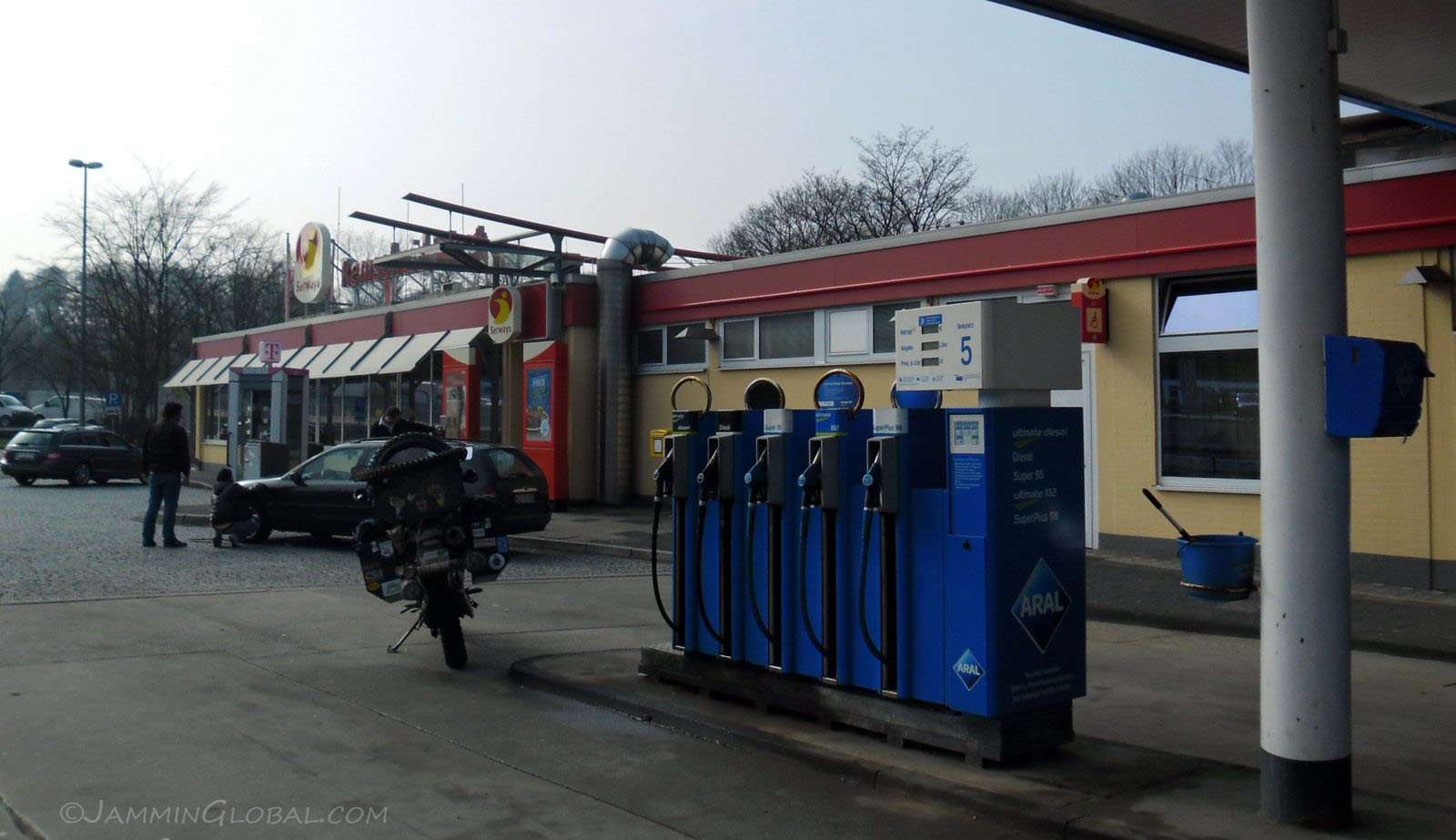
As I got near Cologne, it finally started warming up and the terrain got a bit hilly, compared to the flat riding through northern Germany. An indication of the high quality of German automobiles is the higher octane petrol that they need with 95 being the lowest grade (with 10% ethanol), going up to 98 (5% ethanol) and 102, which could be considered race gas in the US. This is why Europeans are so worried about the fuel quality in the Americas. What will they do with 86 octane fuel? I also wanted to avoid riding through Europe on this trip due to the high cost of petrol here. At €1.50/L (US\$8.12/gal), it's one of the most expensive prices for petrol in the world. About two-thirds of the price is government taxes. This is done to encourage public transportation use, which is generally one of the best in the world and it also encourages the use of smaller-engined cars that have better fuel efficiency. Due to its slightly lower price, diesel-engined cars are very popular and make up about 50% of all personal automobiles. The fun thing about modern diesel cars is that they produce more torque than horsepower, which is more usable around a city and torque is fun! The old image of dirty diesels has been replaced with cleaner burning fuel sippers.
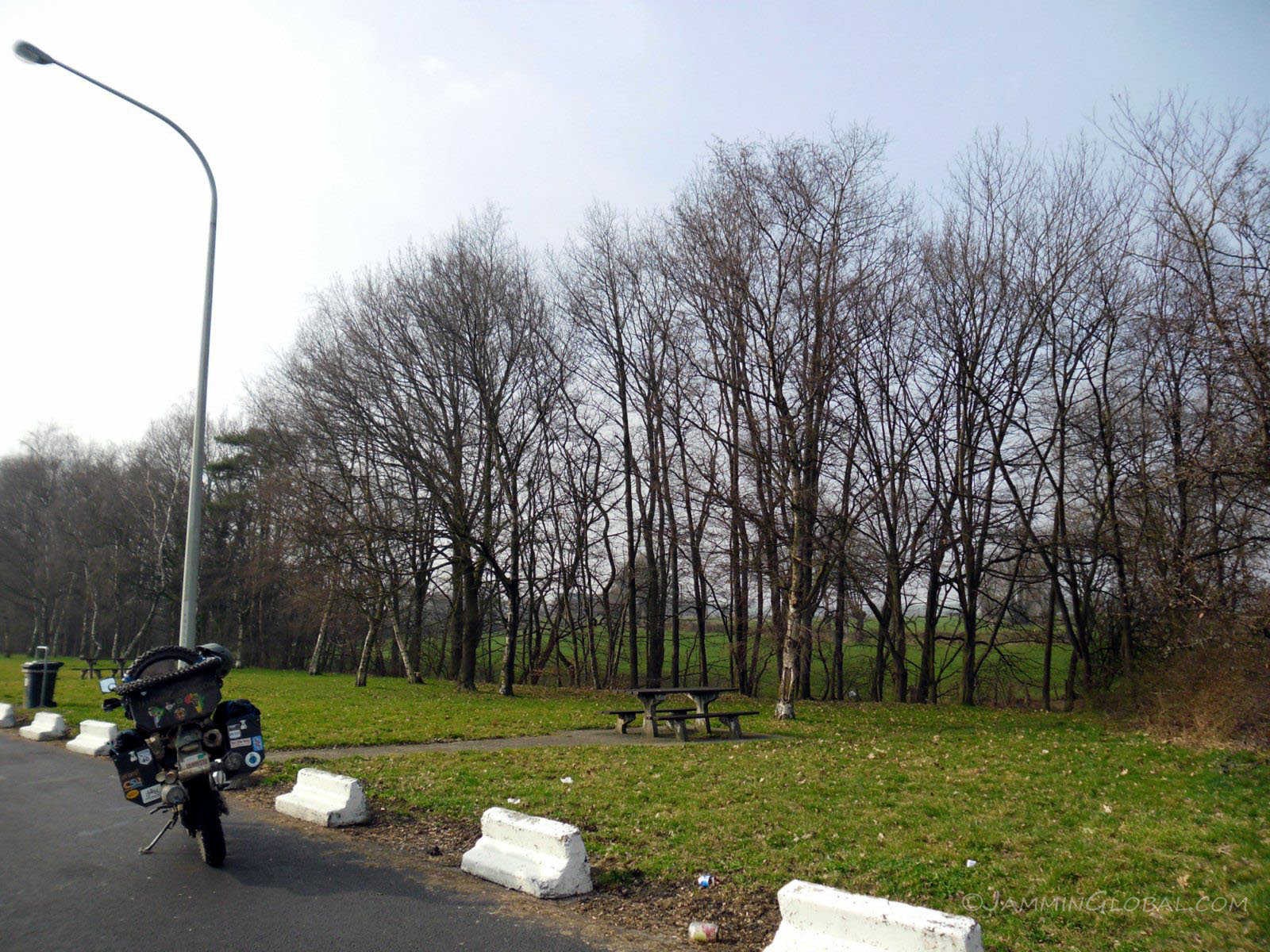
Taking a break in a roadside park after crossing into Belgium. Due to the lack of borders between countries in the Schengen Area, there was hardly a notice indicating that I had entered a new sovereign nation. However, I did note the reduction in high end German automobiles and also the driving manners slowly deteriorated as I headed west. By the time I got to France, it was only Renaults, Citroëns and Peugeots who were cutting back really close to me after overtaking, compared to ample space given on the Autobahn. Besides the no speed limit factor, the Autobahn trumps the motorways of other European countries by being toll-free (along with the BeNeLux countries). I paid a hefty toll of \$11 for the last 220 kms (137 mi) into Paris on the French Autoroute and vowed not to take anymore toll roads through Europe.
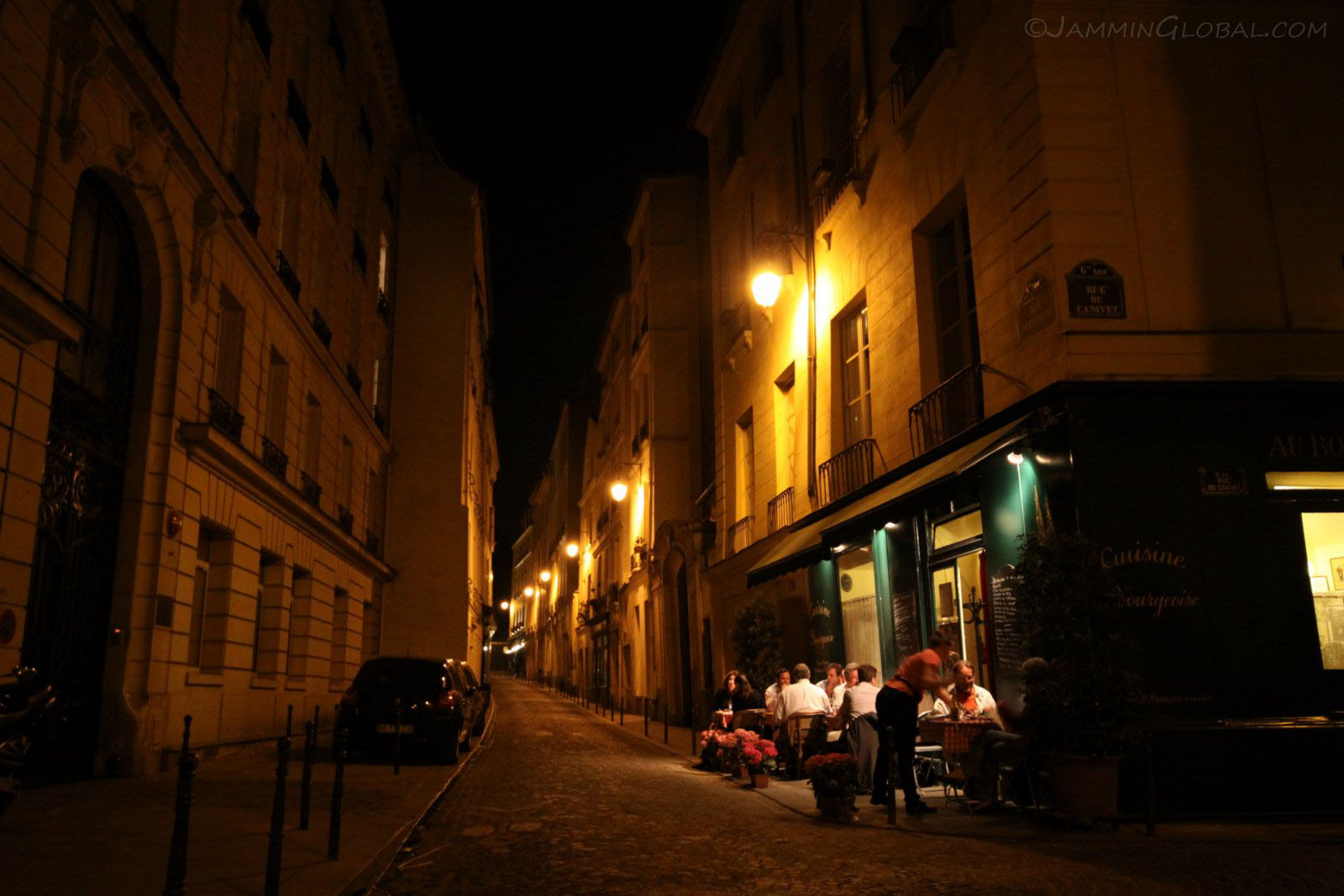
I navigated the streets of Paris and rolled up through this typically narrow Parisienne street to the apartment of a good friend, Vincent, in the 6th arrondisement (district).
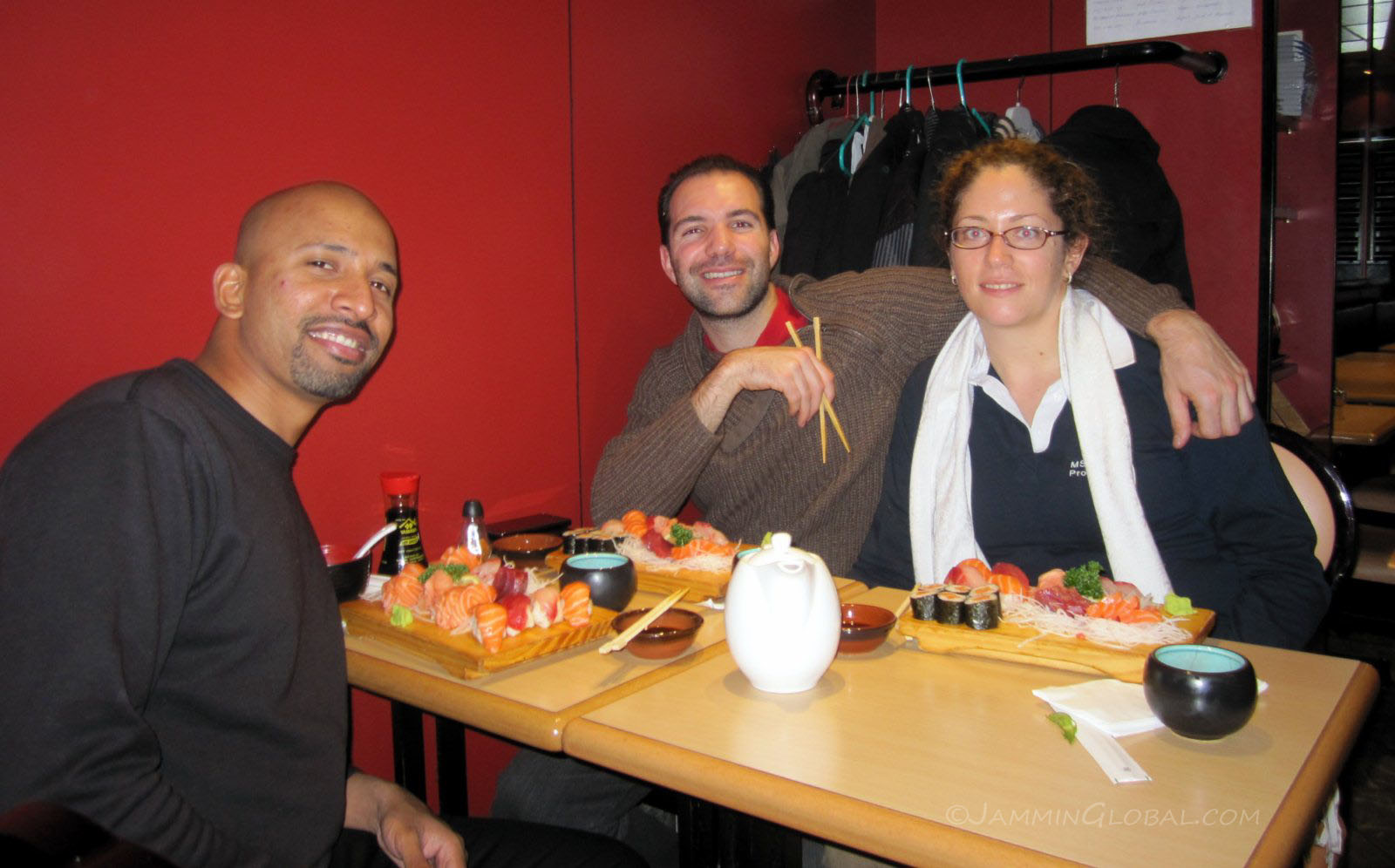
Vince and Agnes (pronounced An-yeah) taking me out for a sushi dinner, which I haven't had since leaving Chicago. Vince and I used to work together and became good friends over lots of ski trips. He and I were the most adventurous of our group of friends and we would head out for all the double blacks. He's from Nice, in the south of France and has been skiing since he was 5. After Chicago, he moved to Paris and met Agnes, a lawyer.
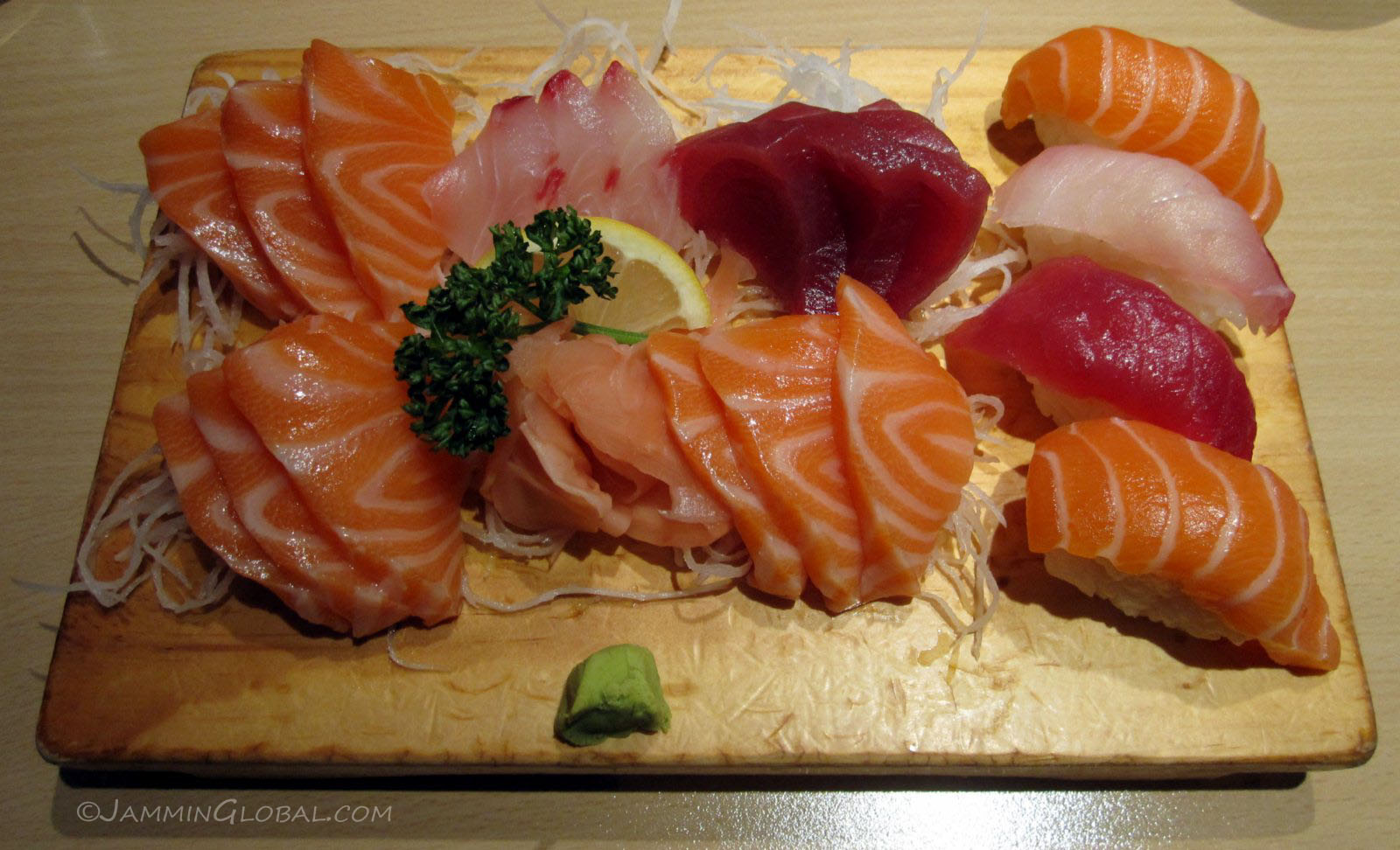
Mmm, so much salmon and tuna. I did have some sushi when I was in Picinguaba, on the coast of southern Brazil, but it wasn't as colorful as this.
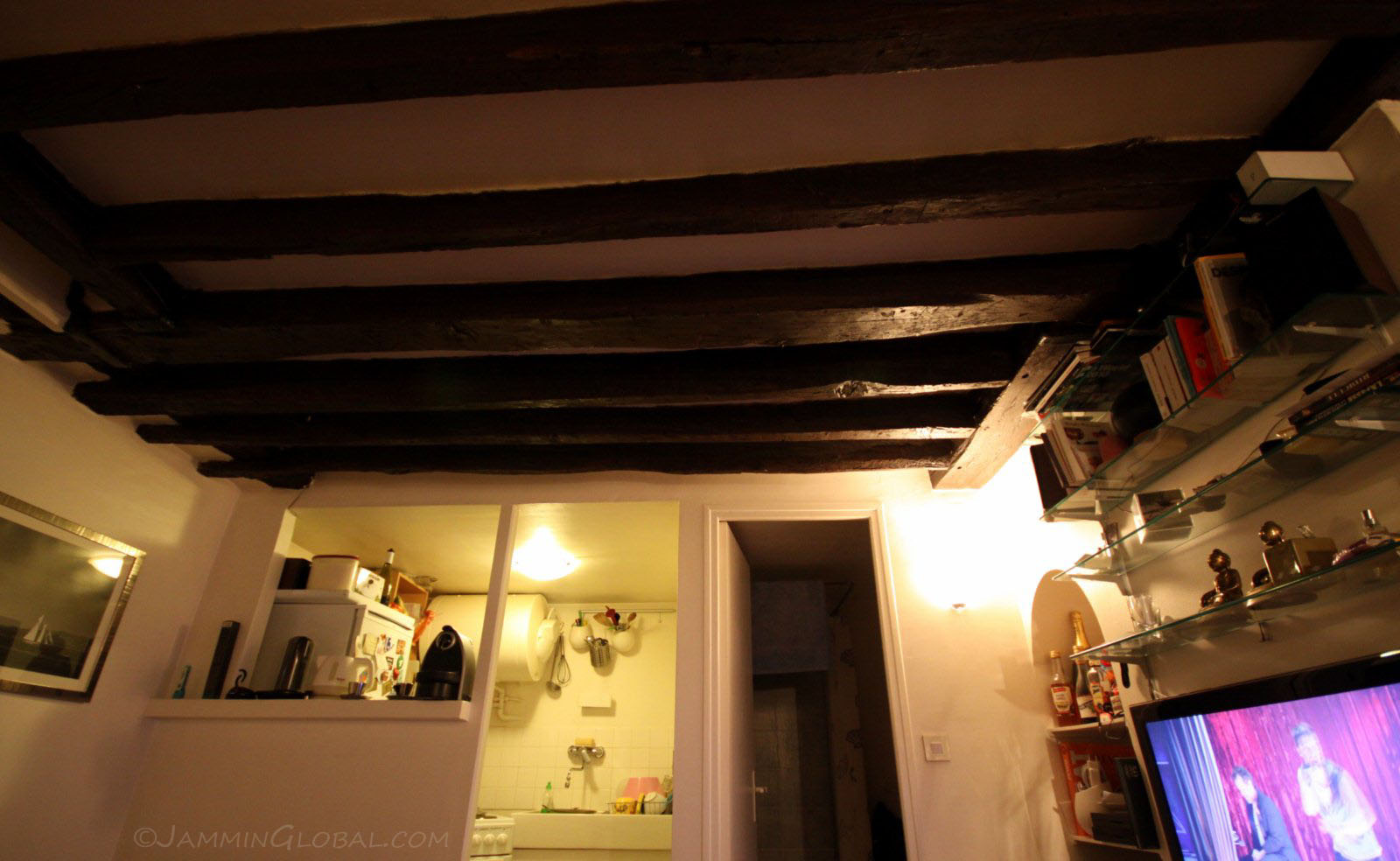
Vince had a really nice apartment, referred to as a 'flat' outside the US, but in accordance with the high property values of living in the city of Paris, most people can only afford so-called 'shoe-box' flats. This is half the flat with a bedroom on the other side. Lots of charm with the wooden rafters, and sufficient for one or two people.
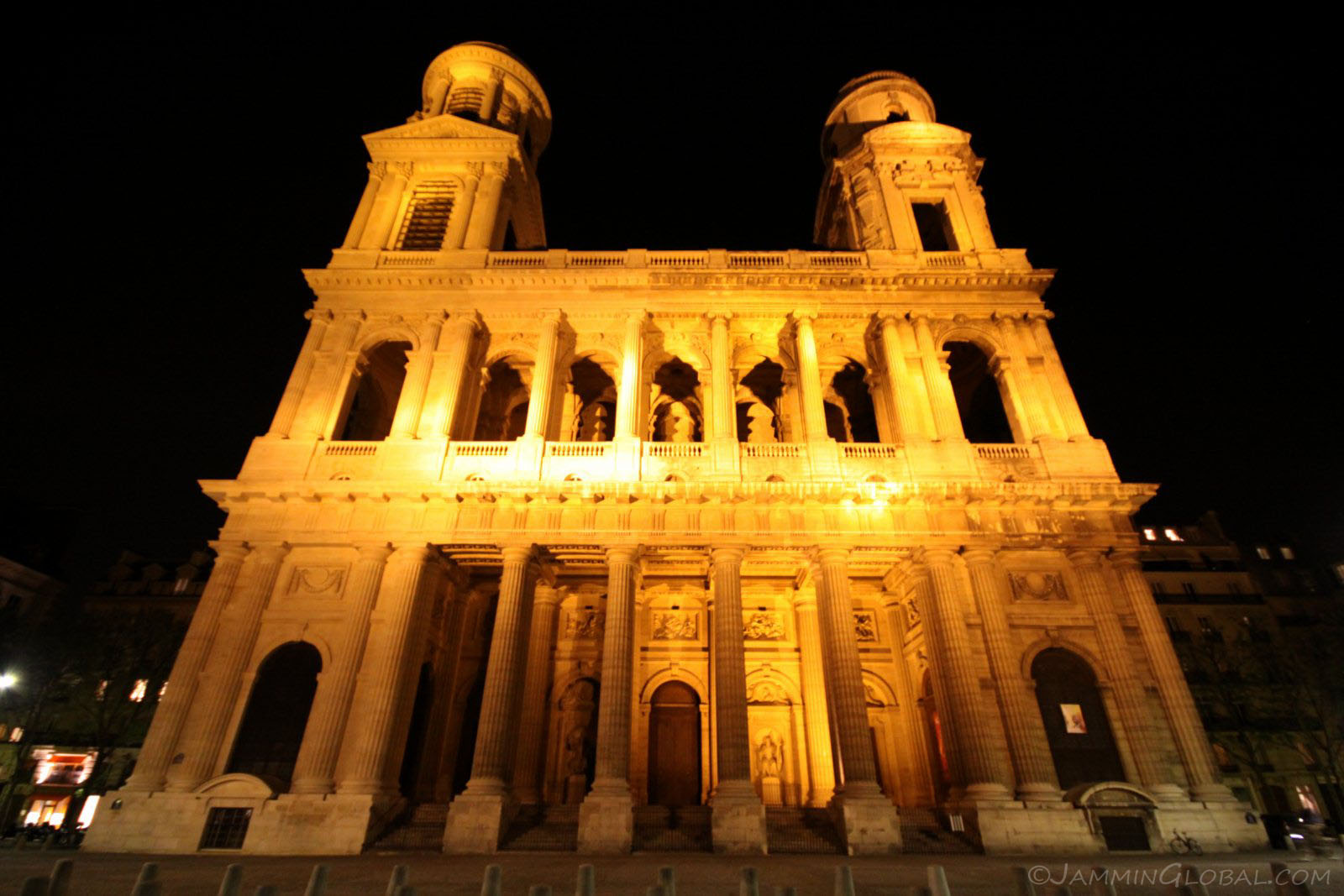
Vince was in the heart of the city, close to the grand Église Saint-Sulpice, with only Notre-Dame being slightly bigger. This church was built over a long period of time and was completed in 1870, but soon after, the northern tower (on the left) was damaged by Prussian shelling. You can see they look different as the northern tower was designed by Jean-François Chalgrin and the southern tower by Oudot de Maclaurin, which was never finished for the lack of funds and the start of the French Revolution. Restoring the northern tower was undertaken by many people over the years since the damage, but only with a serious effort from the local government in the last ten years, did it finally get done properly, opening to the public in 2010. The church is also well-known due to Dan Brown's novel of The Da Vinci Code, where the gnomon (astronomical solar indicator) in the church was referred to as the 'rose line'.
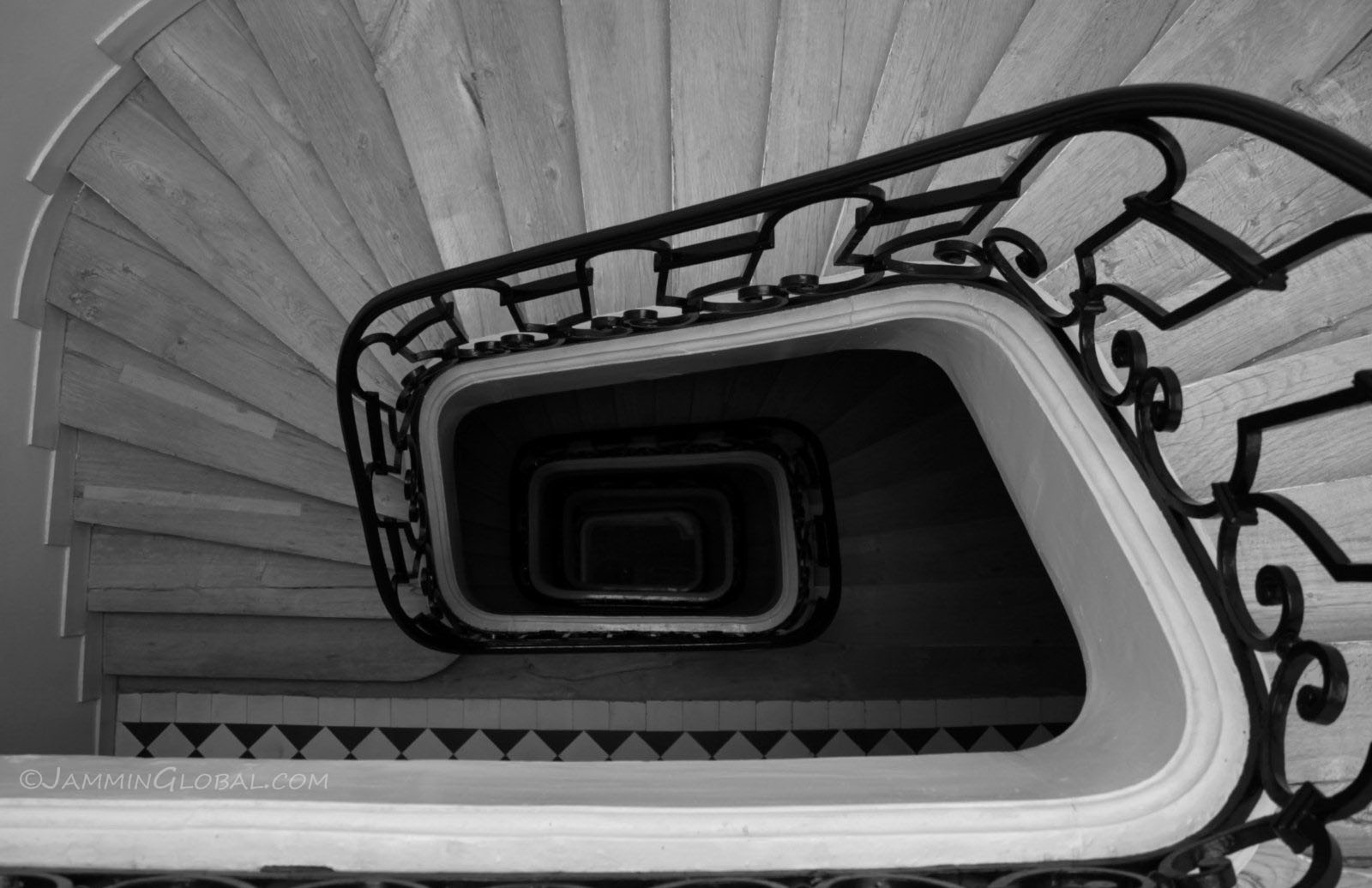
The beautiful staircase leading up to Vince's flat. Most buildings in Paris are either four to six stories high and there are no elevators, except in some modern, high-end buildings. Vince and I were supposed to meet our friend, Ian, from Chicago, for a short trip to Morocco, but with my visa taking much longer to approve, I could not go and meet Ian who was bringing a huge care package for me with spare parts for the bike and most importantly, a new Canon 50D SLR camera. But Vince went and brought me these goodies. I sent my old Konica-Minolta 5D SLR back to the US as I decided it was time to upgrade. I got lenses to cover a wide range from a Sigma 10-20mm ultra wide to a Tamron 18-270mm tele-zoom, along with a Canon 50mm fixed lens. I wont be able to use the SLR for all the pictures, as it's impractical, so my Canon SD940 point and shoot will be taking most of the shots.
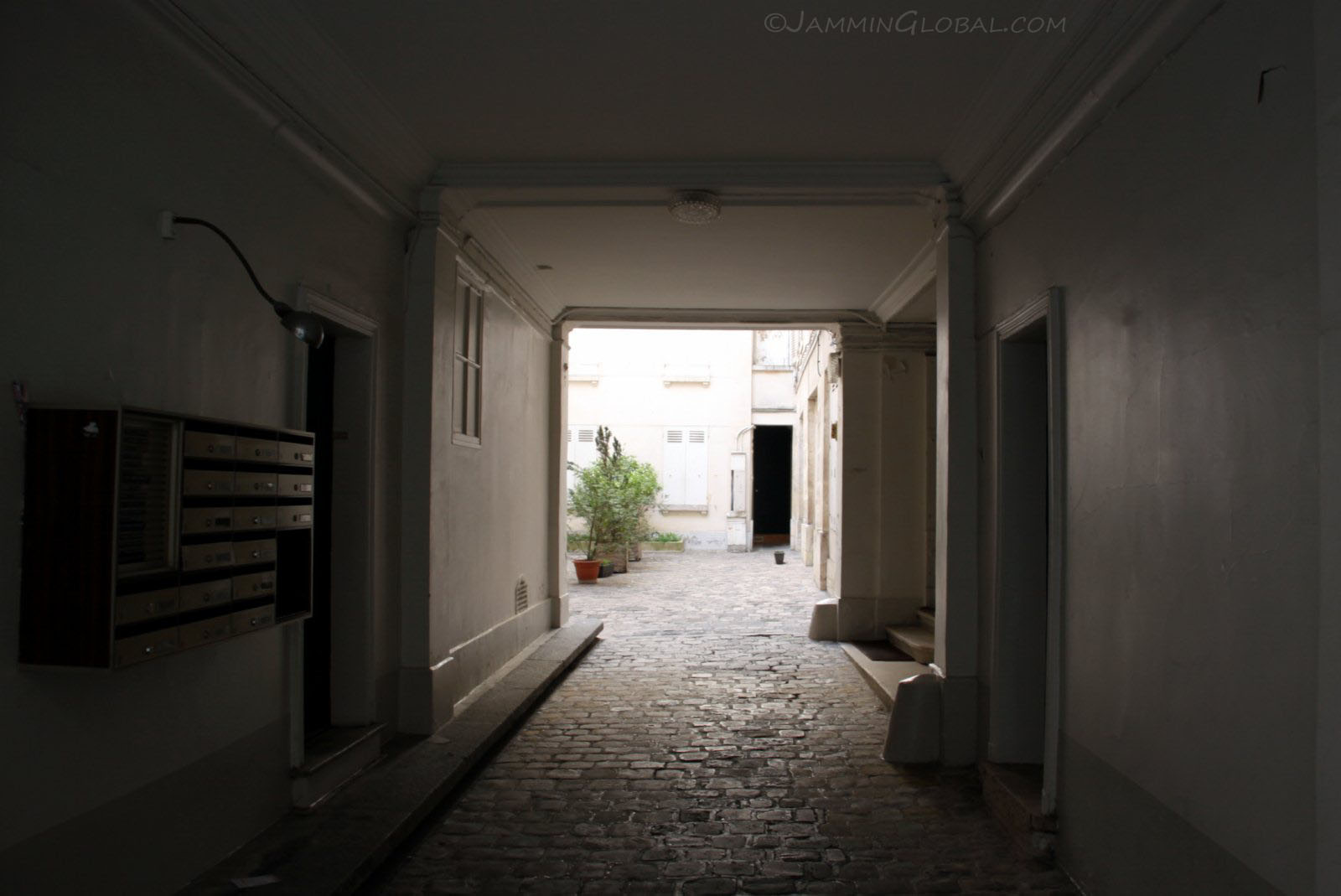
Entrance to Vince's building. I had this image (from movies, like Before Sunset) of Parisienne apartment buildings with a courtyard in the middle and here I was.
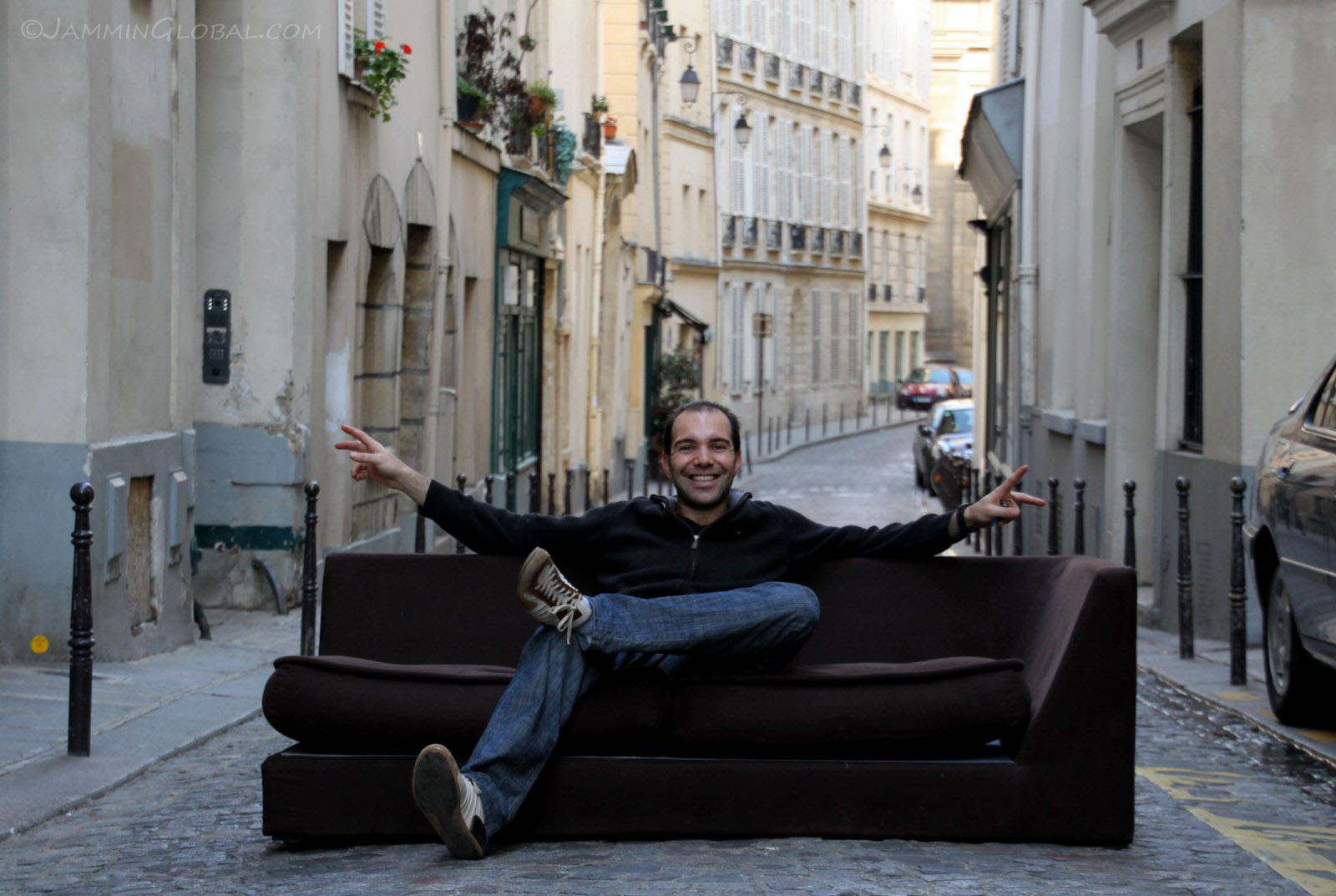
Vince, surfing his couch in the streets of Paris. Agnes was moving in and I helped out with the furniture hauling.
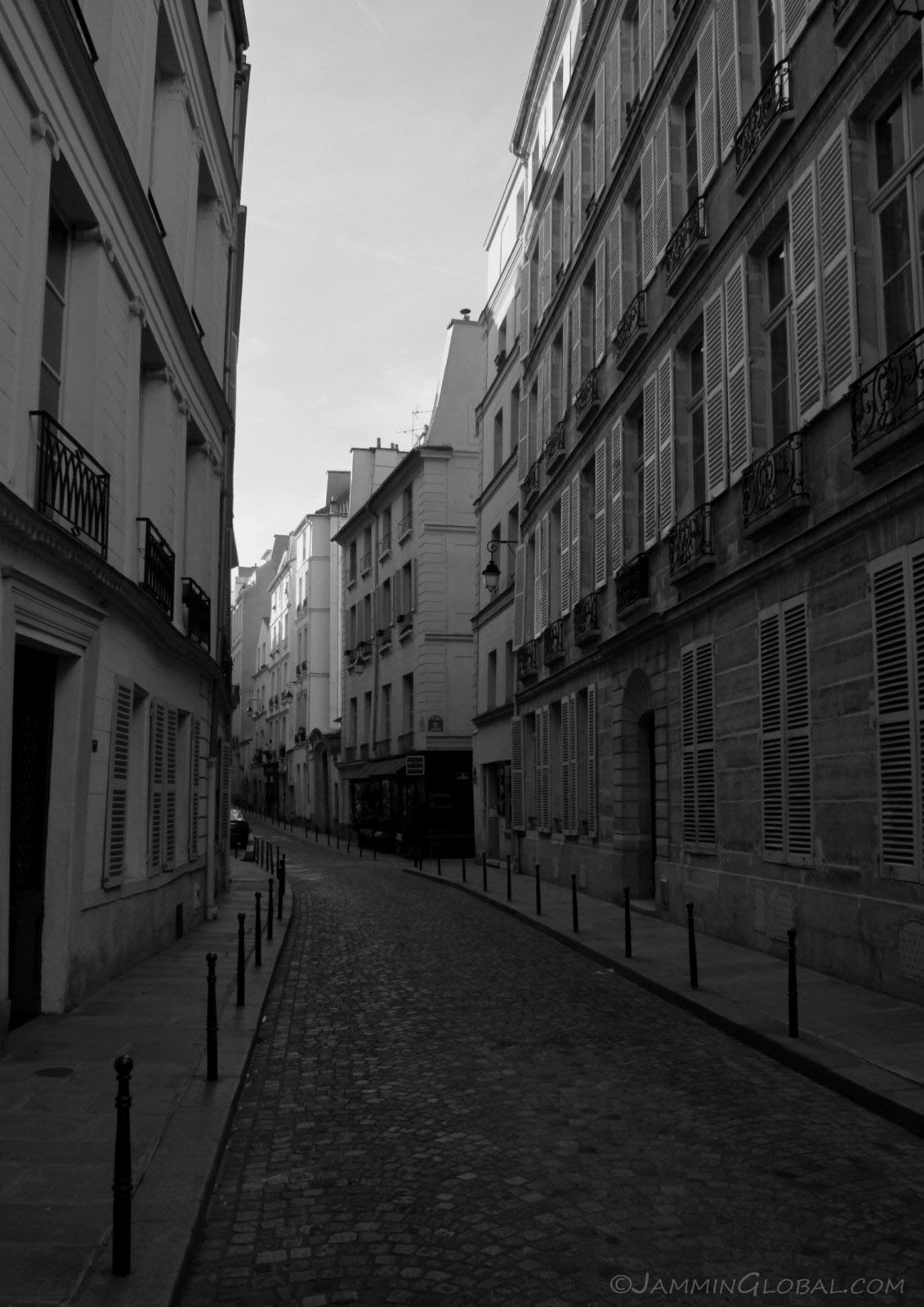
The narrow Rue Servandoni, wide-enough for just one car with protection for the pedestrians.
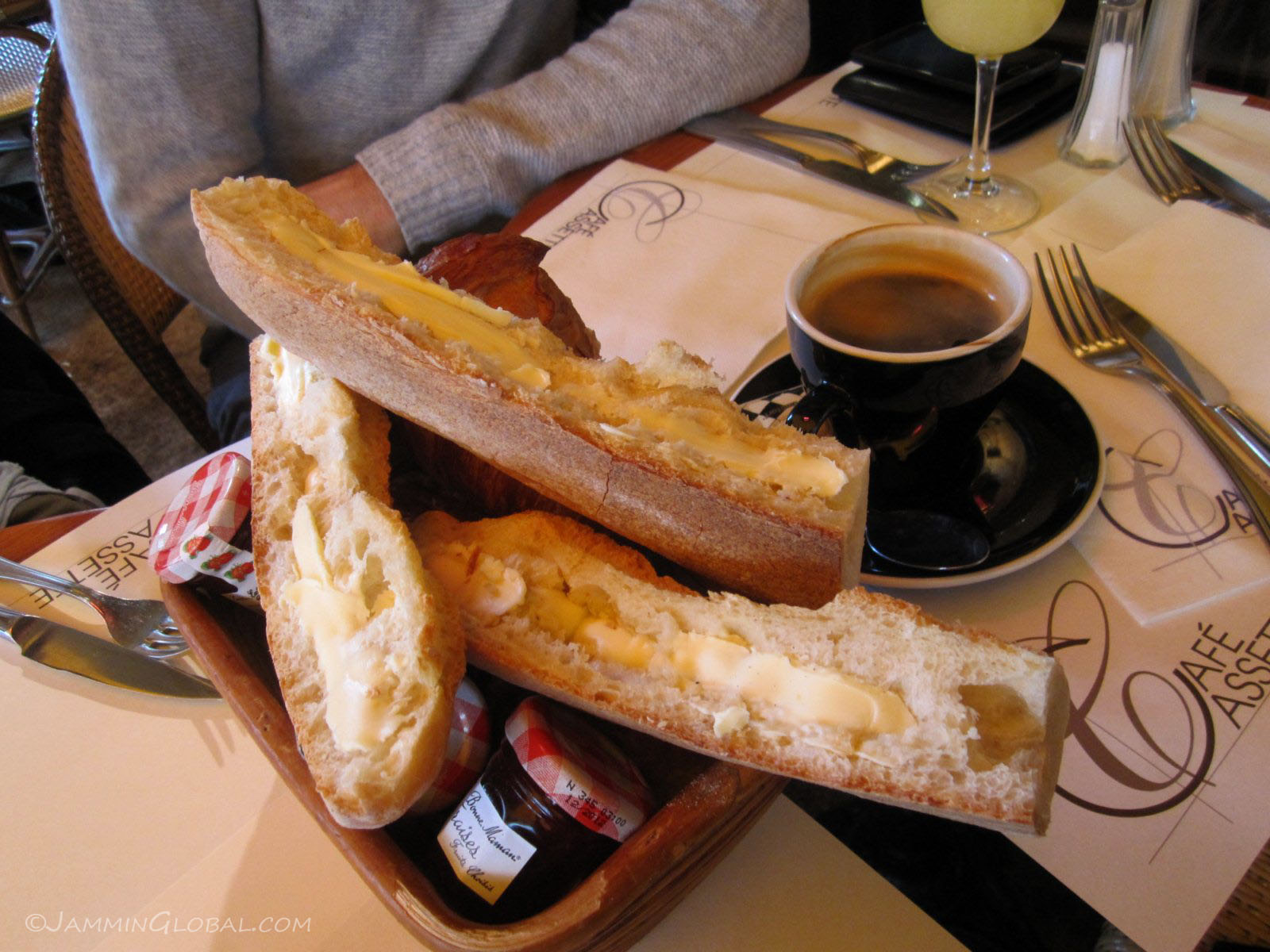
On Sundays, the thing to do in Paris is have a huge brunch and then go for a walk in a park. Some delicious French bread with a healthy spread of butter to go along with...
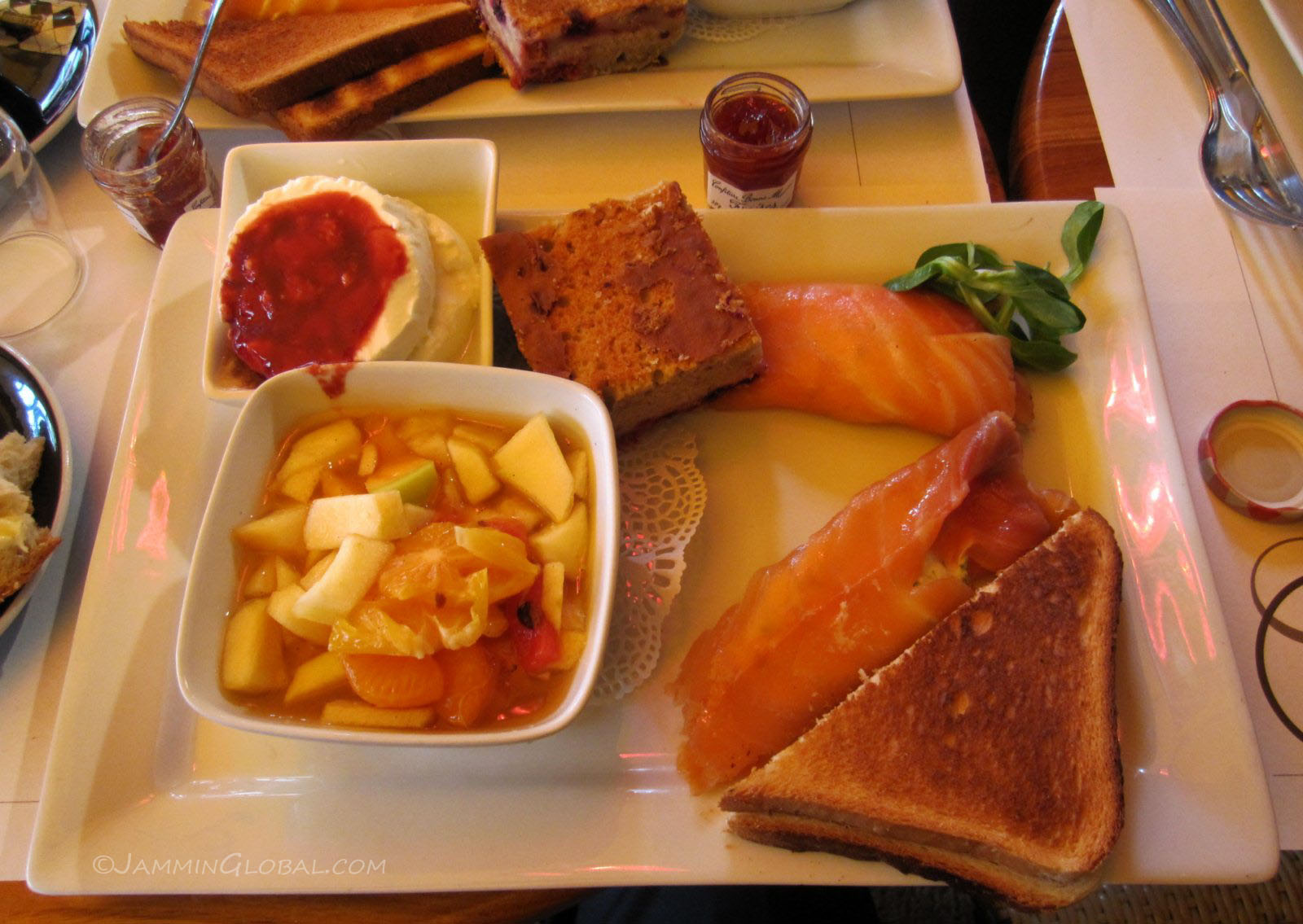
...a variety of tasty French dishes: Salmon Roulade with cream cheese and herbs, muffin cake, fruit salad, fromage frais (fresh country cheese, similar to Indian curd) along with hot chocolate.
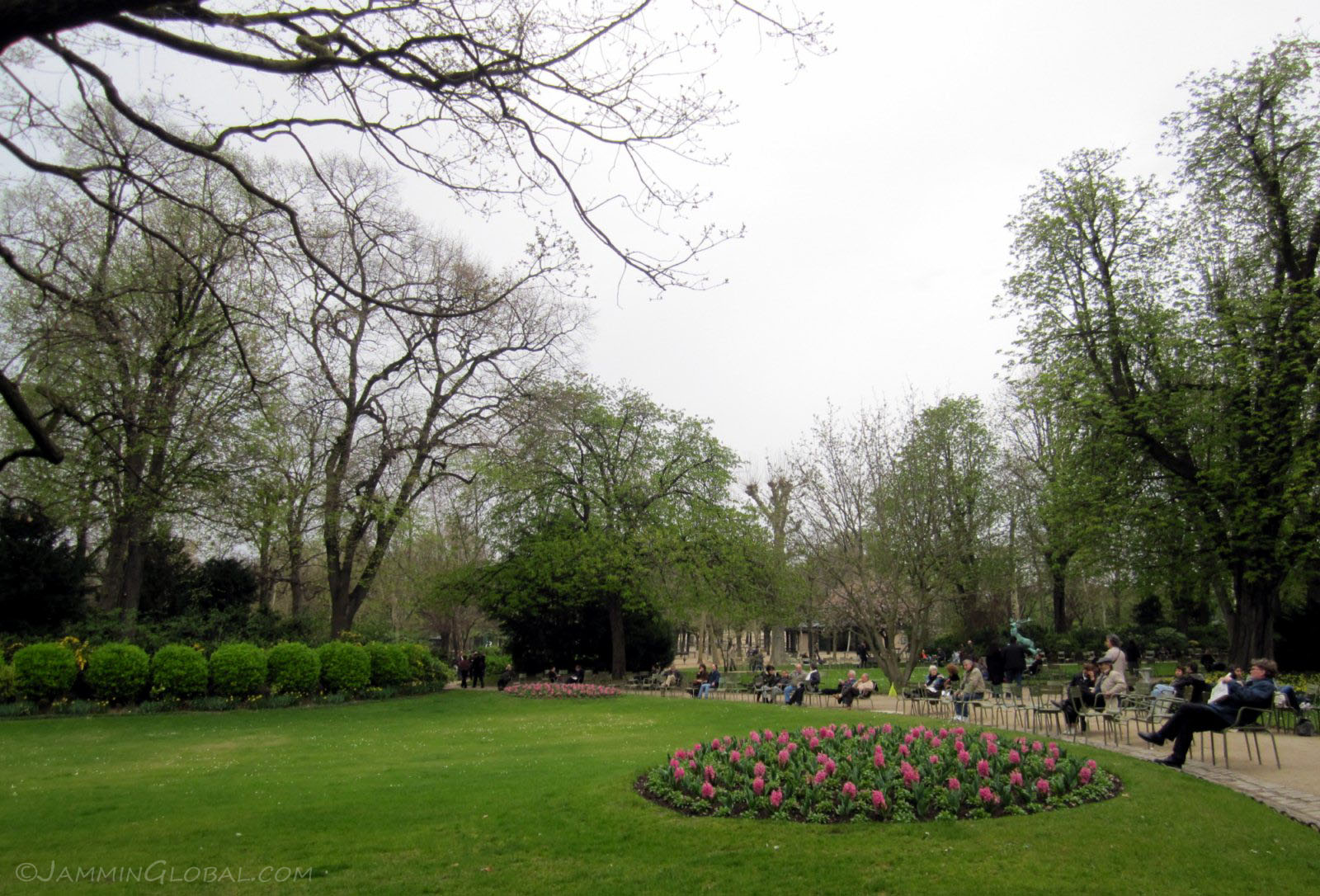
The heavy brunch was followed with a stroll through nearby Jardin du Luxembourg, the second largest park in the city, a place of tranquility from the busy streets outside. It was built with direction from Marie de Medicis, the widow of Henry IV, from the year 1611 onwards.
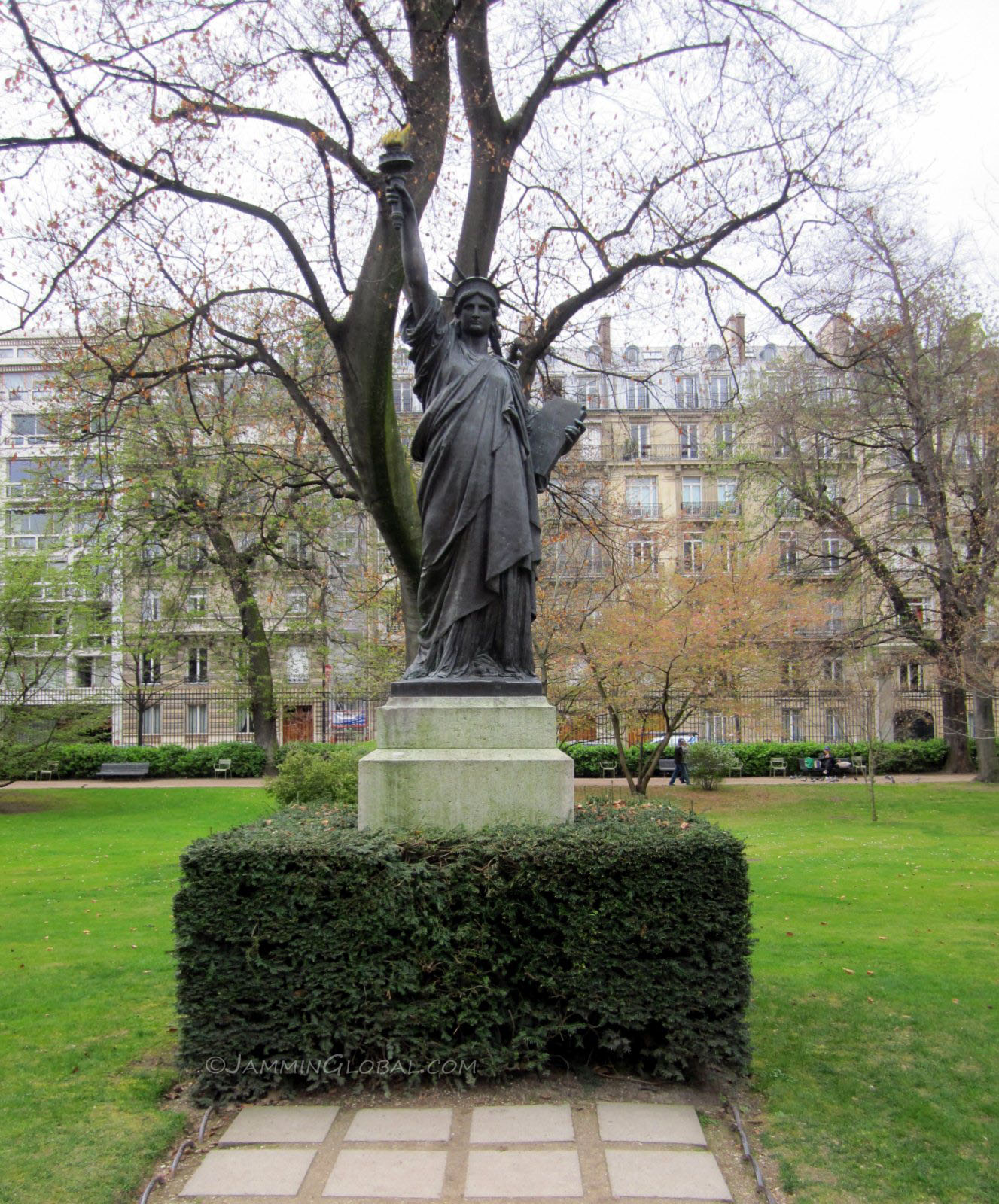
The park has over a hundred statues and Vince pointed out this first model of the Statue of Liberty, which was designed by Frédéric Bartholdi in 1870 before the full size version was erected in New York Harbor in 1886.
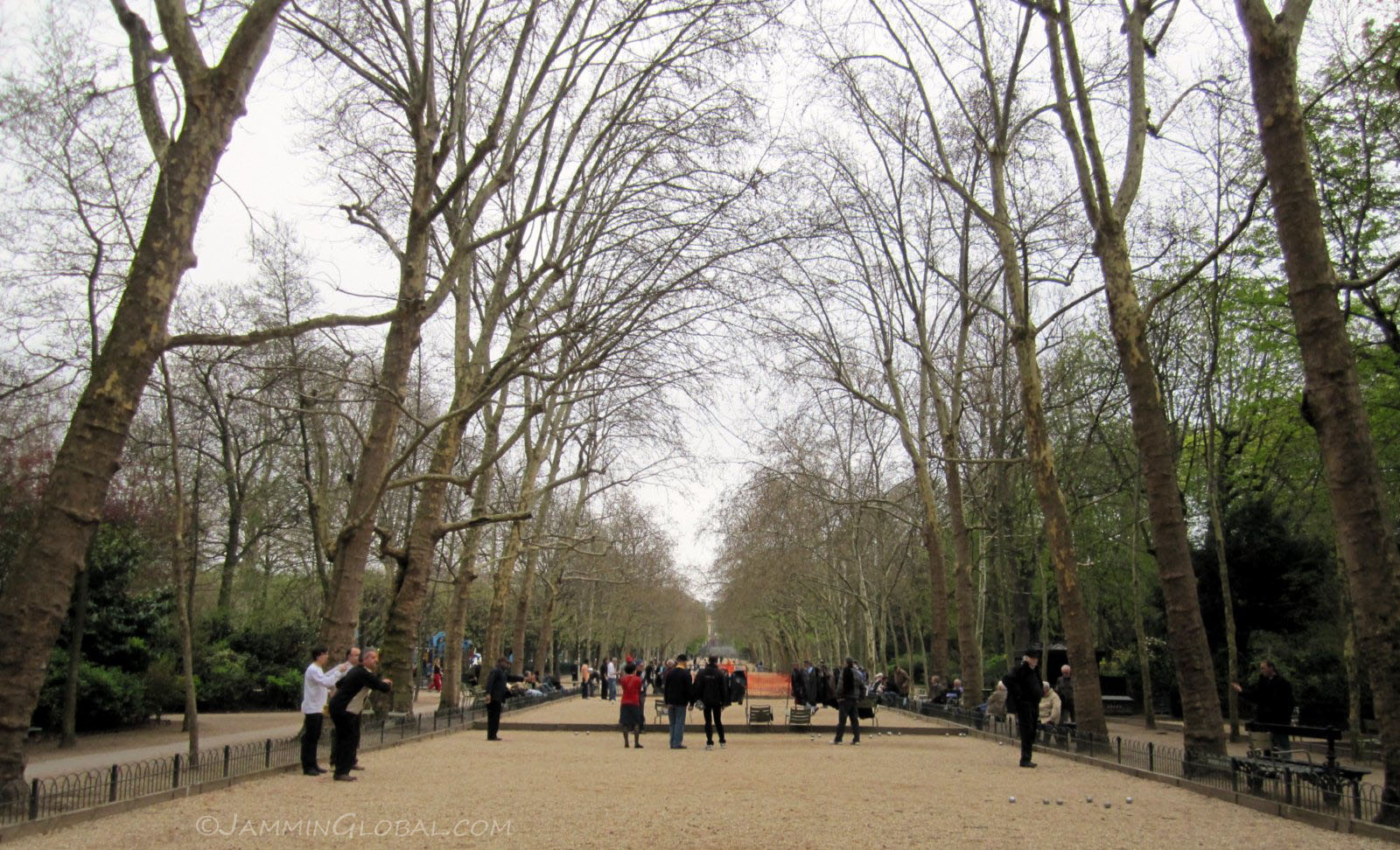
Men playing a round of boules, a French ball game, in the grounds of the park. They try to get a series of heavy, metal balls as close to a target as possible. Everyone was armed with a tape measure.
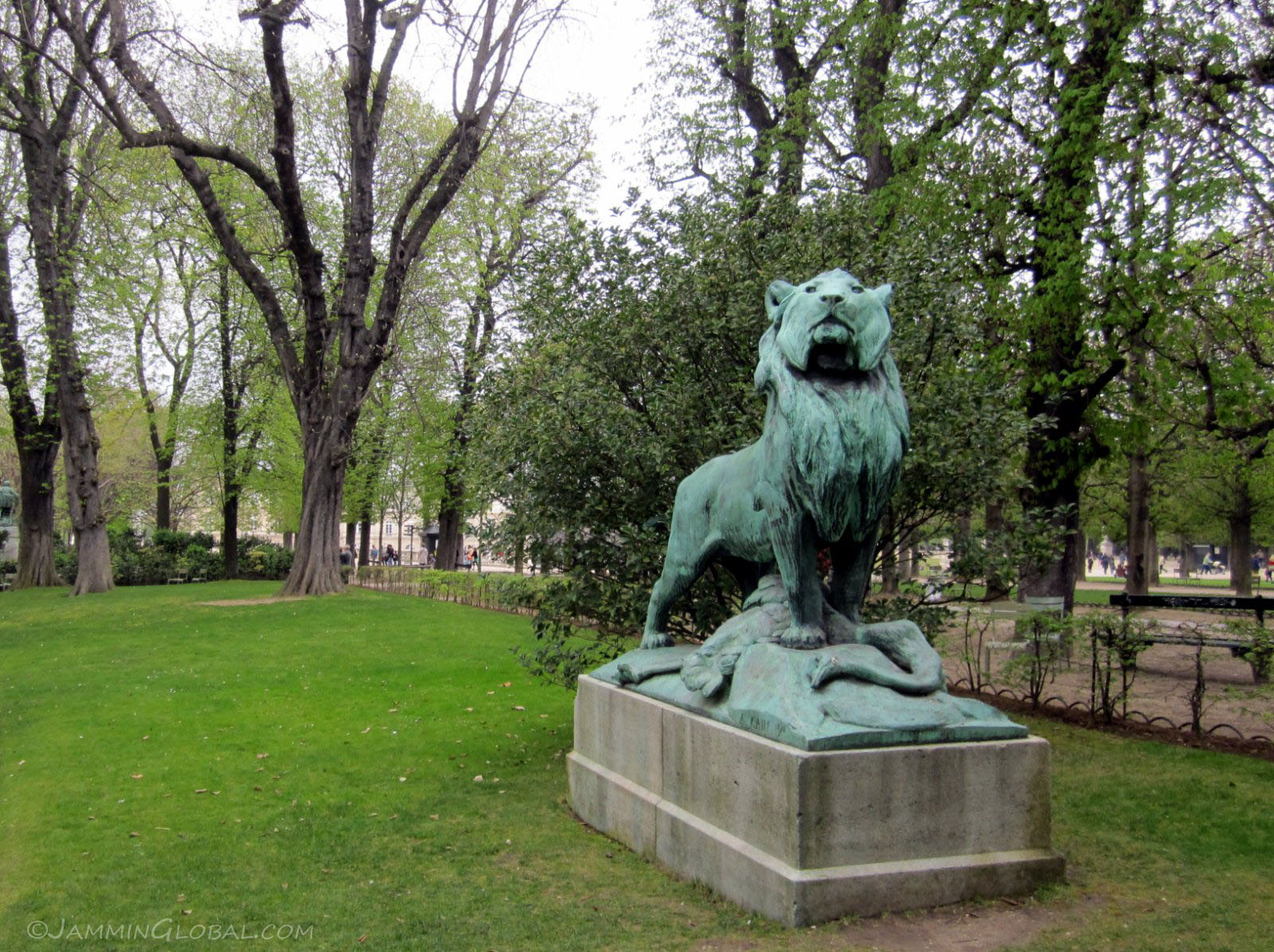
An 1870 bronze sculpture of a lion and his ostrich prey, called 'Lion de Nubie et sa proie' by Auguste Cain.
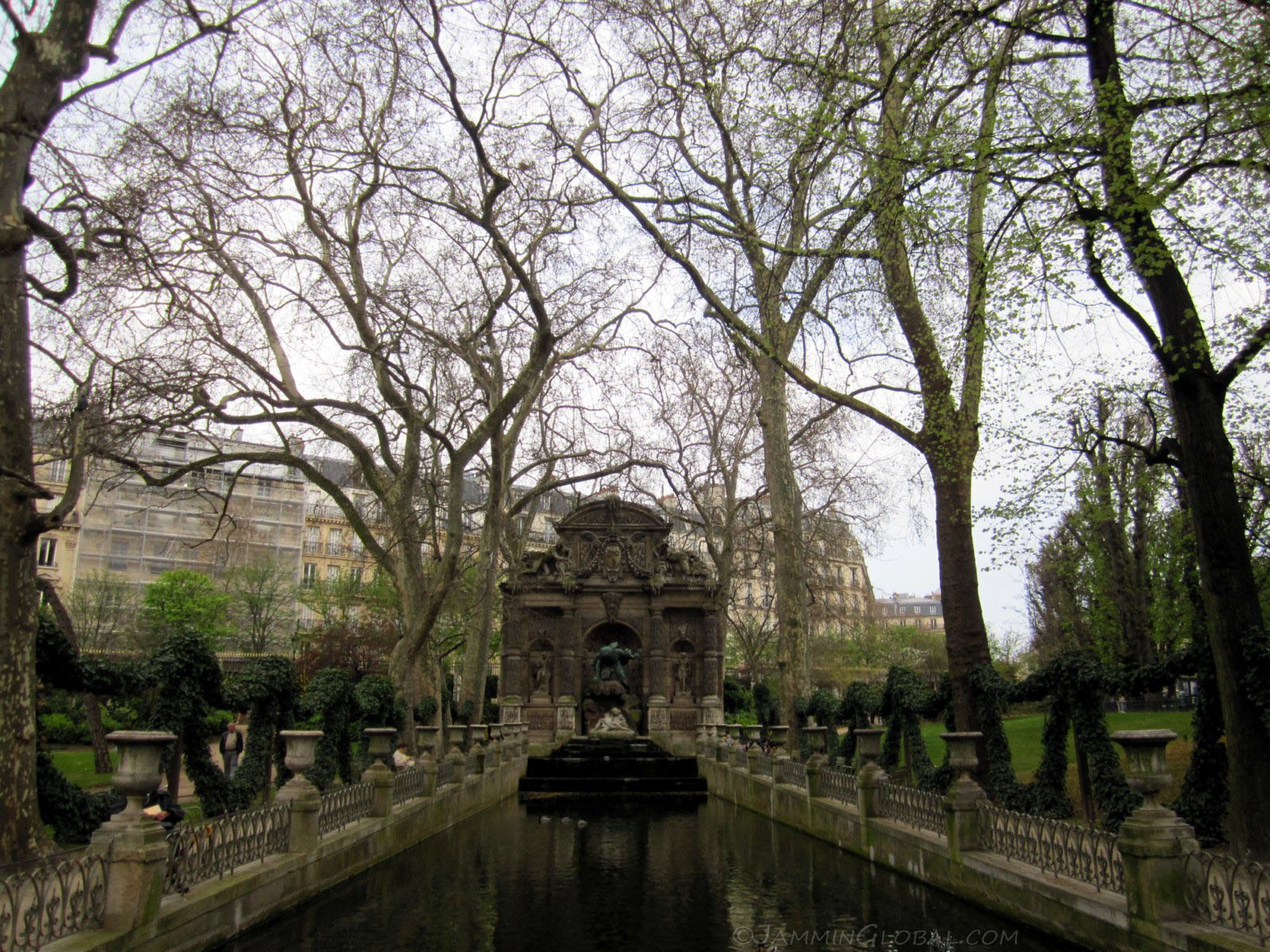
La fontaine Médicis, one of the first features of the park, designed by Tomasso Francini, who was brought in from Florence, where the patron Marie de Medici was from. The fountain was built in 1630, but degraded over the years and then Napoleon Bonaparte had Jean-François Chalgrin restore it in 1811. Along with work on St. Sulpice, Chalgrin is most noted as the architect of the Arc de Triomphe.
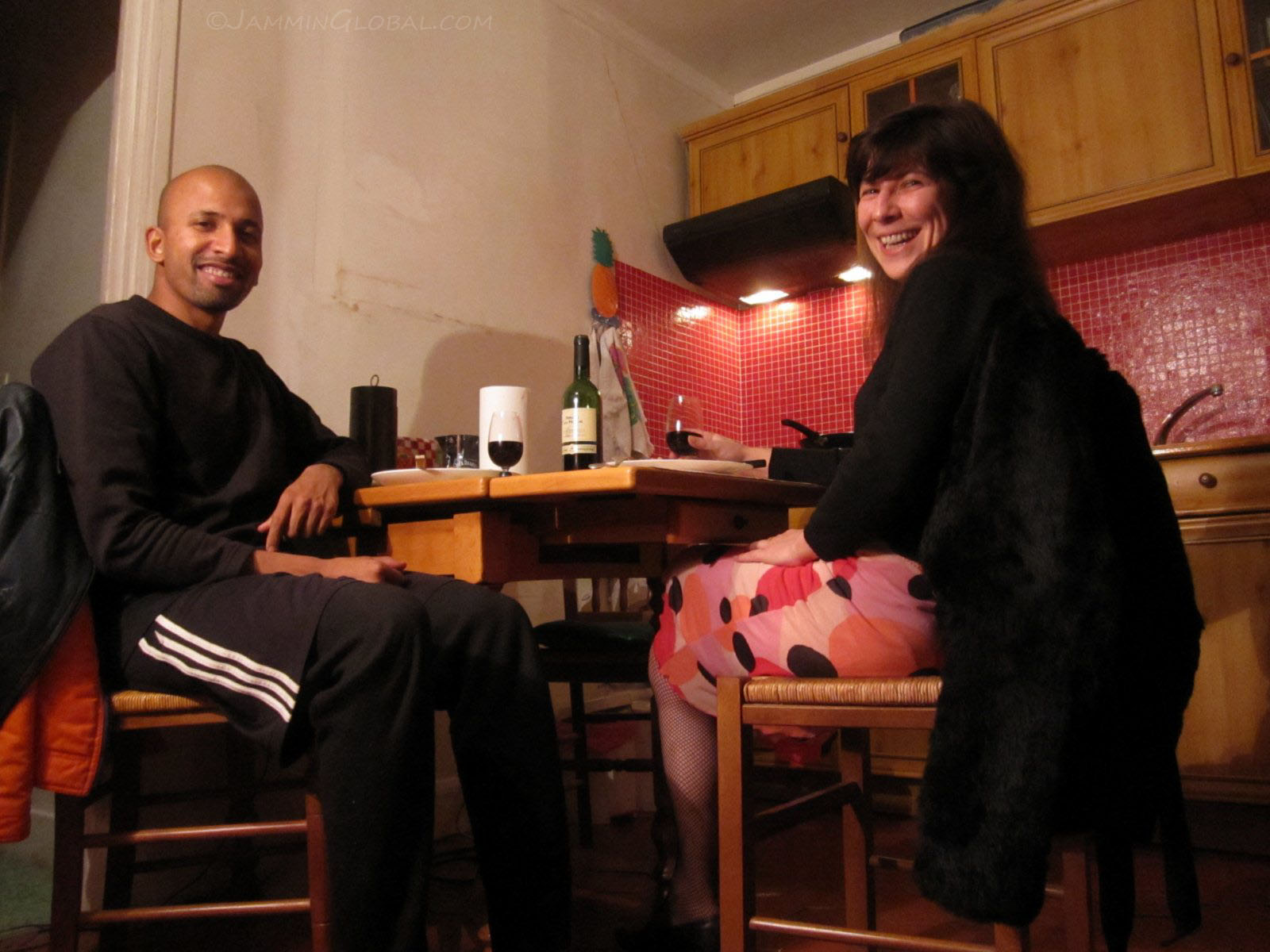
Seeing as I had to wait for about three weeks to get an answer from the Moroccan embassy whether I would be granted a visa or not, I gave Vince and Agnes their space and surfed a few couches around Paris. I left the bike safely at Vince's work garage outside the city. This is Florence, whom I met at a CouchSurfing meeting in Buenos Aires, a couple months ago, and I contacted her once I got here and she invited me to stay for a while. She's very active in the Paris CS community and was in the midst of planning the biggest CS gathering in the world, which happens every summer in Paris, the city with the largest number of resident CouchSurfers. We had lots of good talks around her kitchen table. She comes from a small town on the way to Lyon and works at a private bank here.
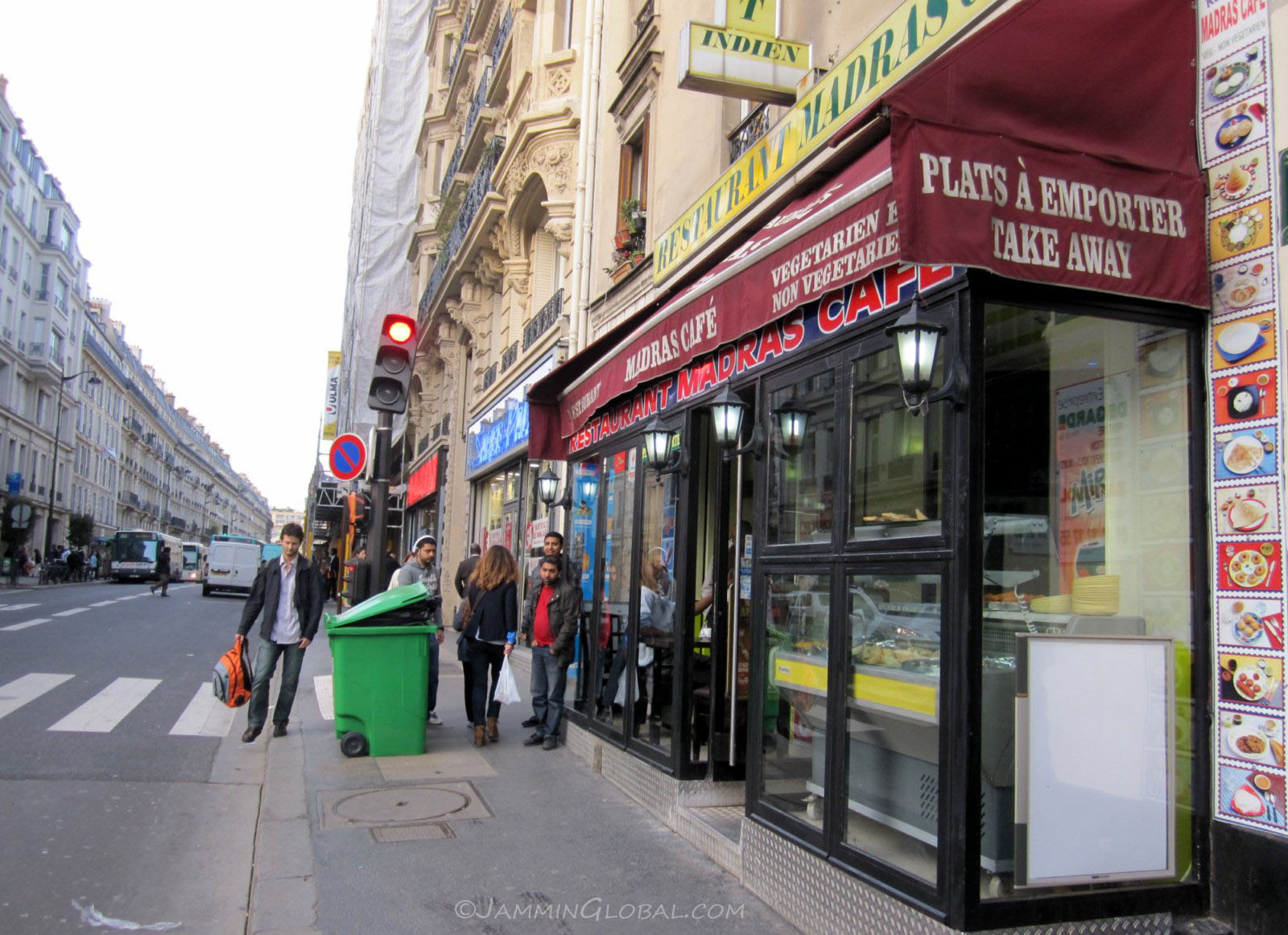
Florence lived near Gare du Nord (the main railway station) and her flat was conveniently located right above Madras Cafe. This part of the city is known as Litte Jaffna, due to the presence of a strong Tamil community from Sri Lanka, who were granted asylum during the 1980s when the civil war was raging back home there. I come from Madras (Chennai), just across the Gulf of Mannar from Sri Lanka and whilst we are both Tamil people, our culture is quite different, including the language. Even if they're Sri Lankan, restaurants usually get Indian names, since they're considered to be more easily recognizable. In the same vein, most of the Indian restaurants in the world are run by Pakistanis, Bangladeshis and even a few Indians.
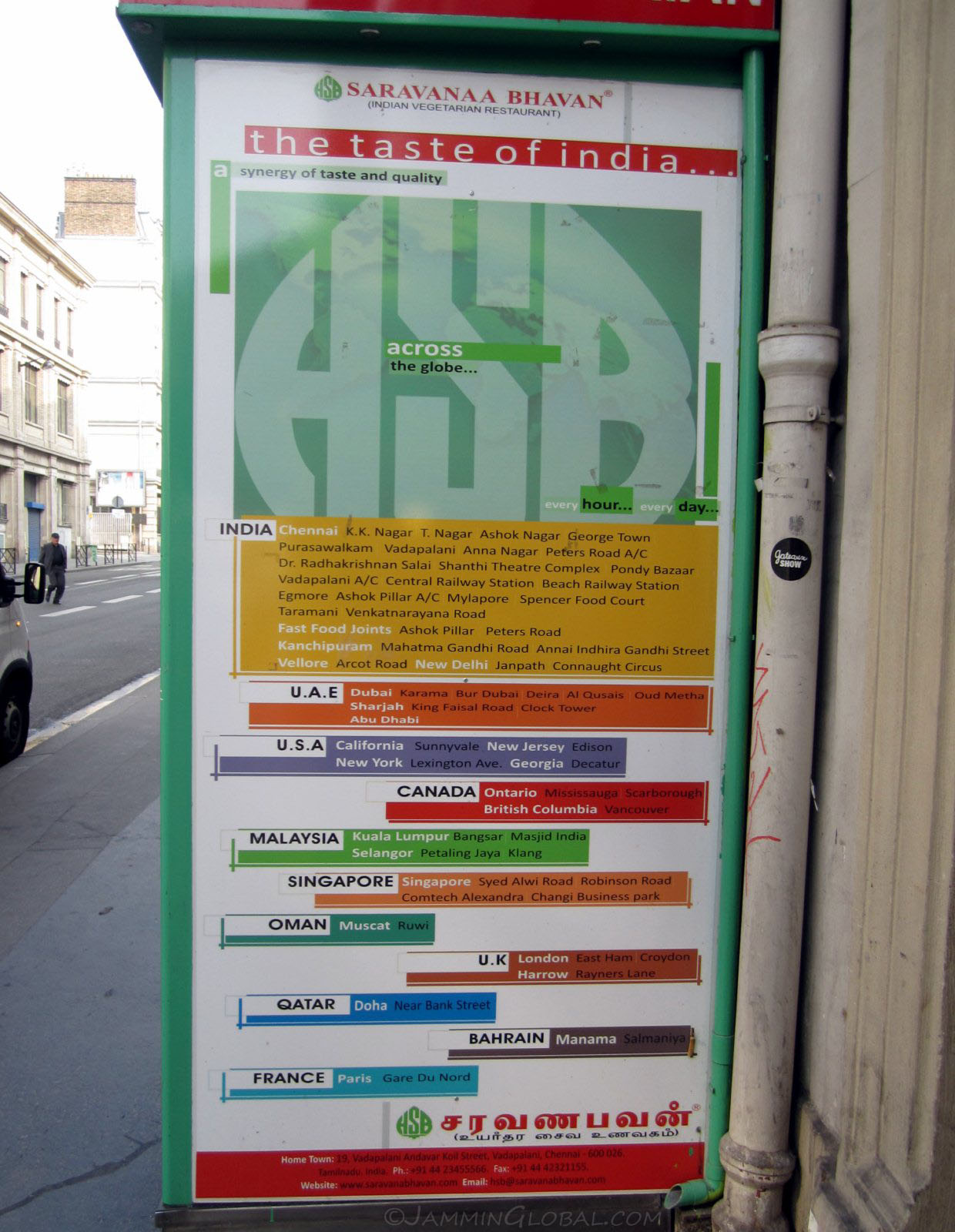
Right next door was Saravanaa Bhavan, a chain of South Indian restaurants with branches all over the world. I was as excited to find this place as an American tourist might be upon coming across a McDonald's in Cusco. However, this restaurant has a good reputation back home and is a real treat for South Indians and other lovers of Tamil food.
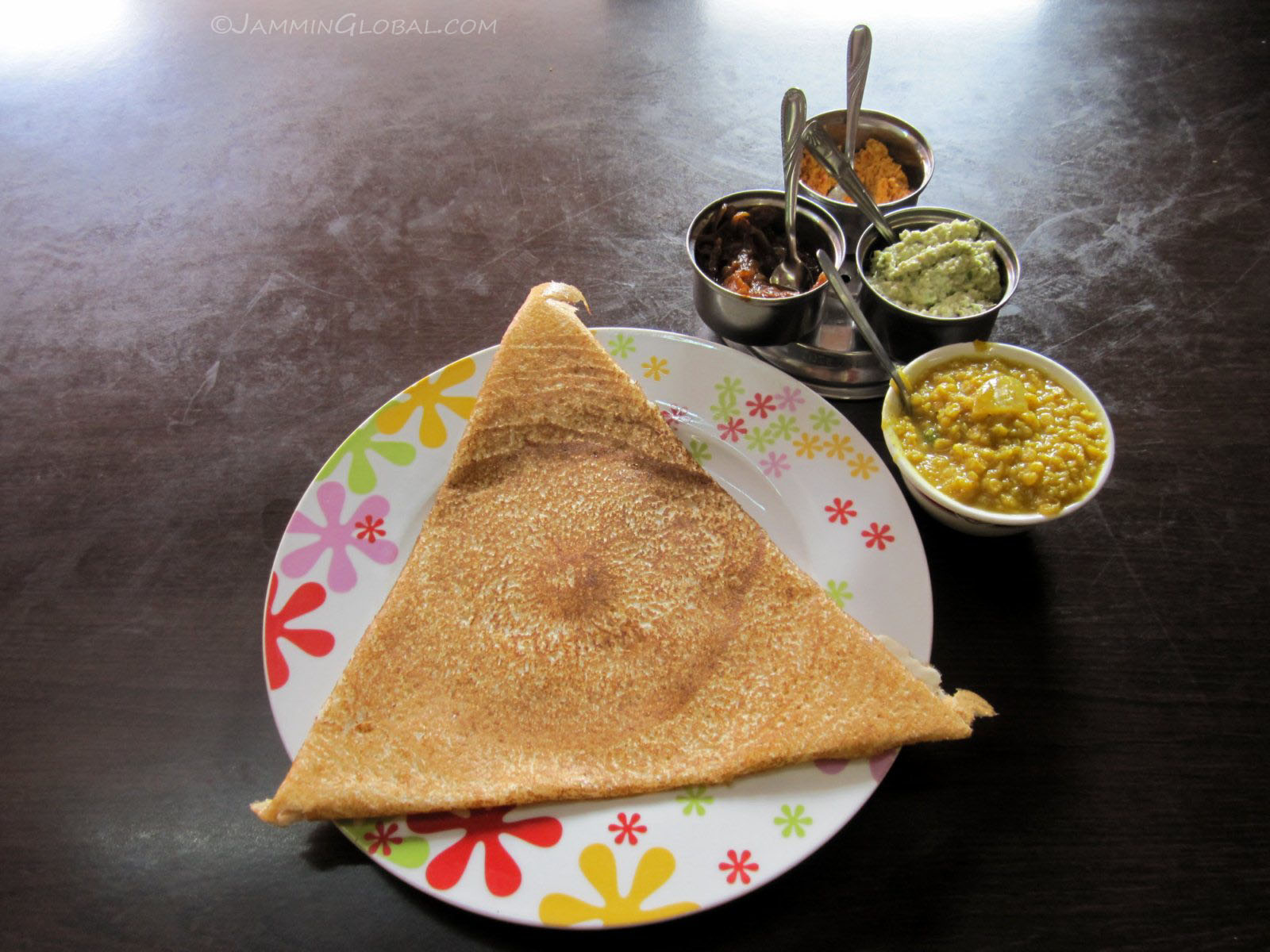
I treated myself to a dosa with an assortment of chutneys and dahl (lentils). This would be a typical breakfast from my mom and I was really craving a dosa, as it had been over a year since I had my last one (back in Chicago). The dosa is a crêpe (thin pancake) made from rice flour and is eaten with savory items, as opposed to a French crêpe, which can be eaten with sweet fillings. There are many different varieties of dosas, with the highlight being the super thin paper dosas that are about a meter long.
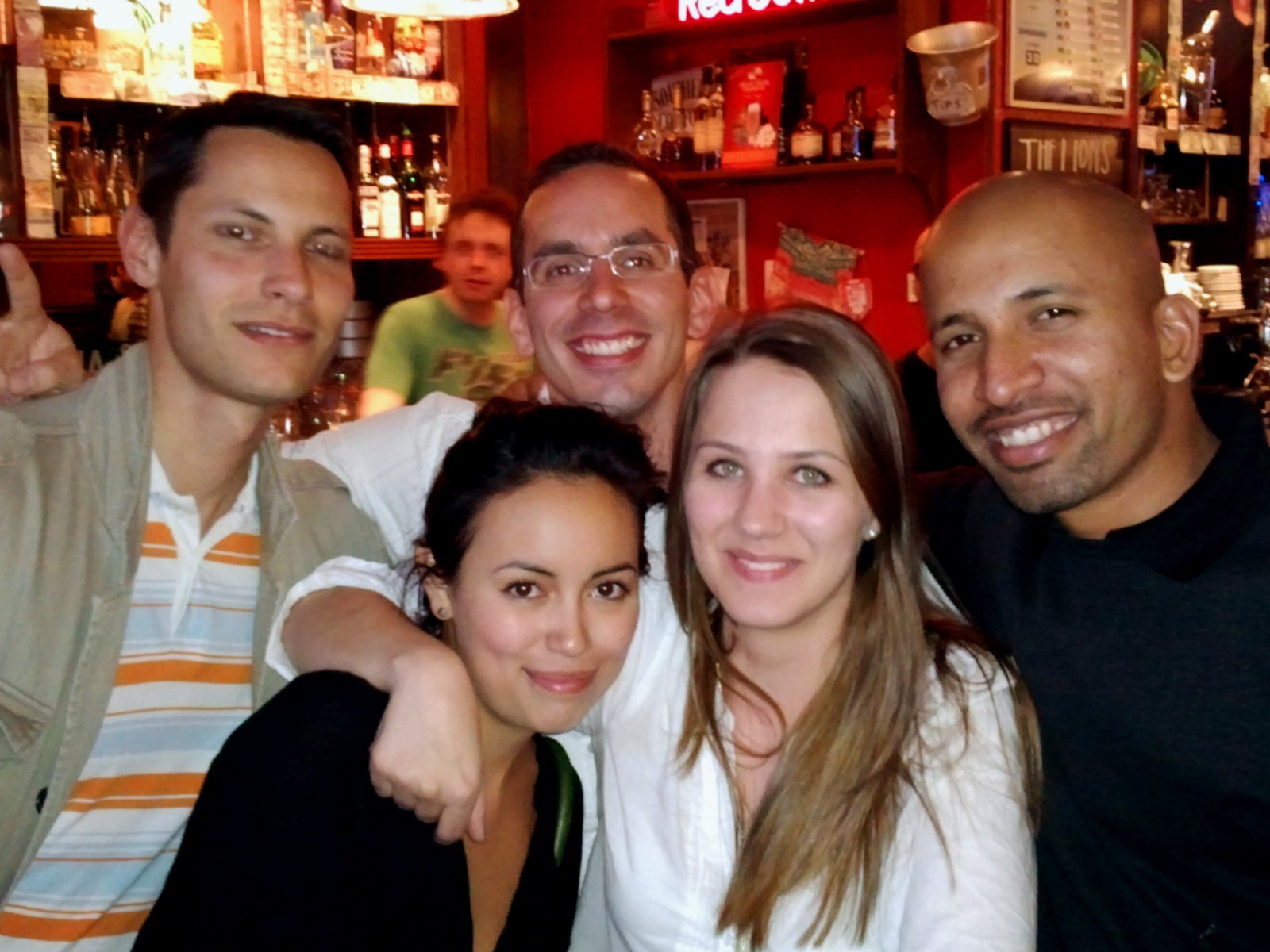
Being an active CS city, there were lots of events going on, like meeting up for a movie, picnics in a park, etc. One of the evening gatherings was a Quiz Night at Lions Pub, where the whole bar is taken over by CouchSurfing. Teams of CSers have to identify the names of strange songs and movie trivia with the winning team getting a bottle of vodka (we won once!). I became good friends with Uwe and Christophe and we chatted up these au pairs one evening. Christophe is from Le Mans, working for Renault outside the city near Versailles and he had similar aspirations to travel and was plotting his own path to get there. Uwe is a German mechanical engineer, who moved here recently and after exchanging good vibes, he invited me to stay for as long as I wanted.
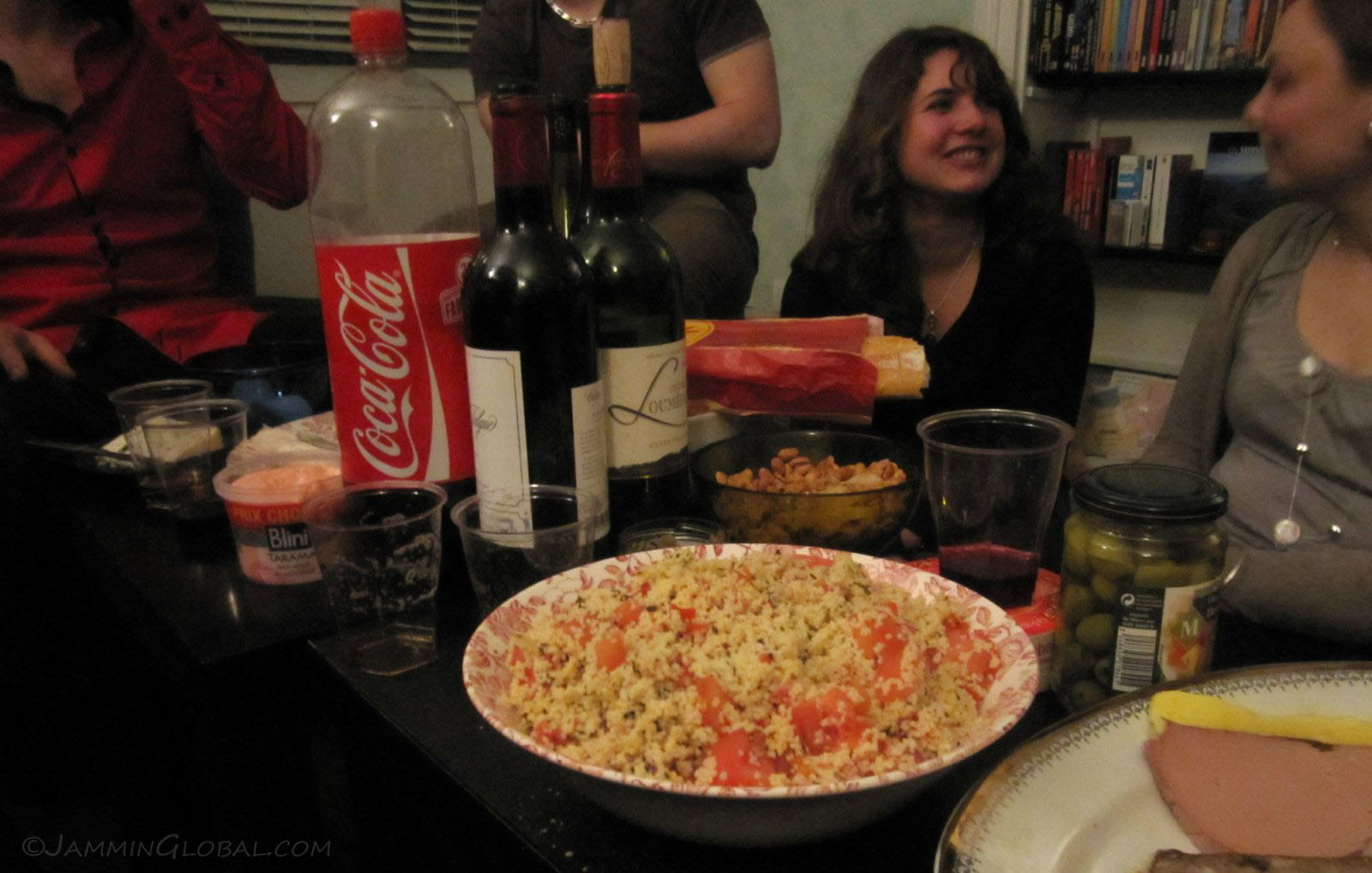
Christophe had a house warming party for his new flat in Versailles and invited a bunch of CouchSurfers. This is tabbouleh, a salad from Syria and Lebanon, made with bulgur wheat, parsley, mint, tomatoes and onions, with lemon juice and olive oil. Good healthy eats.
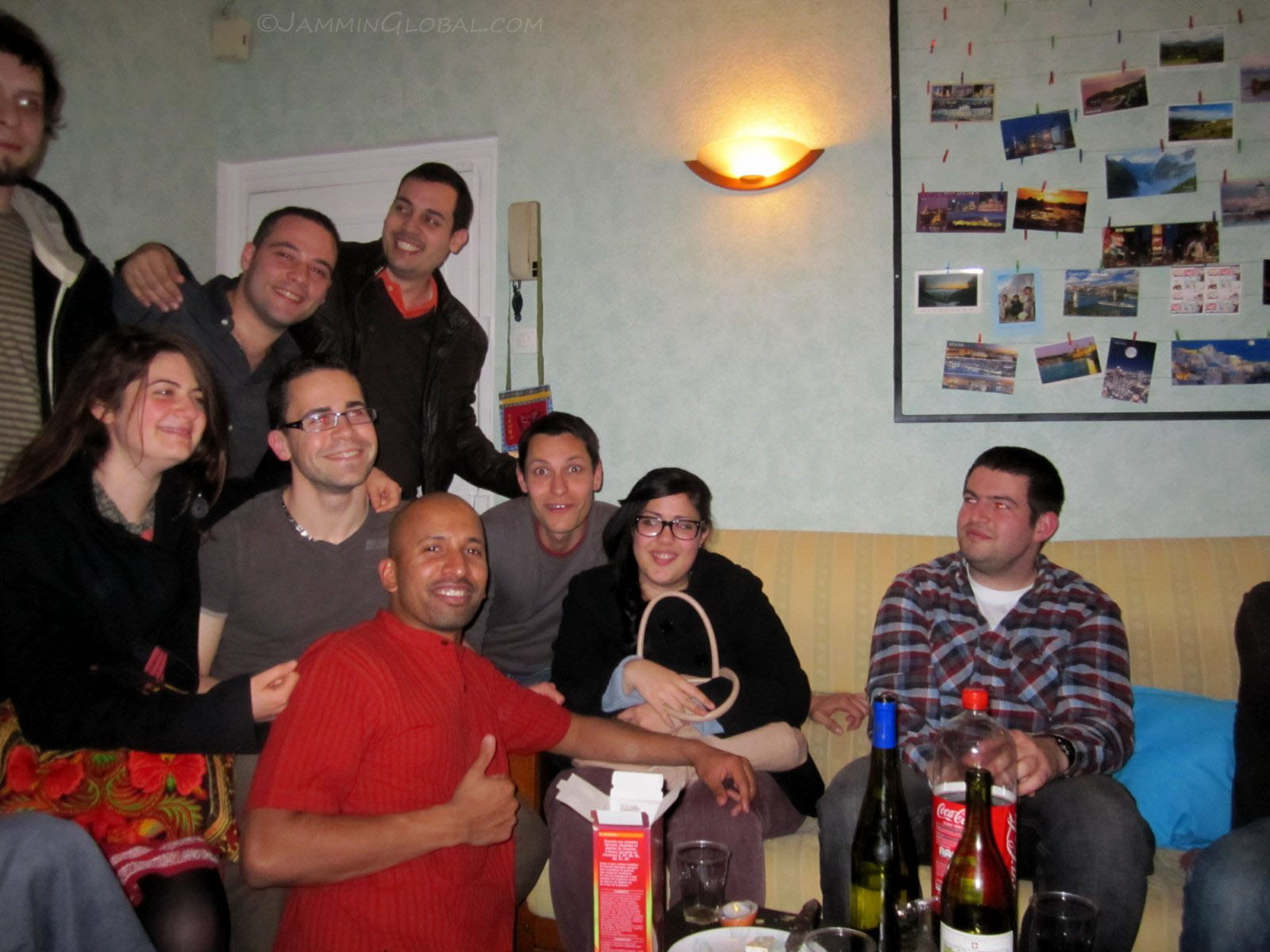
A shot of one side of the party.
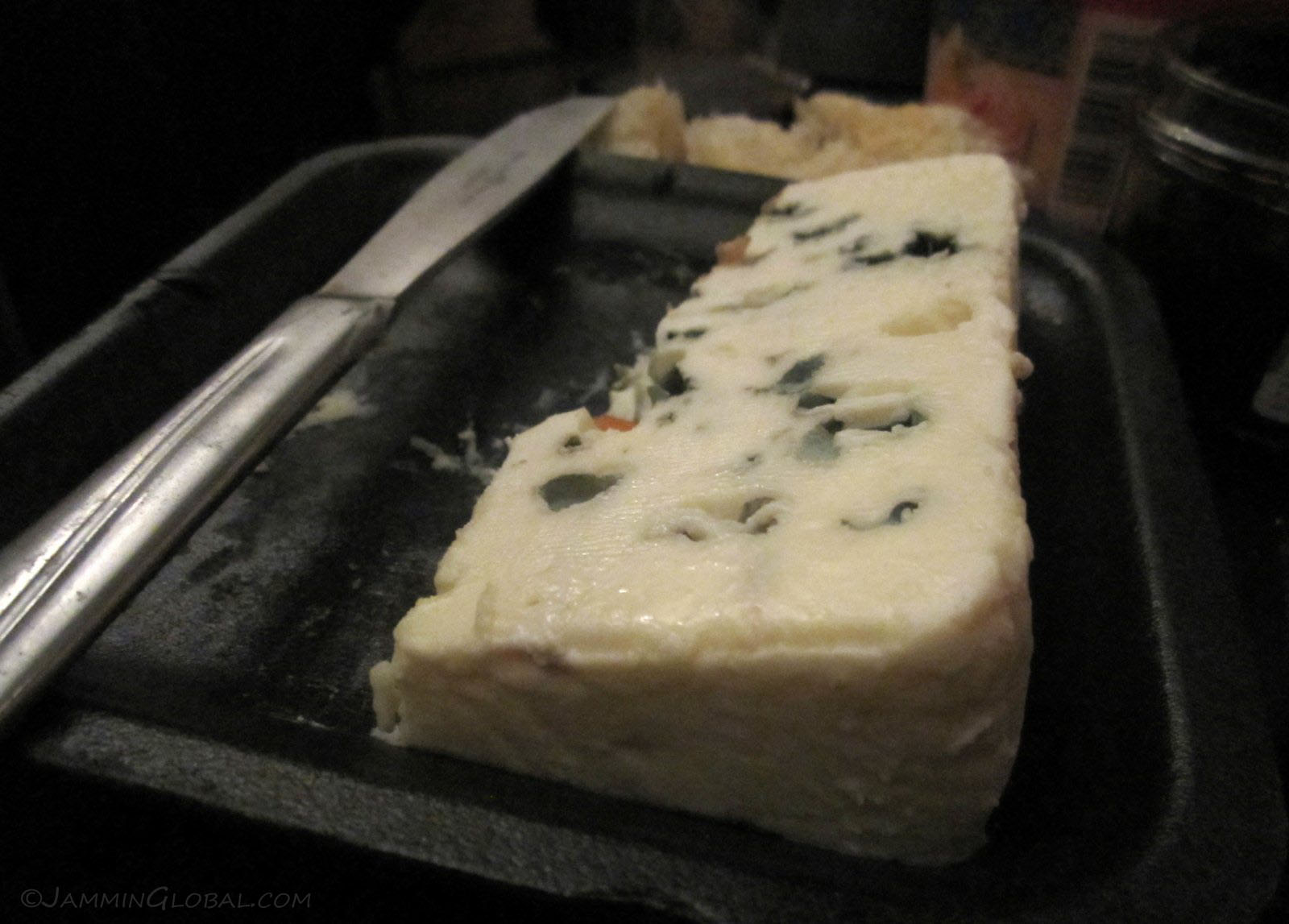
A slice of Roquefort (Bleu Cheese) that the French eat like butter. The distinctive flavour comes from the green Penicillium mold in the cheese, which was used as an antibiotic before the medical benefit of penicillin was discovered. I never liked the taste in the US, but here, it went down a lot smoother and I was actively seeking it out.
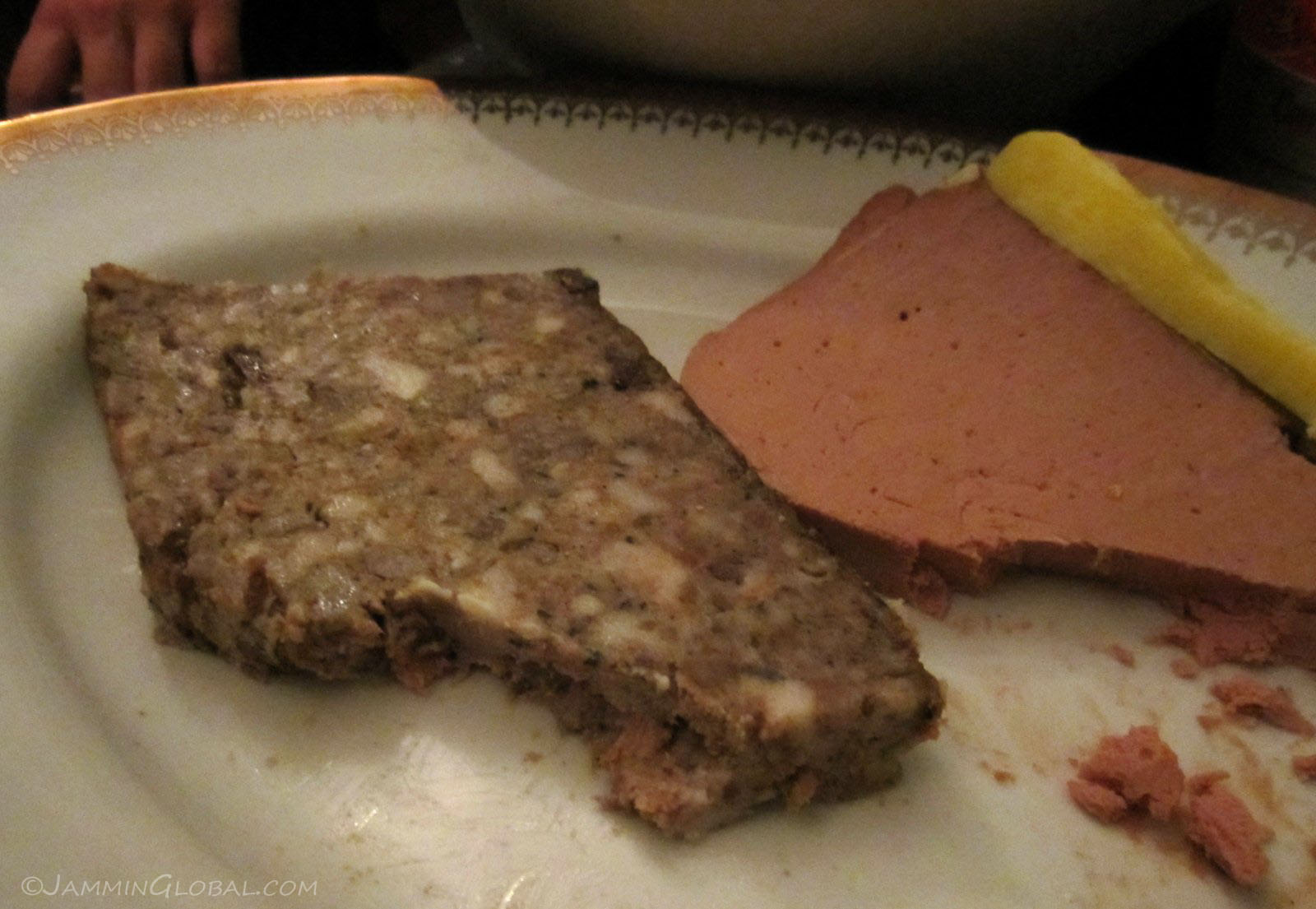
Duck liver pâté.
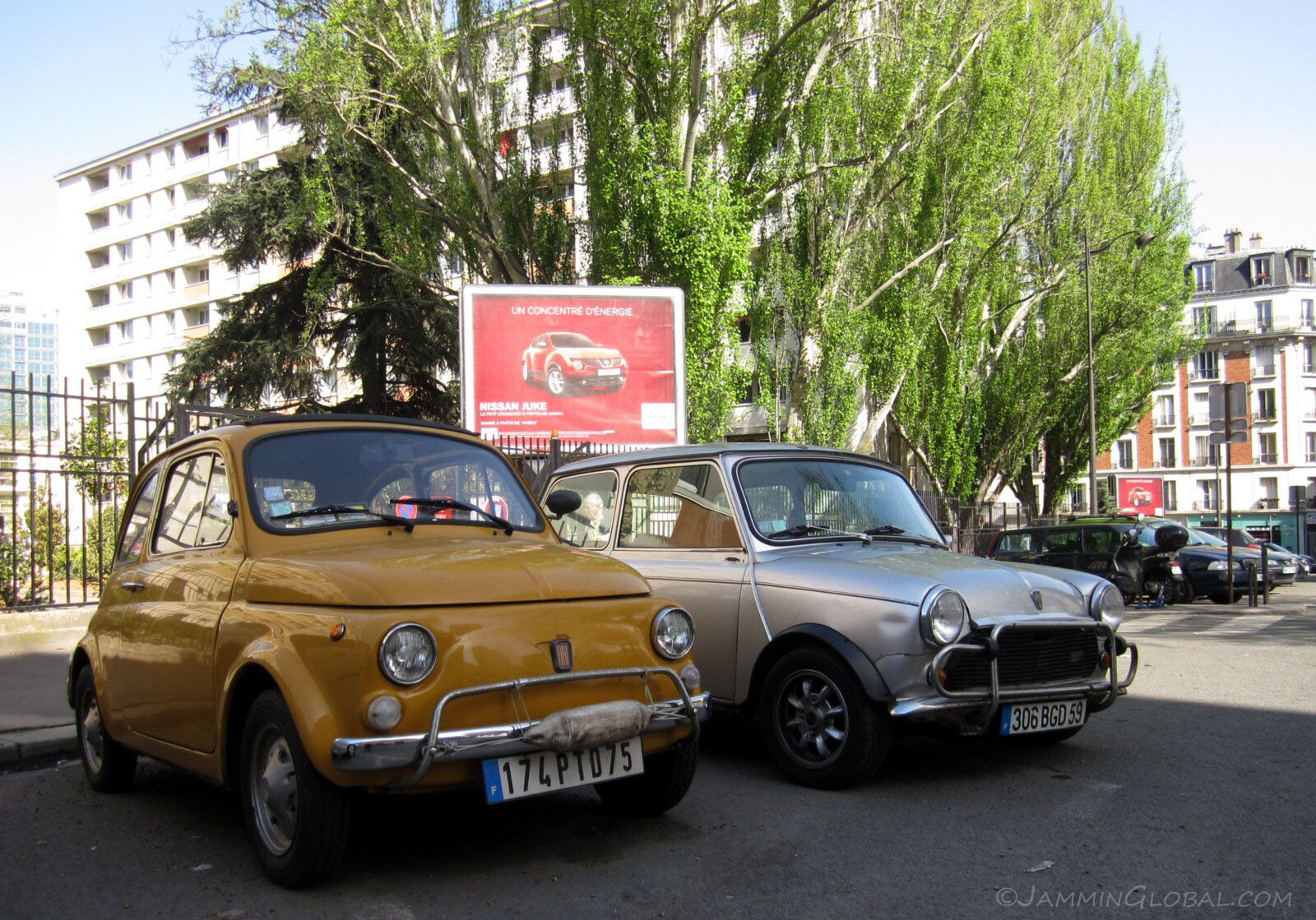
A cute shot of classic, tiny European cars: the original Fiat 500 and the original Mini Cooper. Both cars have been revived with the new Mini Cooper already being a success story.
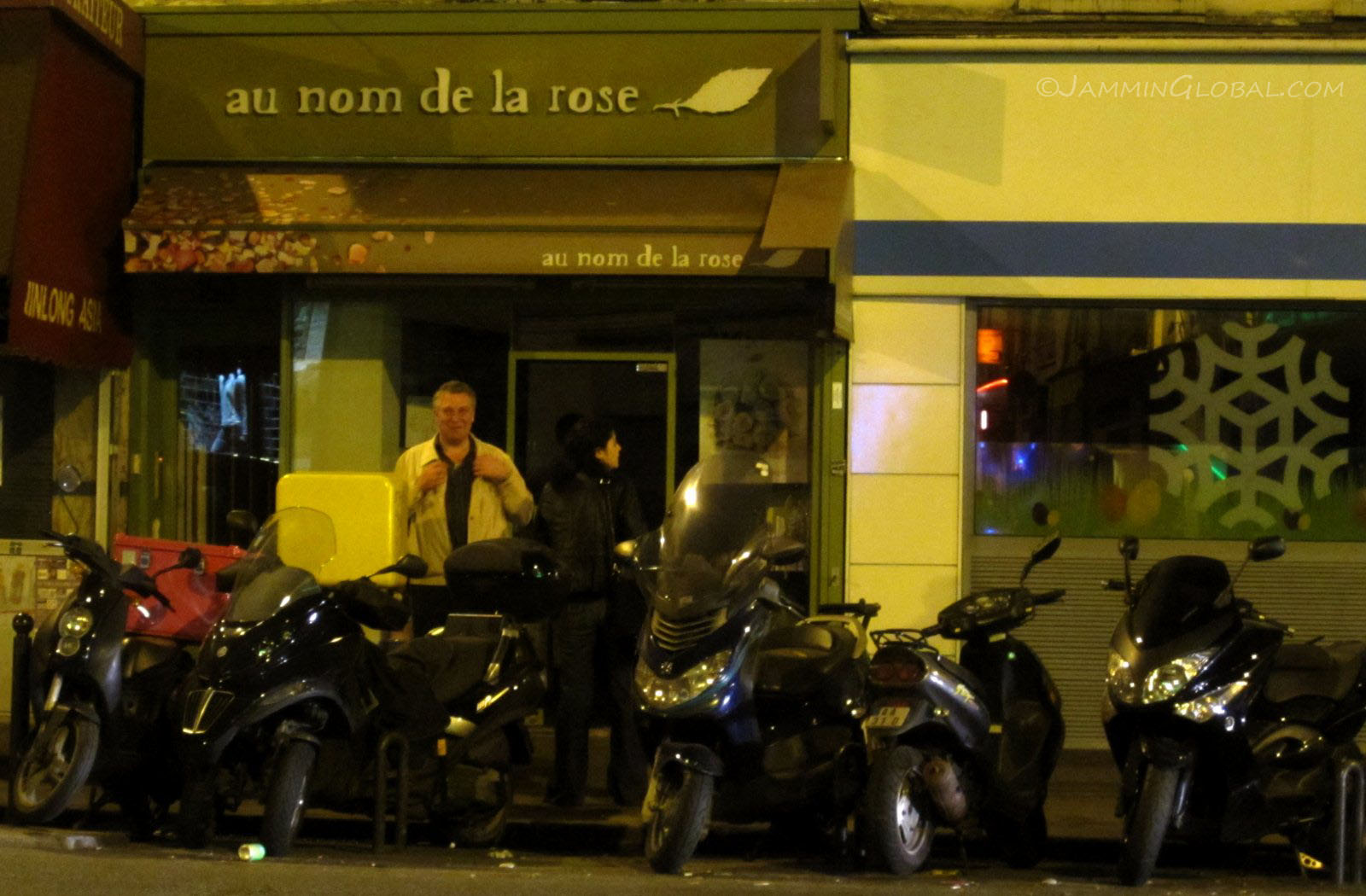
This was the name of a French song I liked for many years since India and was pleased to see it as a store name. Also, if you see the scooters parked out front, the one with the two front wheels is a very popular model here, since there is a loophole in the law that if the front tires are separated by a certain distance, then a motorcycle license is not needed to operate the vehicle and just a car license will do.
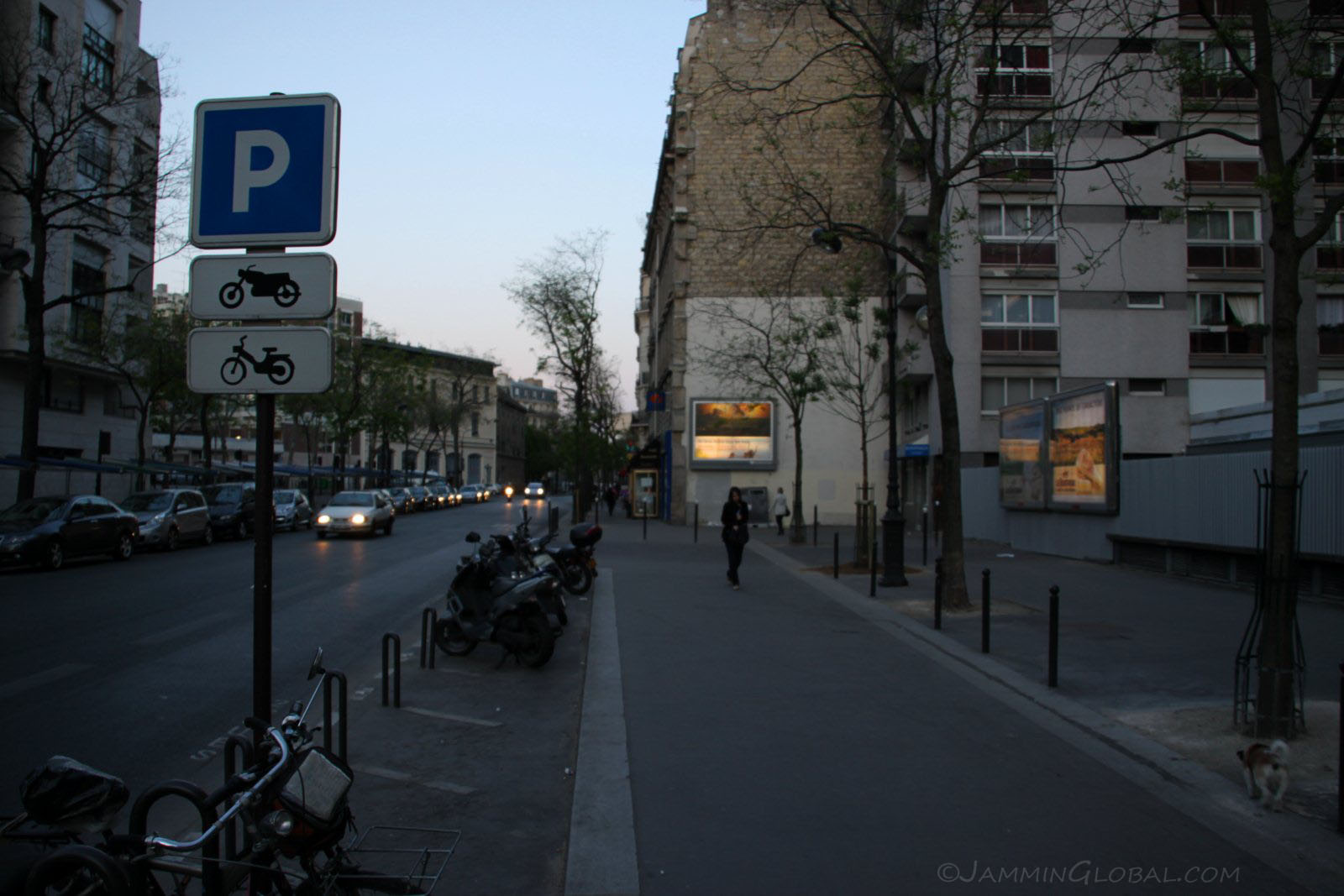
Motorbikes can park right along with bicycles. I was liking this laissez-faire approach to two-wheelers.
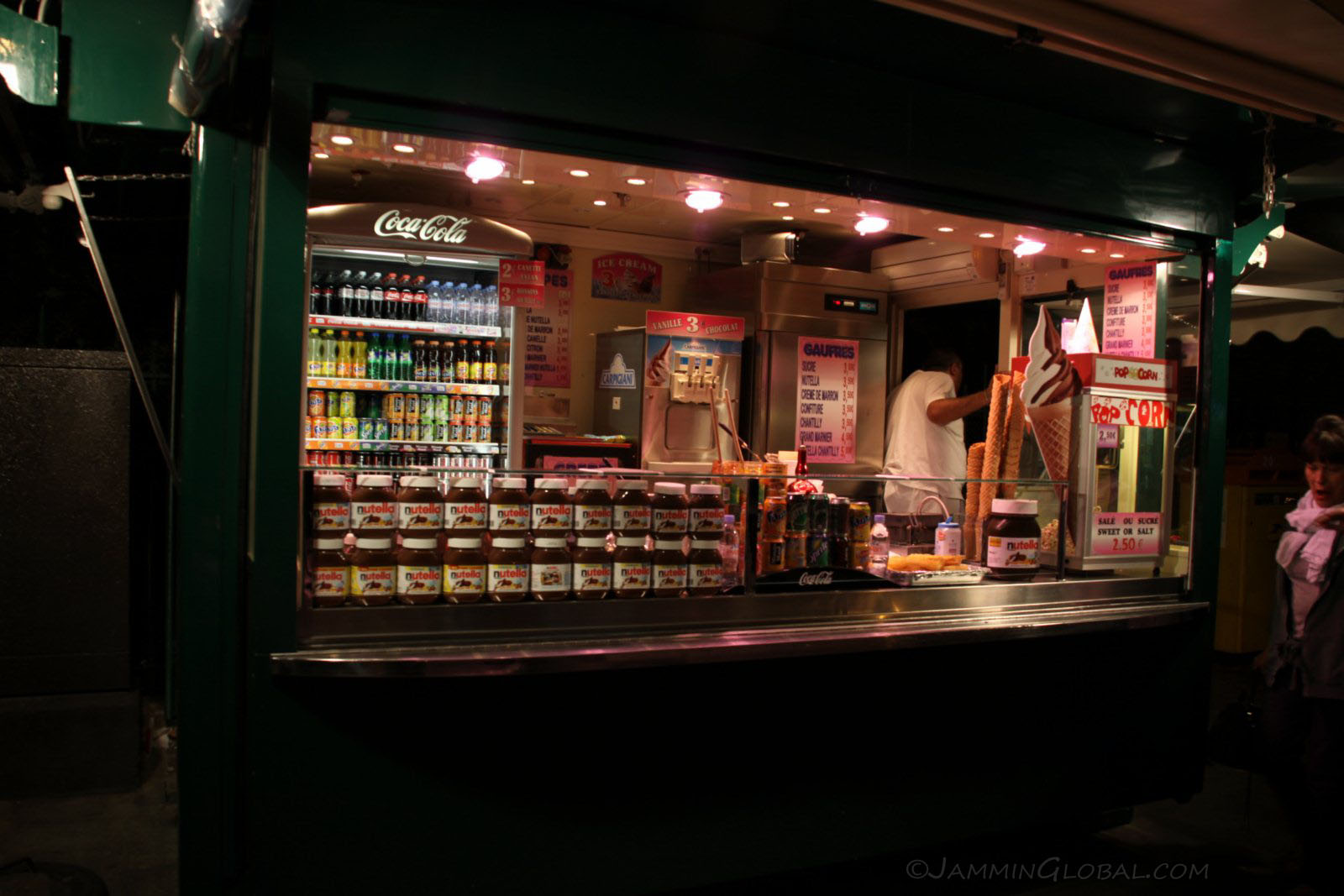
A French crêperie, making Nutella stuffed goodness.
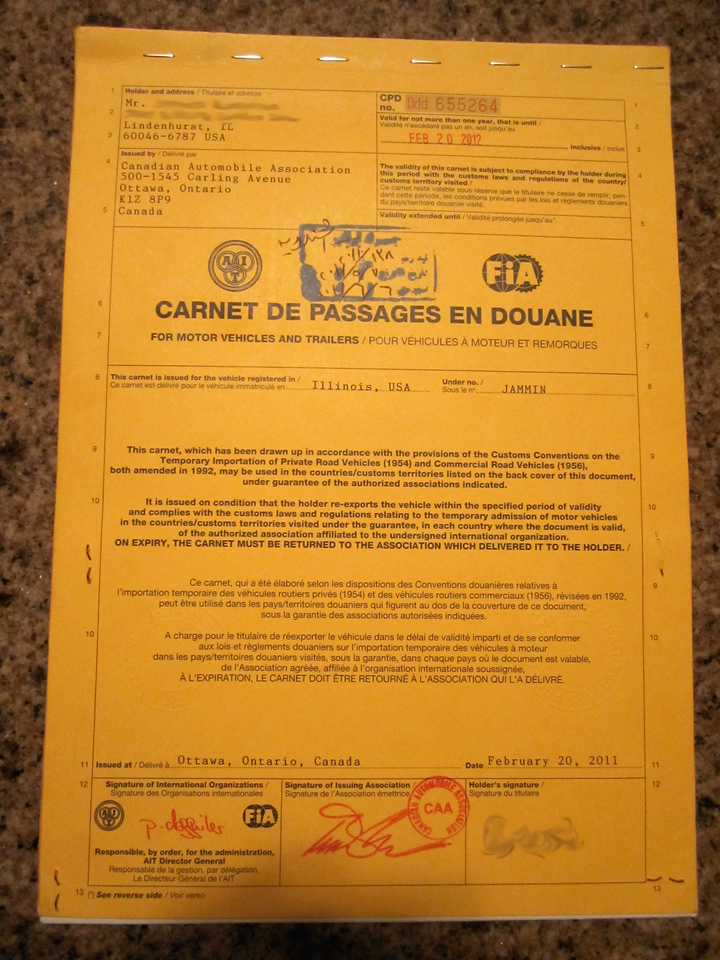
Regarding my paperwork, after a long wait, Morocco refused to give me a tourist visa, saying that I could only apply for one in my home country and couldn't do anything for me since I didn't live in Paris. I told them many other countries said the same thing (Brazil, Chile, the EU) but upon seeing that I was traveling overland and it wasn't practical to get all the visa beforehand, they made an exception, but nope, no dice with the Moroccan consular. I could've gone to another city, maybe Madrid, to have tried there, but I think it would be the same answer and besides, by now, I was going to be heading into the thick of the west and central African rainy season, so I changed the plan to heading down the east side of Africa. To do this, I would need to enter in Egypt. For Africa, a carnet de passage is needed (or makes life easier) when temporarily importing the bike and each country has its own rate with Egypt being the most expensive. I wrote all about the carnet here.
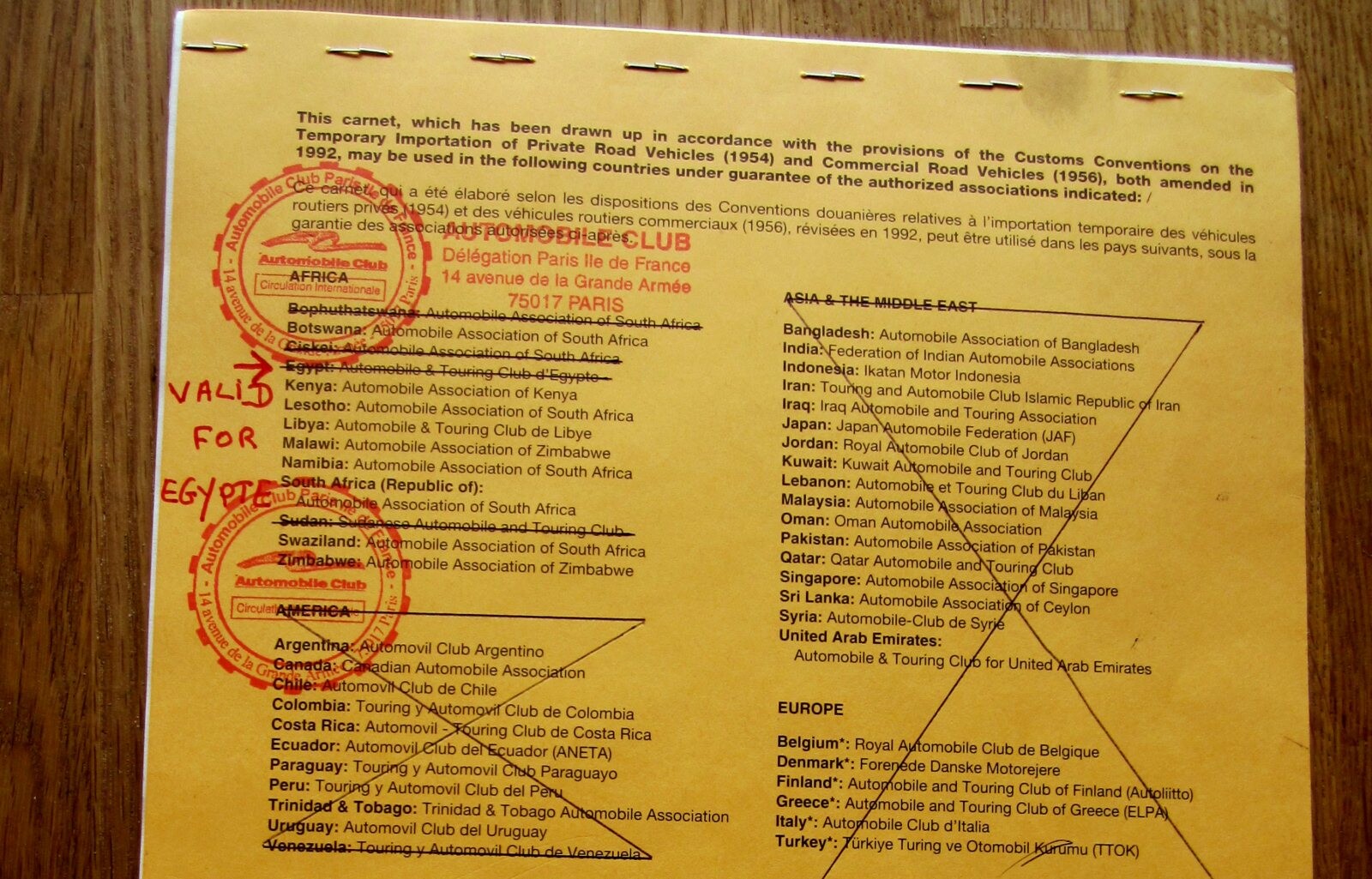
Since I didn't plan to pass through Egypt till much later, I had to wait another 10 days to get my carnet approved for use in Egypt. The French Automobile Club was very helpful is taking care of this for me.
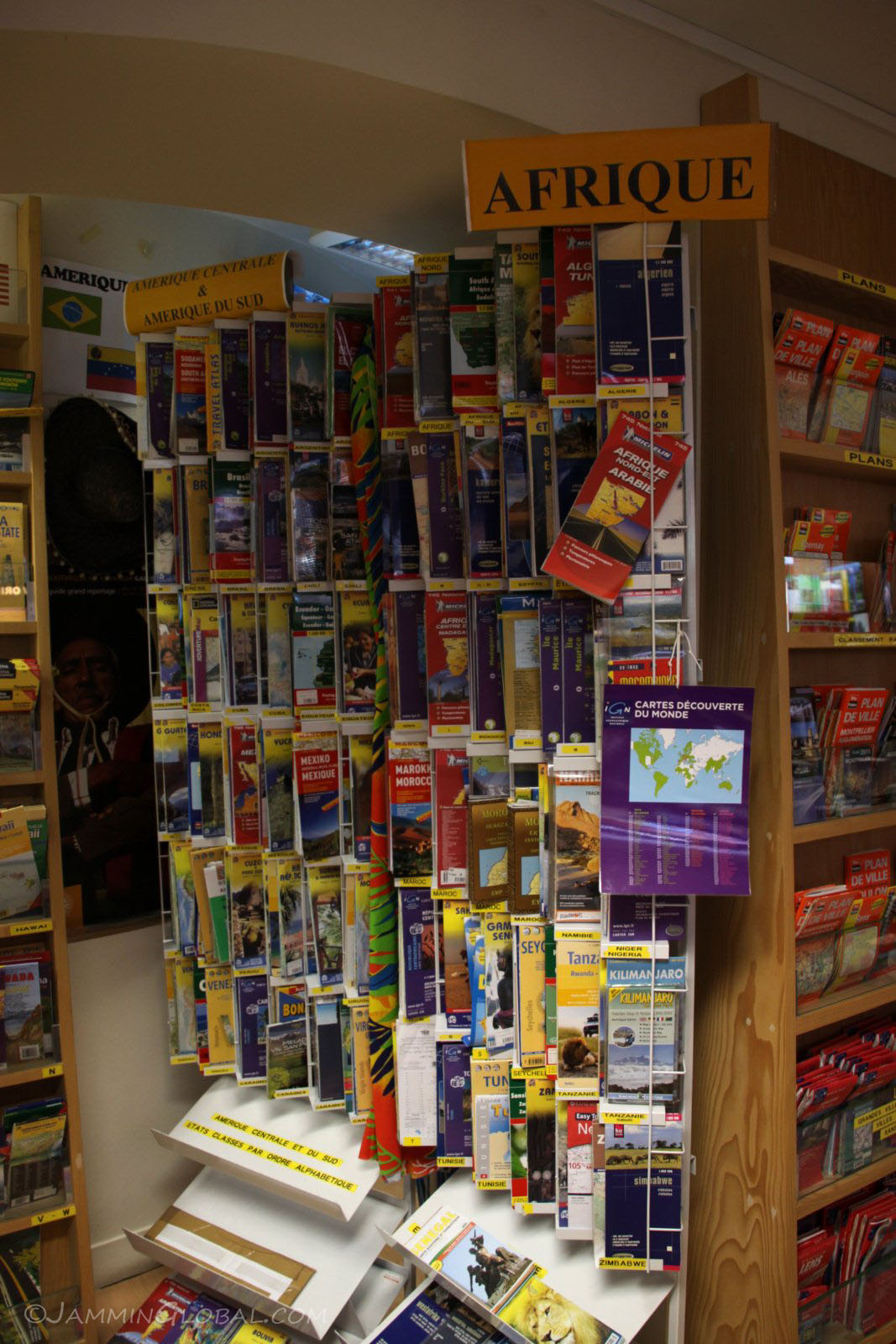
The most recommended paper maps for Africa are the ones made by Michelin and three separate maps cover the whole continent. I had No. 741 and No. 746 for west and southern Africa, but needed to get No. 745 to cover the northeast and I found this bookstore (Librairie Eyrolles) which had the whole basement dedicated to travel books and maps. This whole section was just maps of Africa, with detailed country level maps.
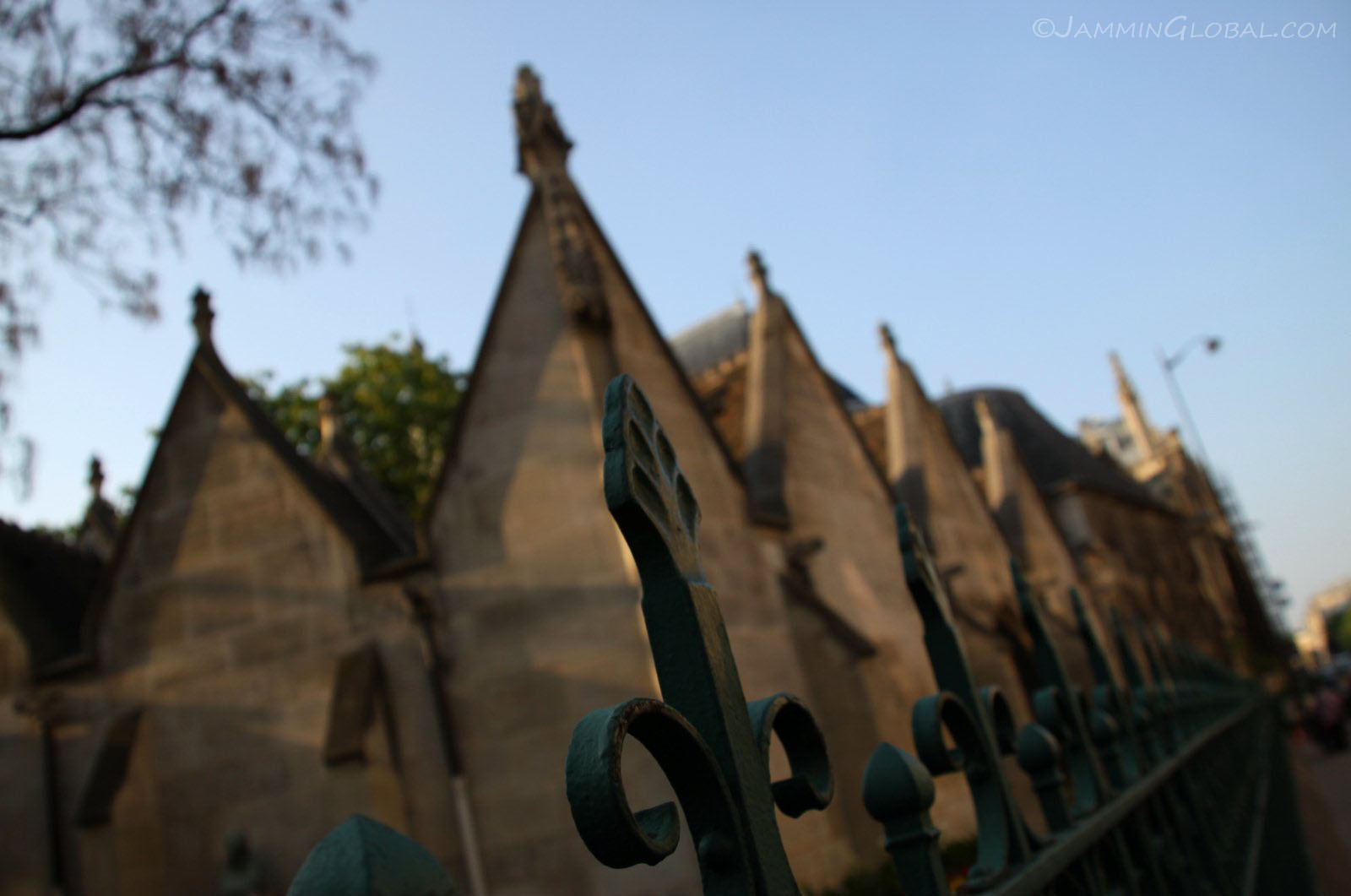
Getting to know my new camera and walking around Paris provided me with ample photo opportunities. This is the Église Saint-Séverin in the Latin Quarter of the city. The church was started in the 11th century, but didn't get finished until the 15th century. That shows how old the city of Paris and this area is, going back to Roman occupation. Beyond that, it has been inhabited from 4000 BC onwards.
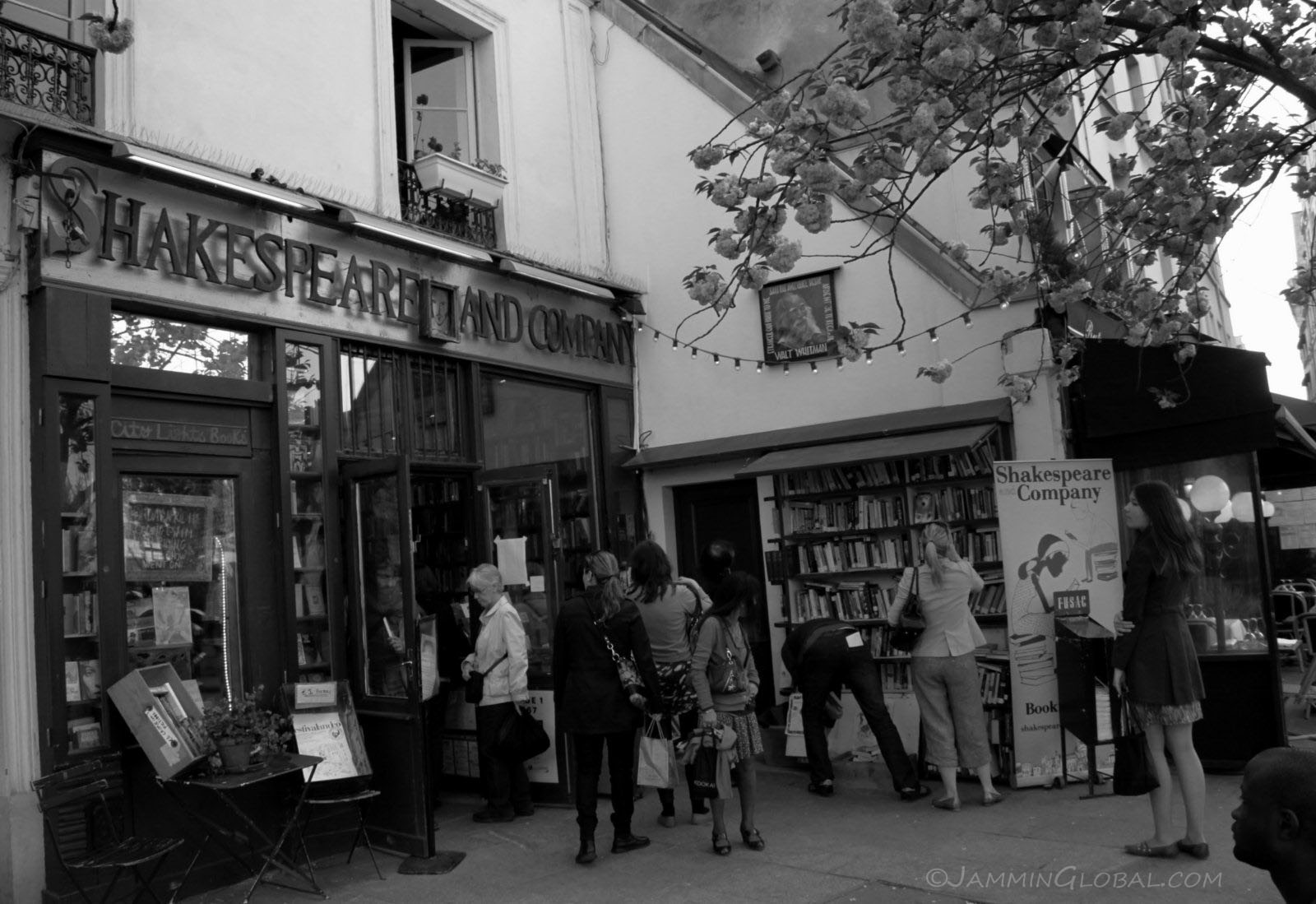
The popular Shakespeare and Company bookstore, which was also featured in the movie, Before Sunset. The original store and reading library were setup in 1911 and till today it keeps to its original creed of giving a place for young writers to stay and work.
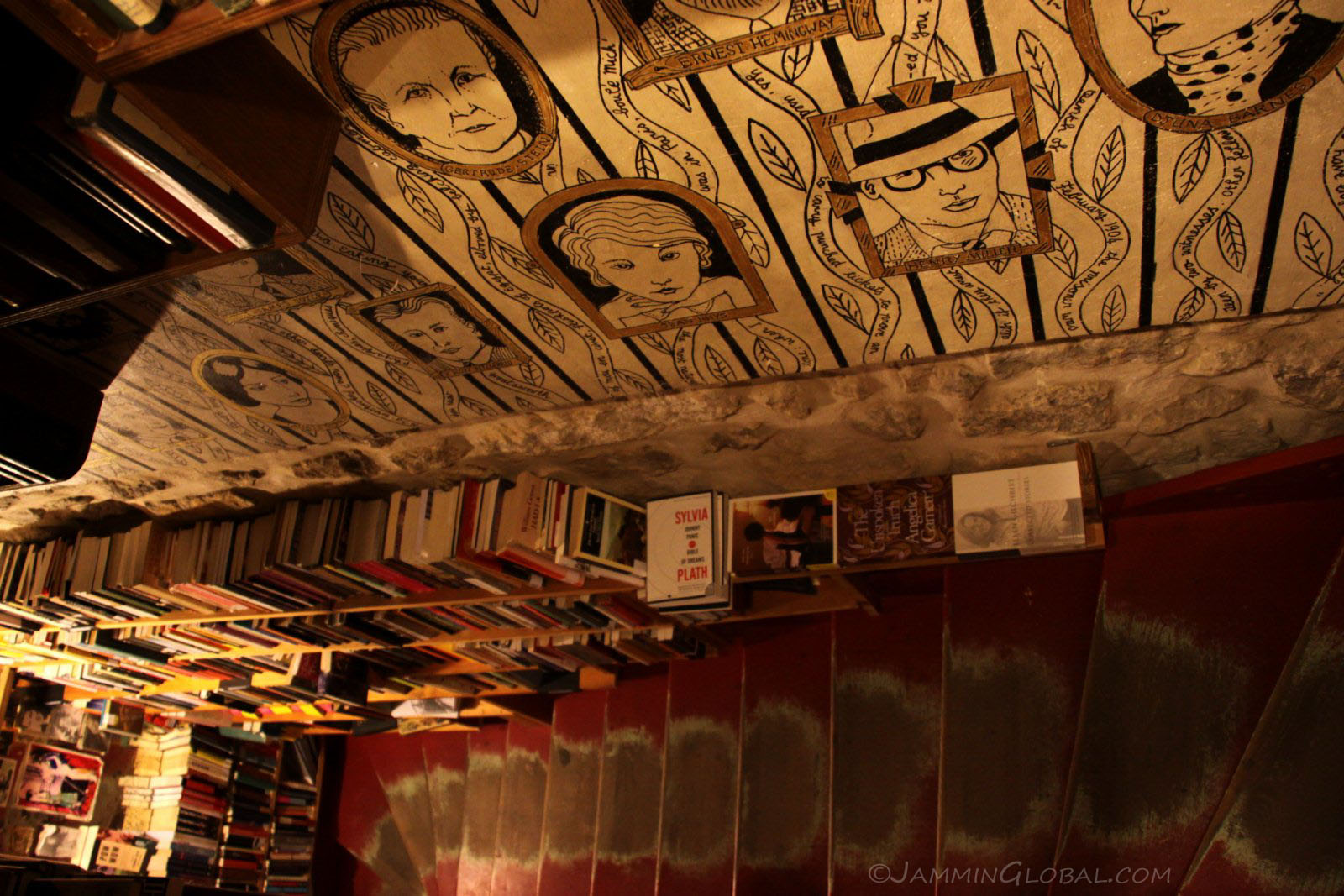
The bookstore is very charming, like numerous others around the city with spaces to sit and read in various nooks and corners.
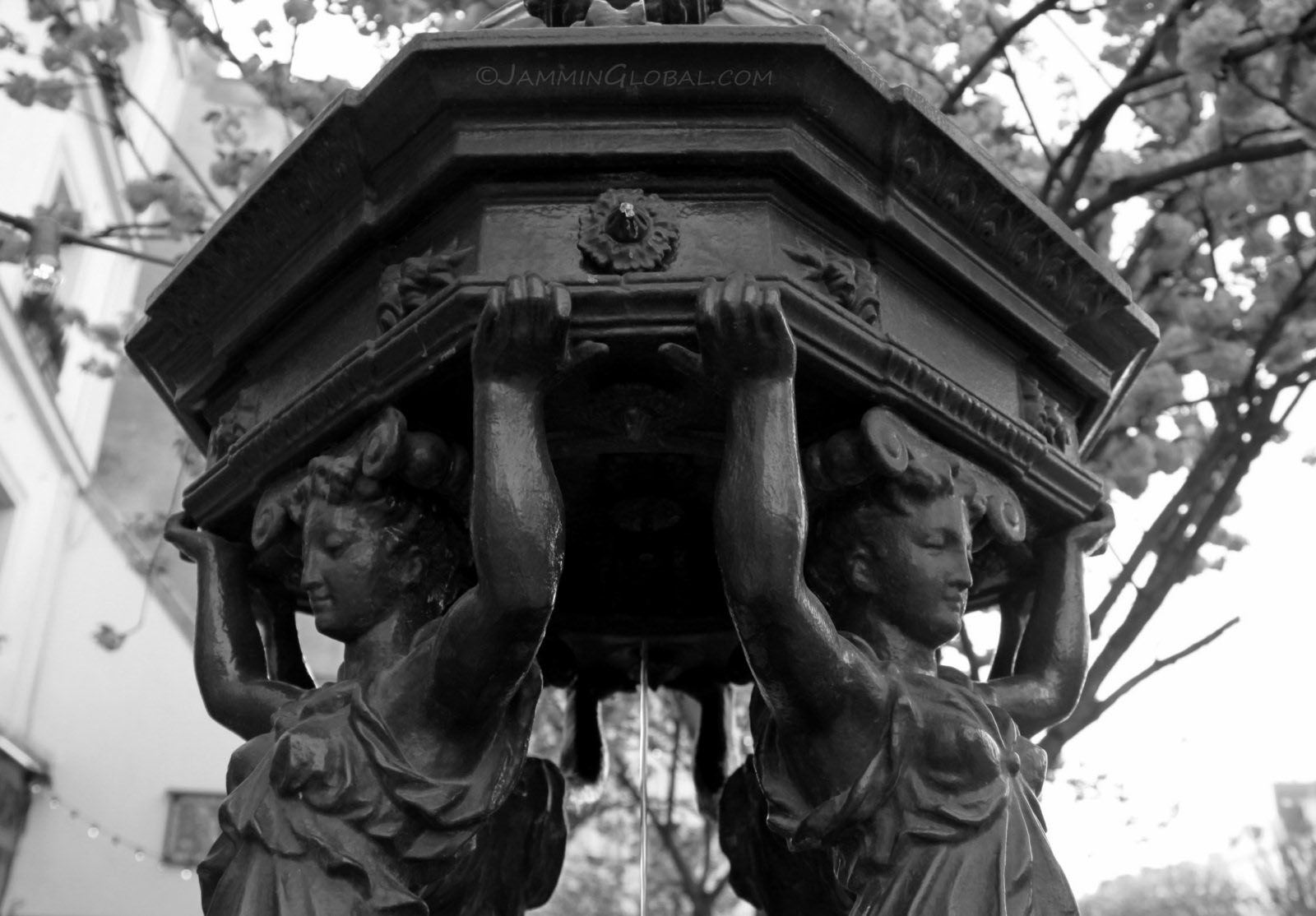
A water fountain outside the bookstore and across the street from...
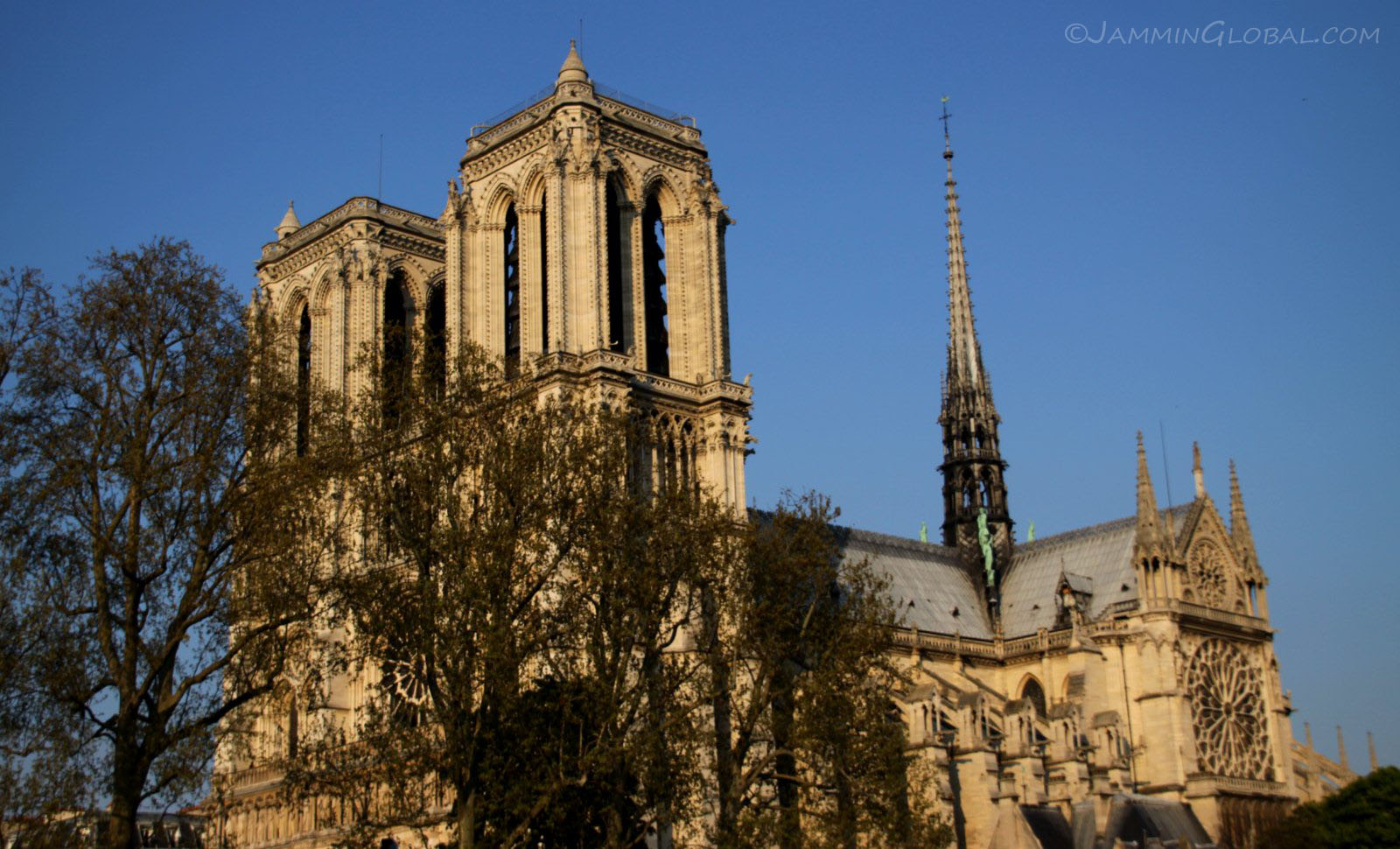
...Notre Dame de Paris, the grand cathedral on the Ile de la Cité, surrounded by the River Seine. It's considered the finest example of French Gothic architecture. Construction started in the 12 century and it was completed by 1345.
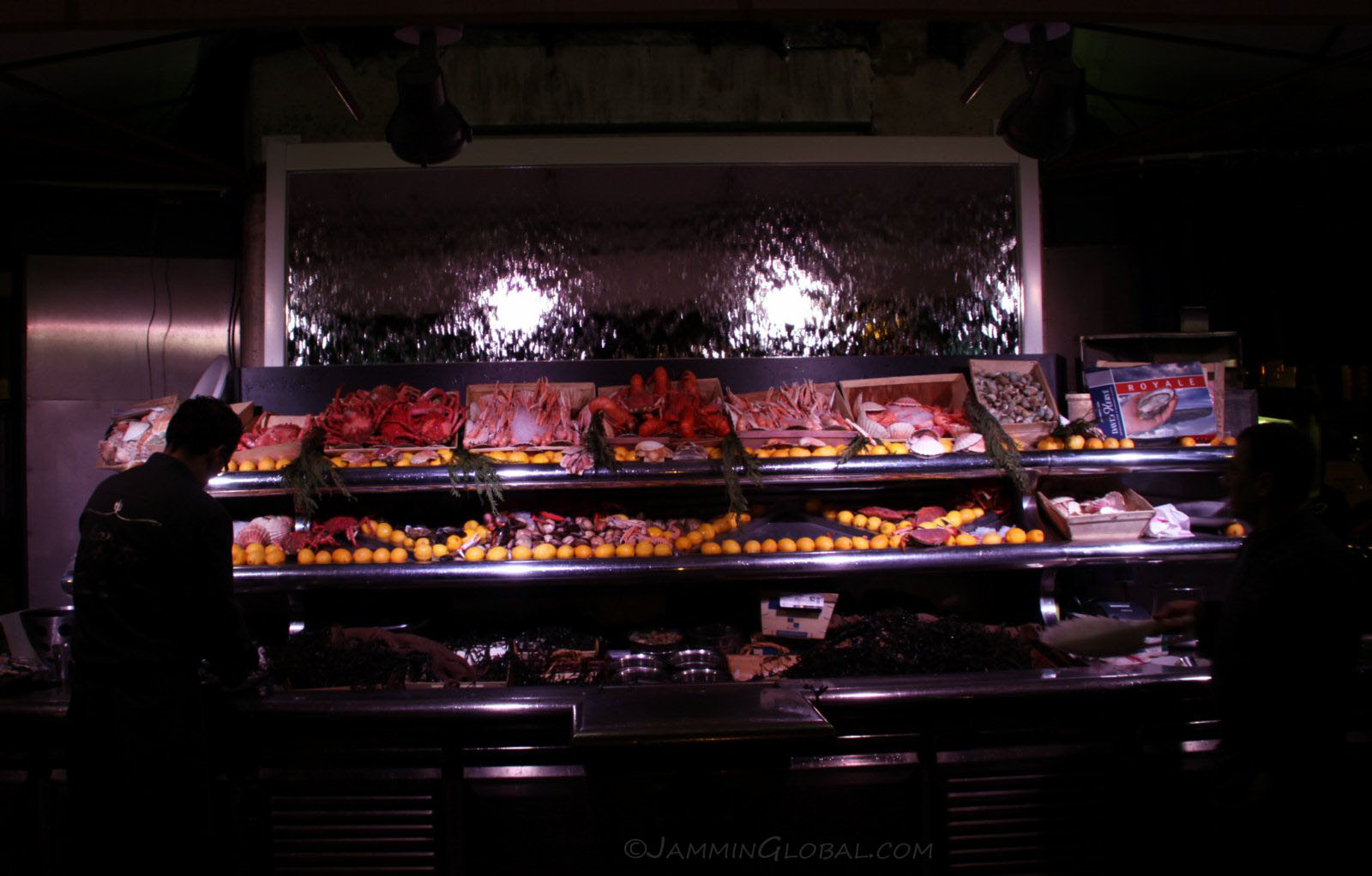
A fresh seafood stall at night.
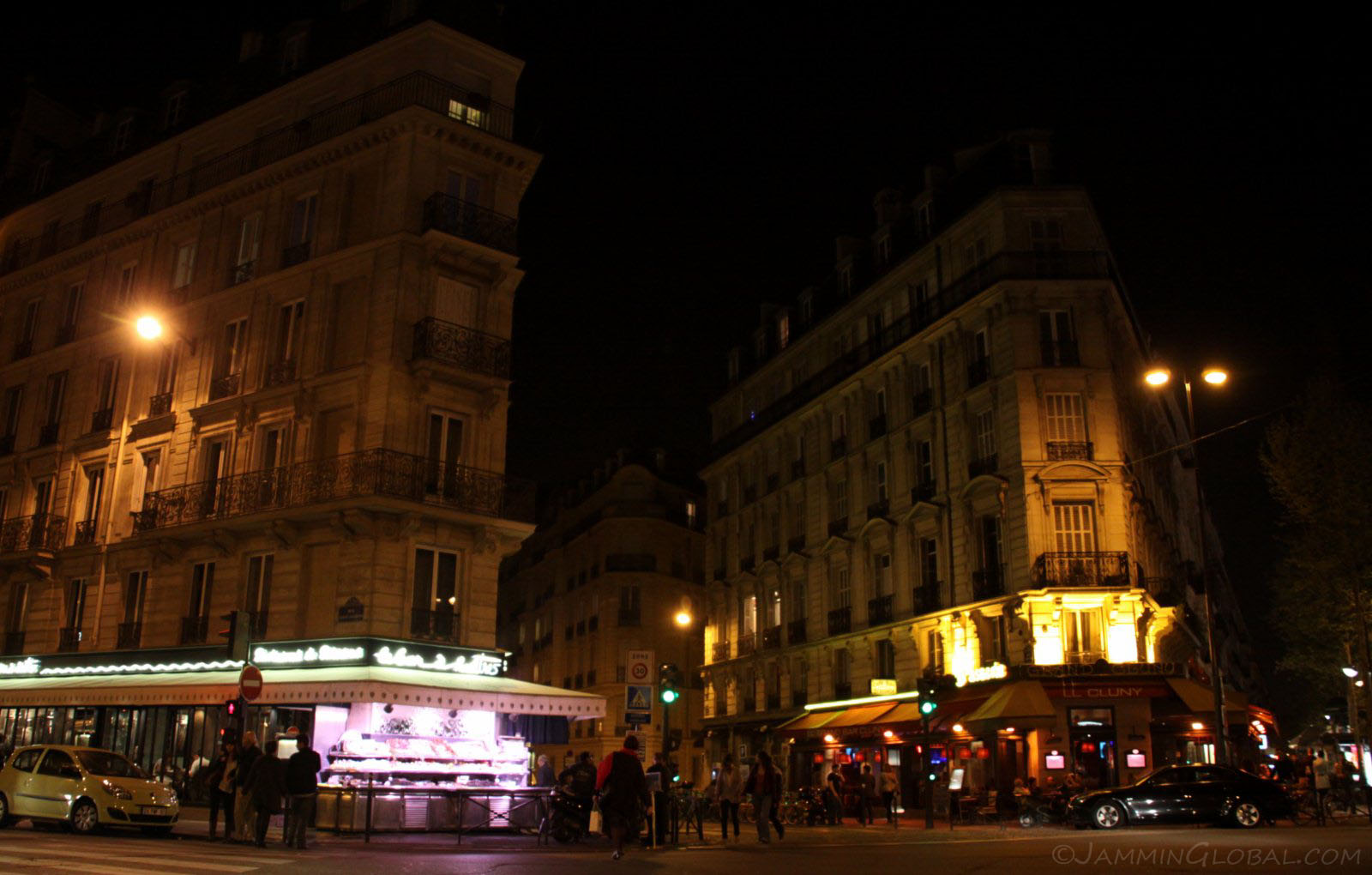
A street corner displaying the signature look of Parisienne buildings, which were dictated by the civic planner, Georges-Eugène Haussmann. Paris is a very old city, but its street plan hadn't changed from the Middle Ages into the 19th century and over-population was plaguing the city with its narrow, winding streets and leading to a low quality of life for its residents. This prompted Napoleon III to finally enact the plan of rebuilding Paris and charged Haussmann to implement it. From 1853 to 1870, the old buildings were torn down and the streets were redrawn to the current wide boulevards and similar looking facades or style of all the buildings in the city. He designed city blocks as a whole, instead of individual buildings by themselves. He's credited with improving the quality of the life in the city, but also stifling creativity with his strict rules.
Next: Europe, Part 2: Paris, The City that Captivates
Previous: Grimaldi, Part 3: Engine Room and Landing in Europe